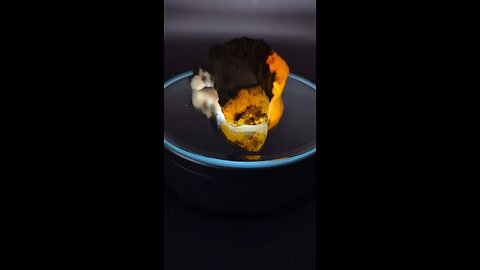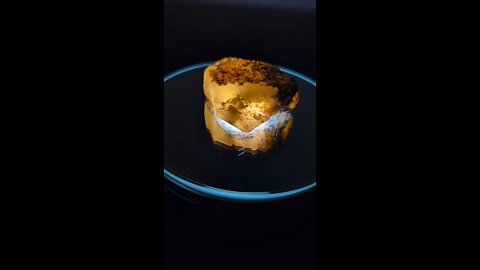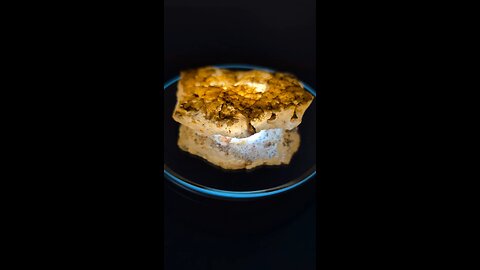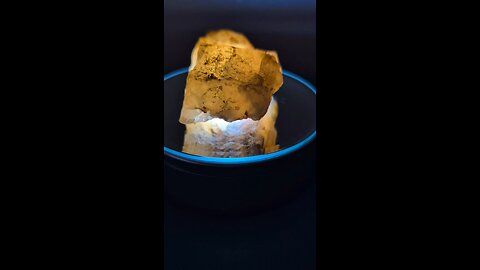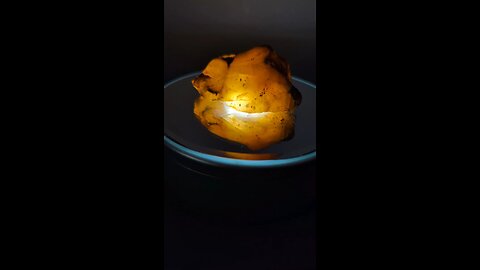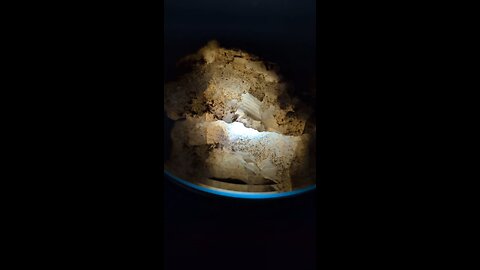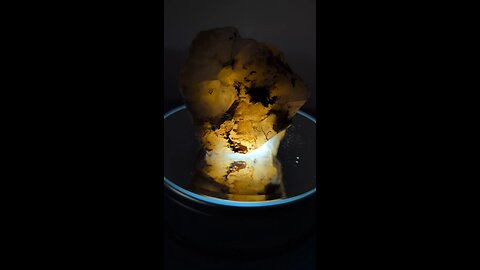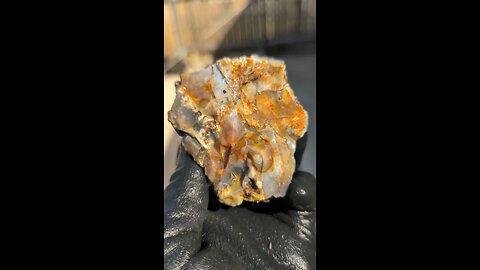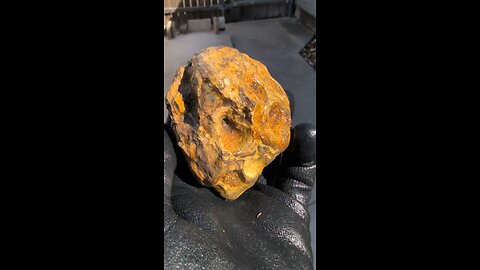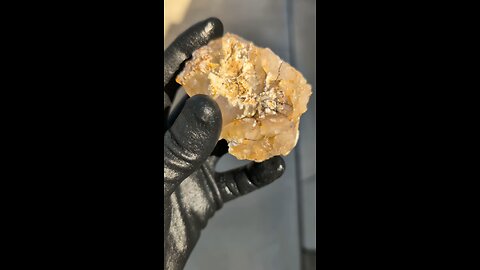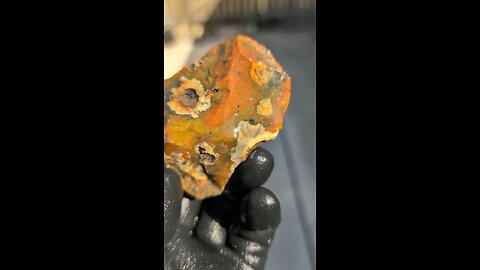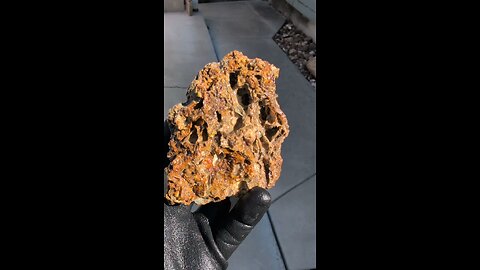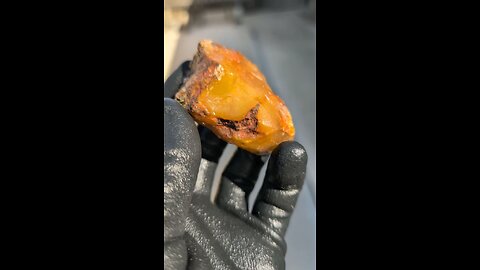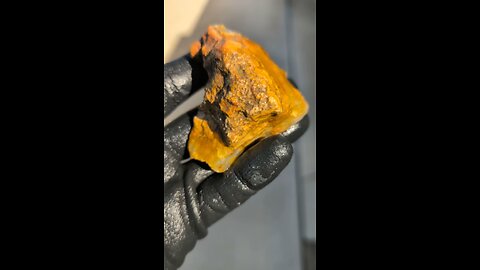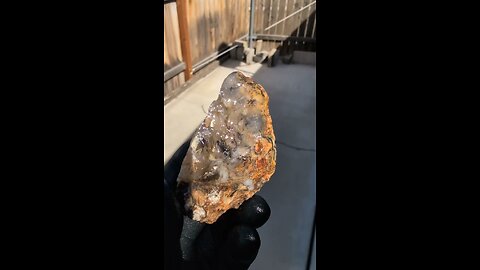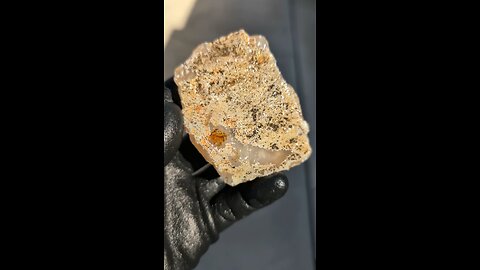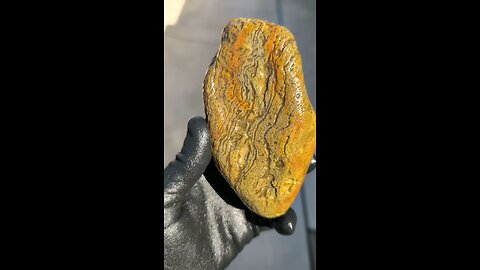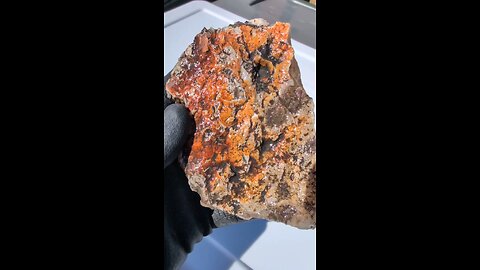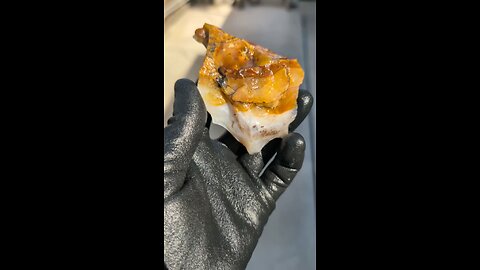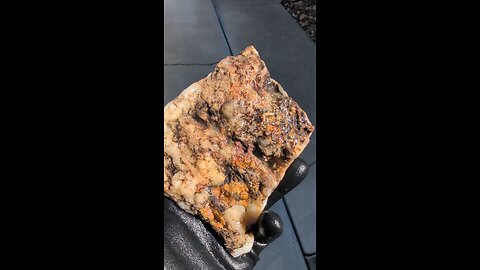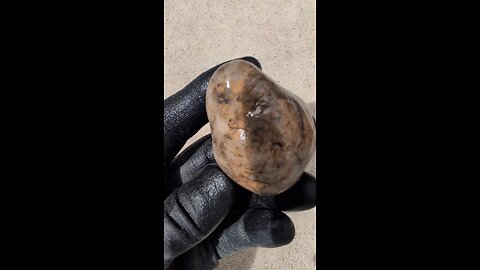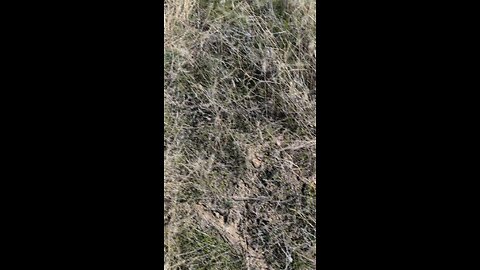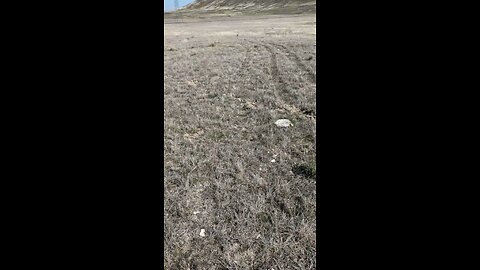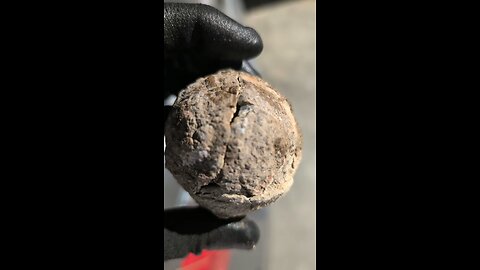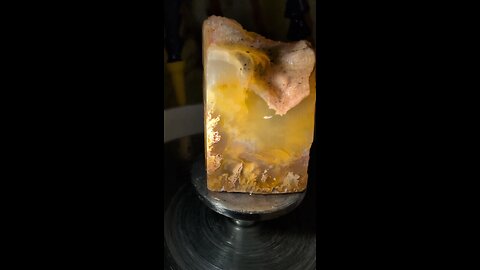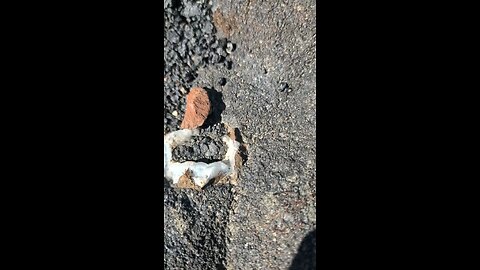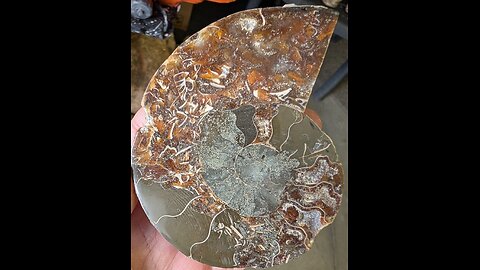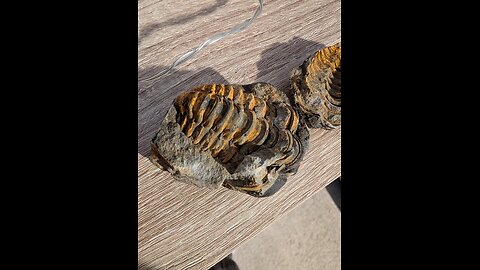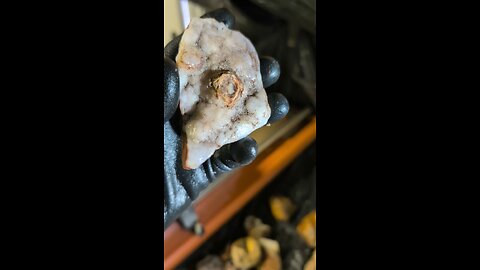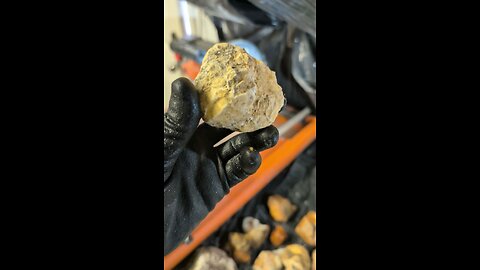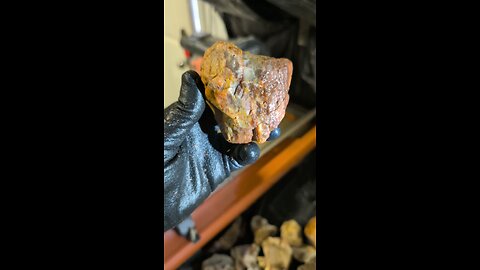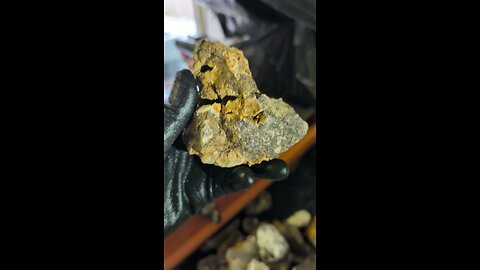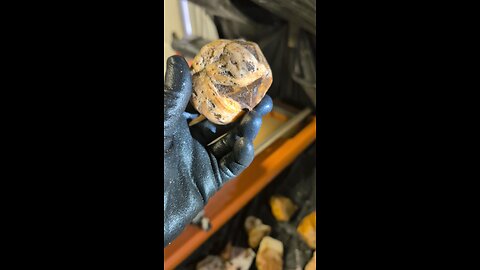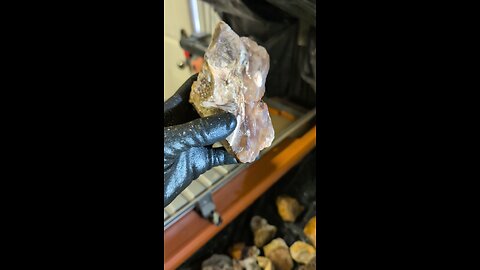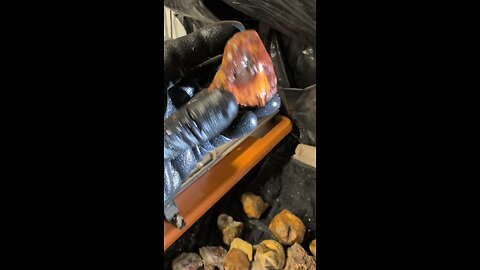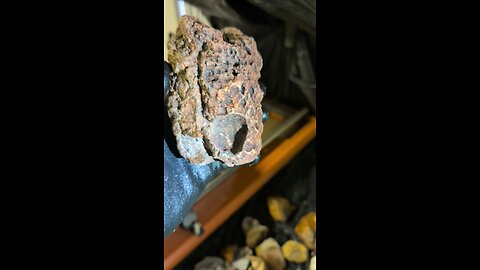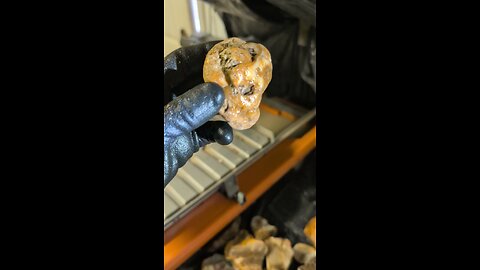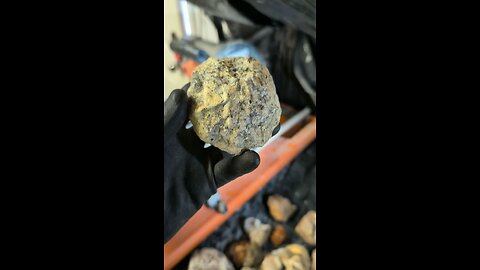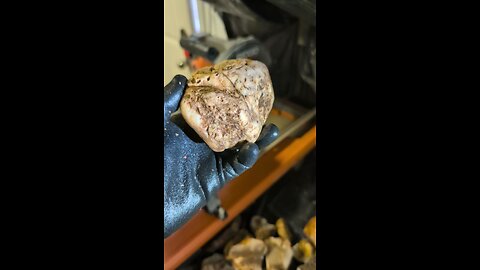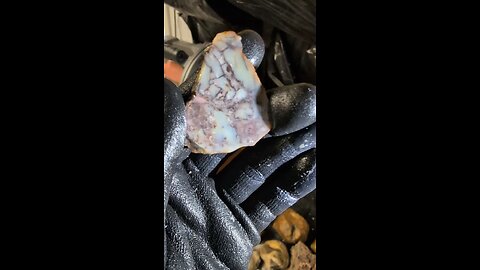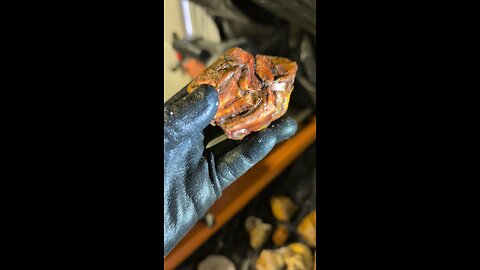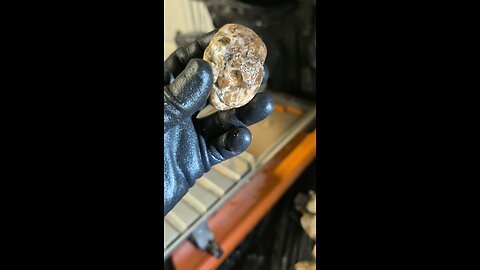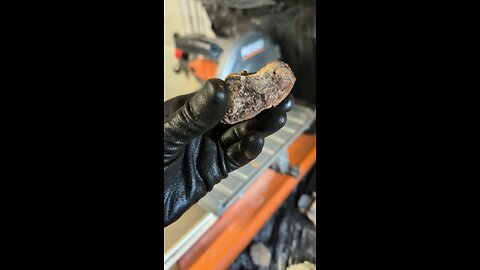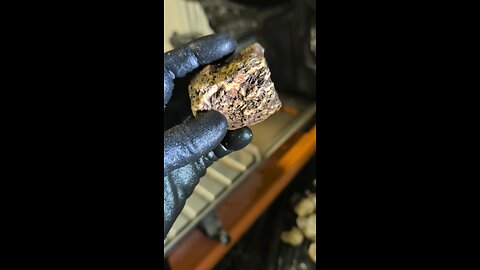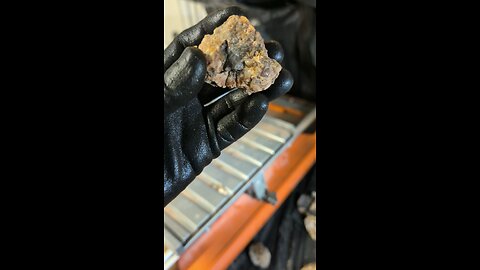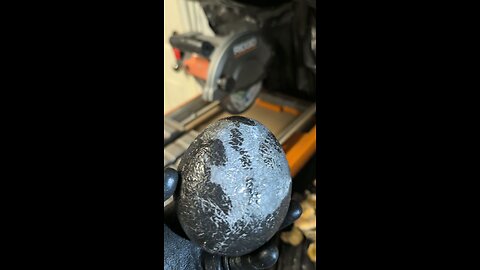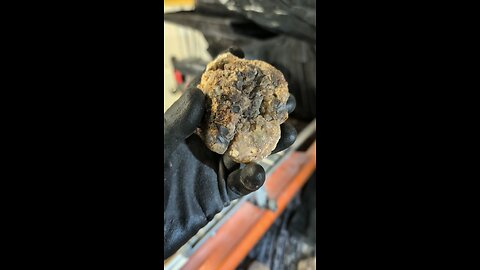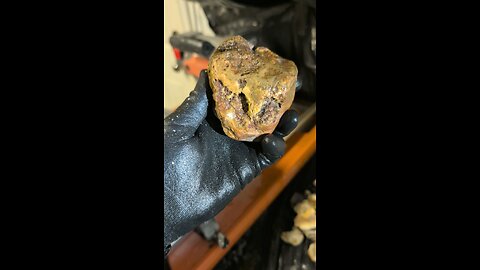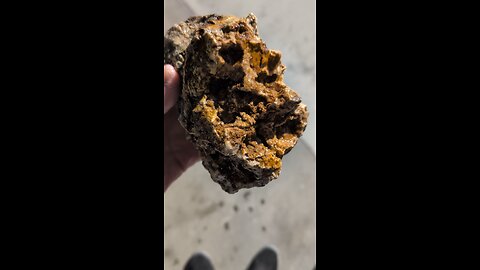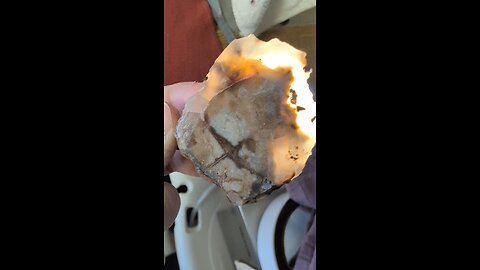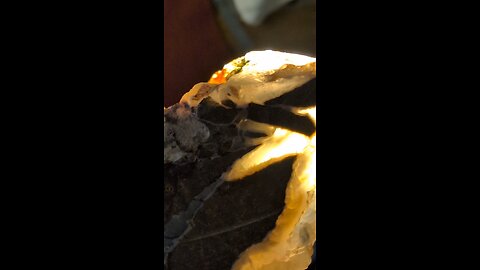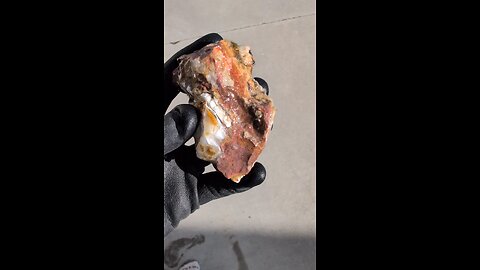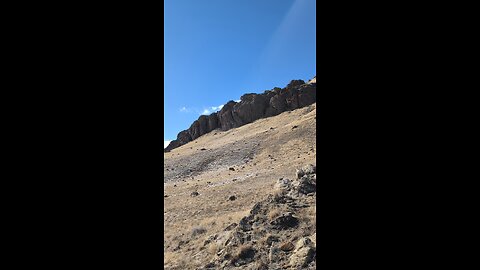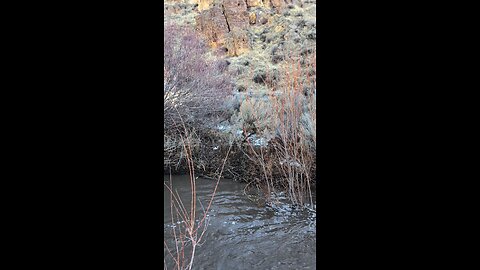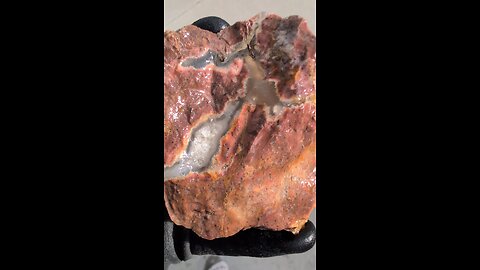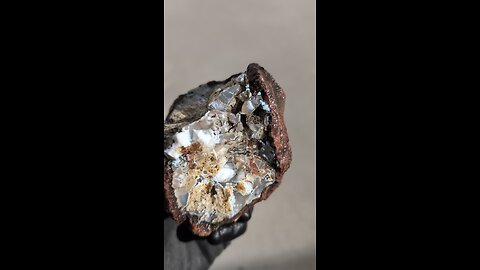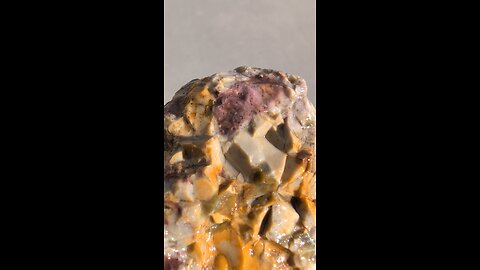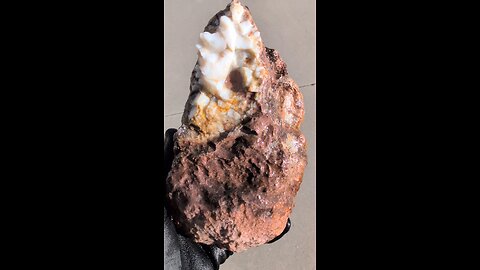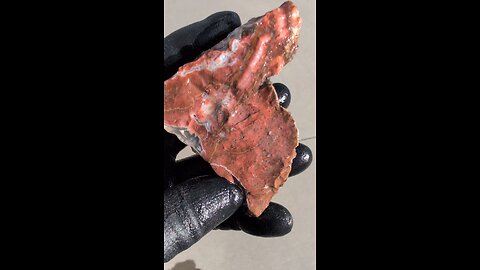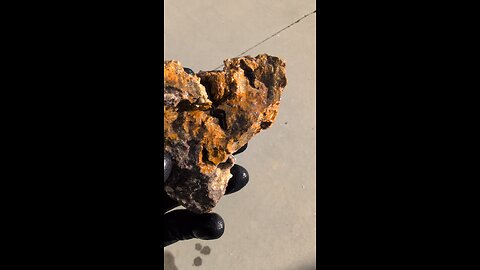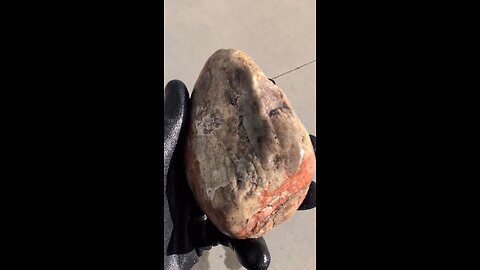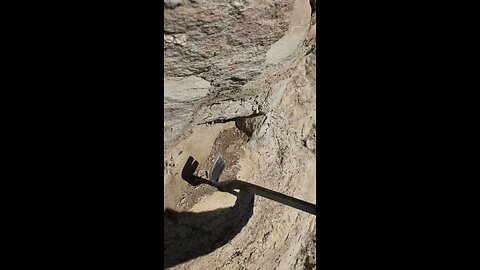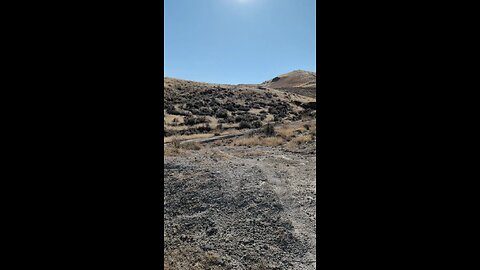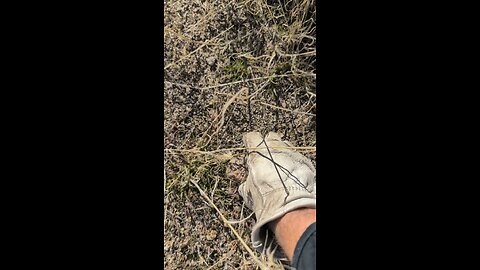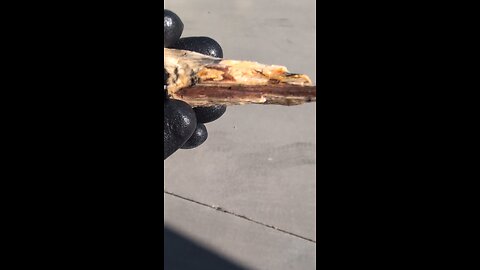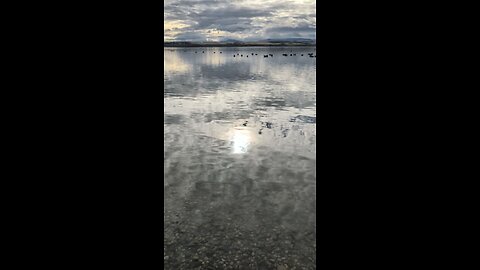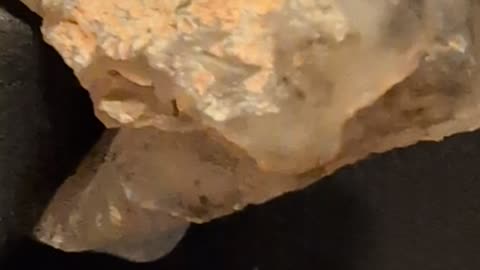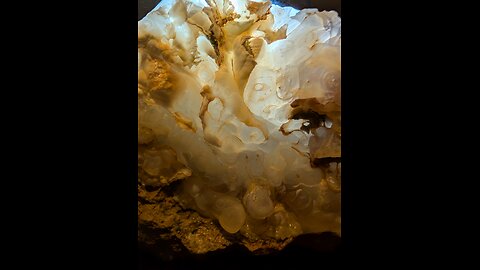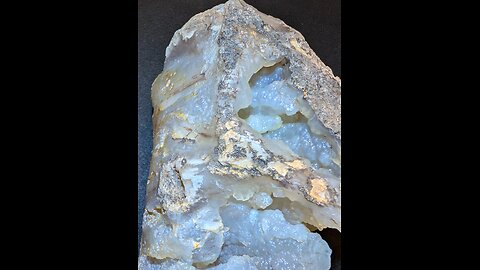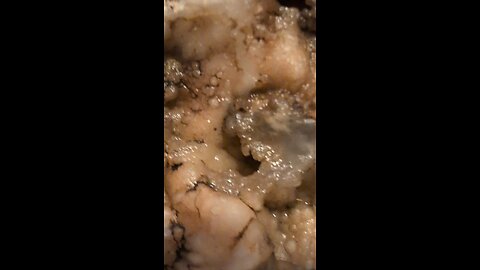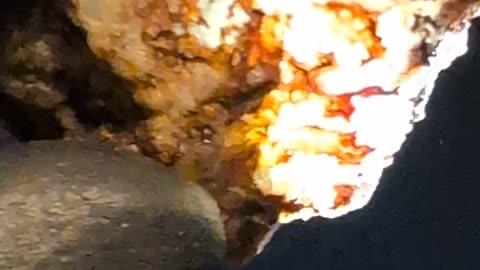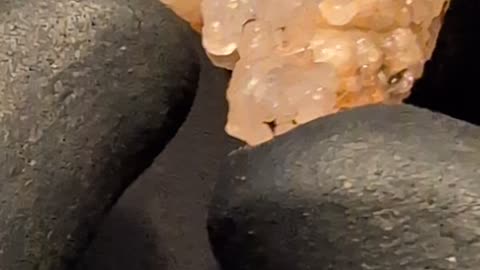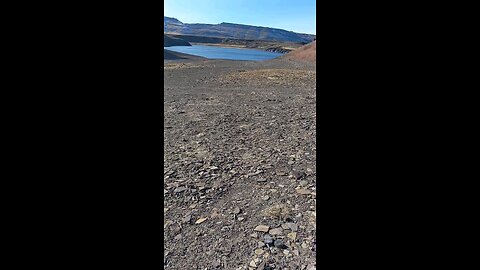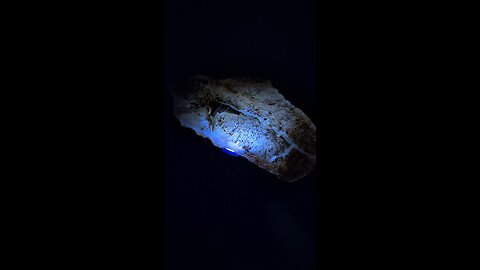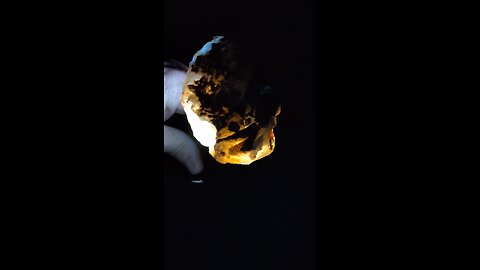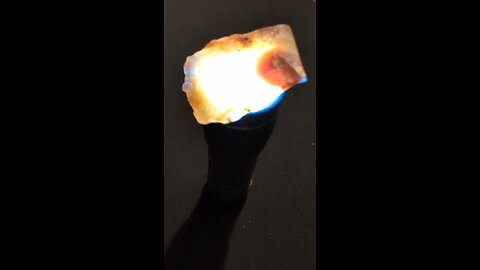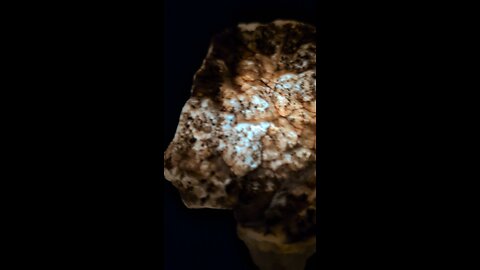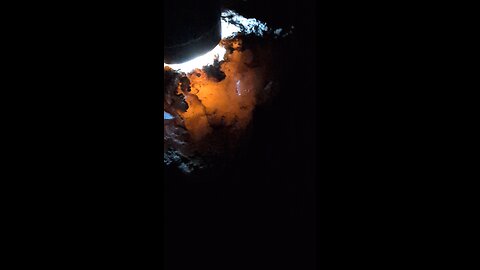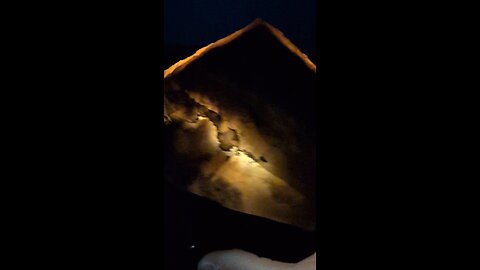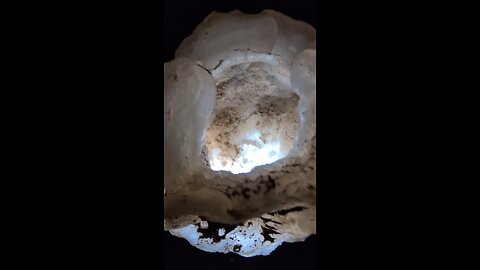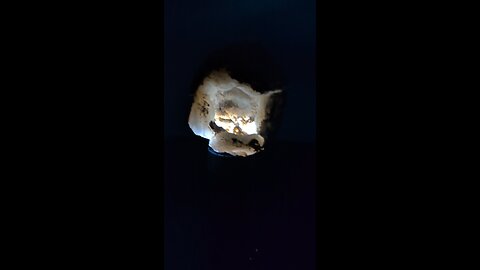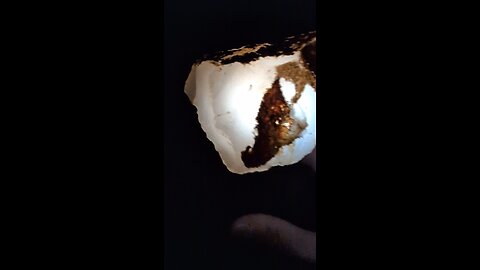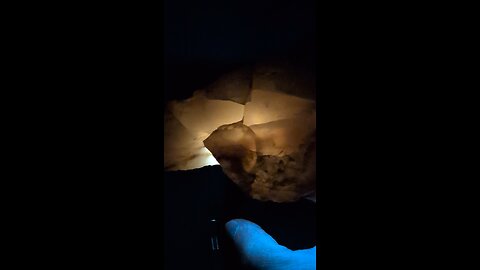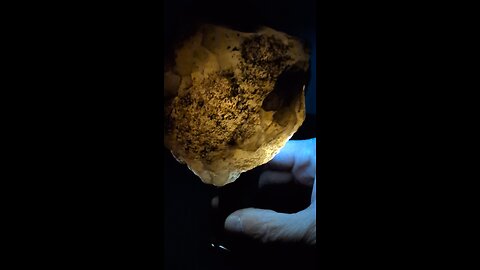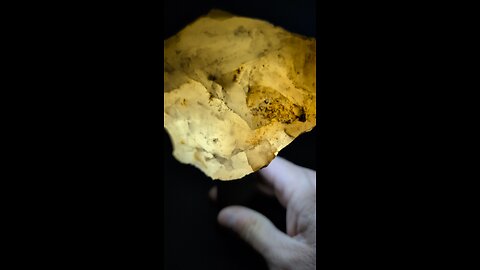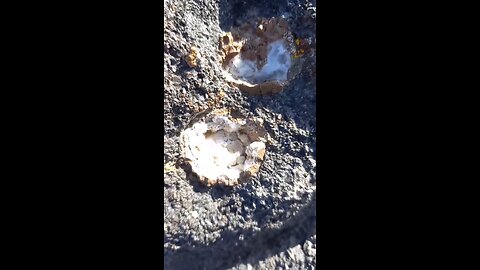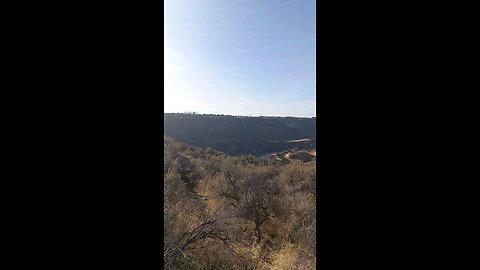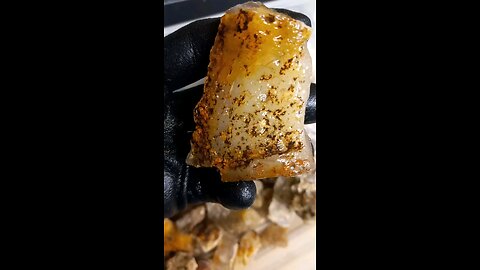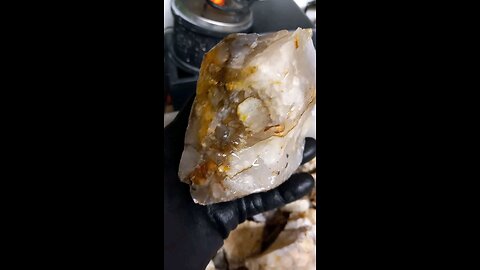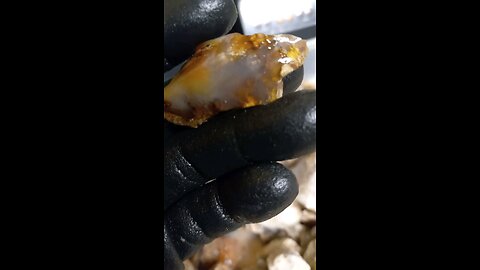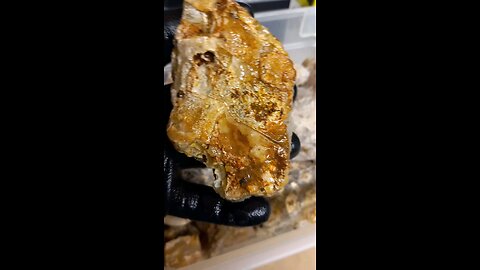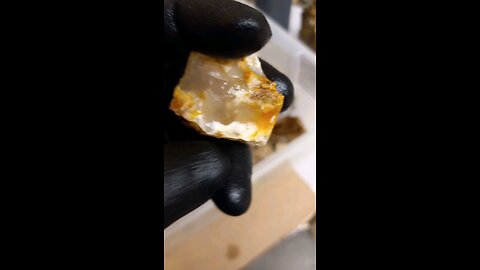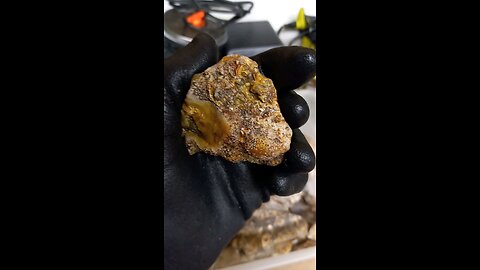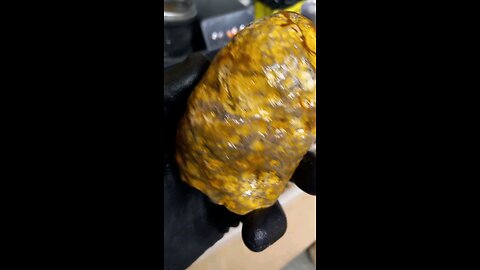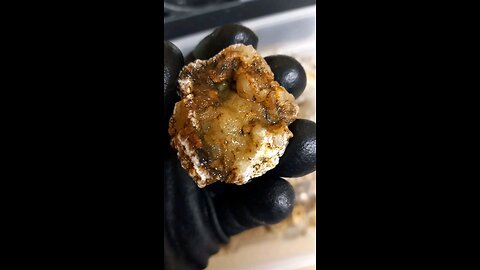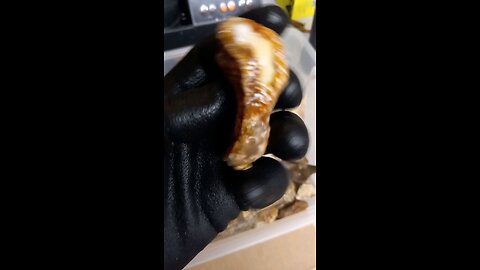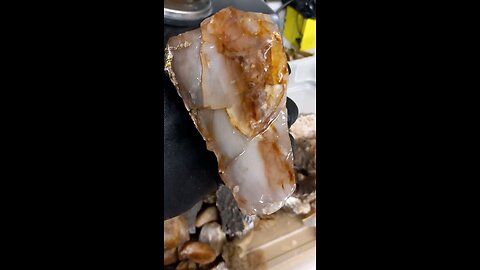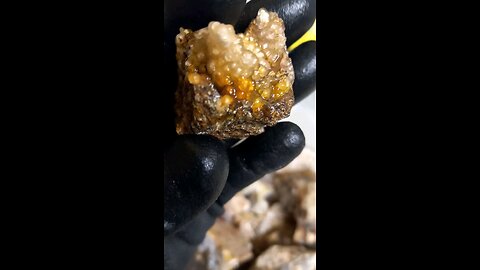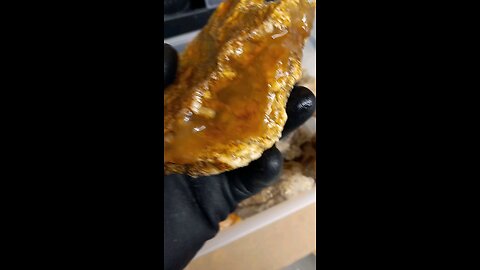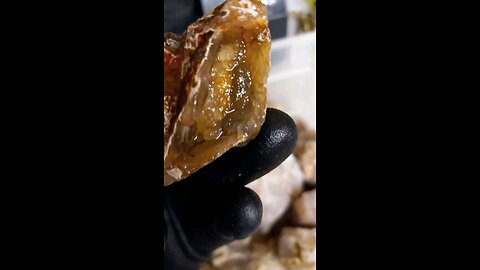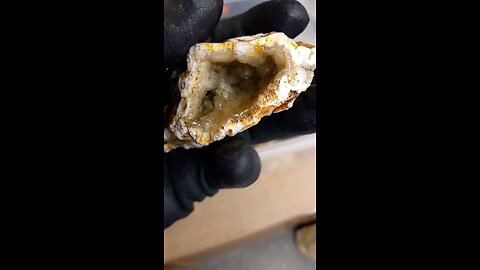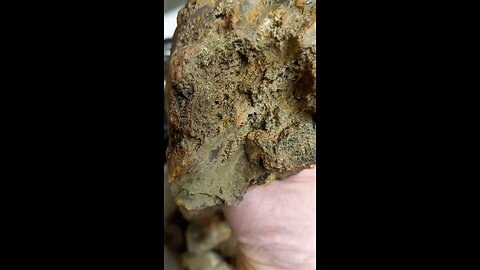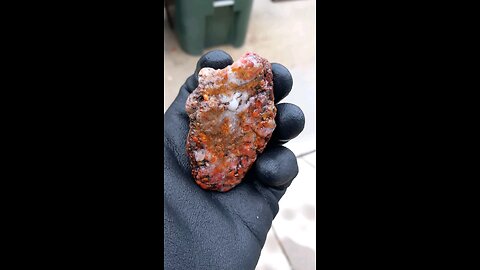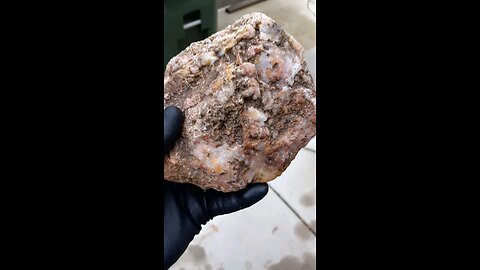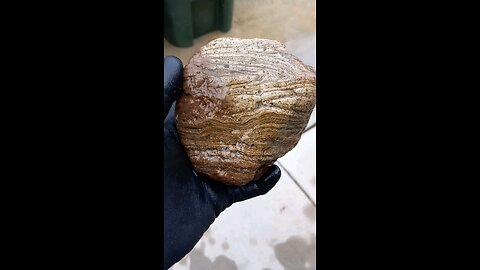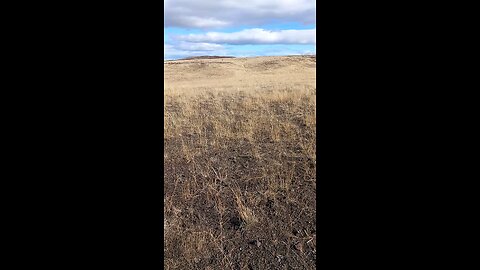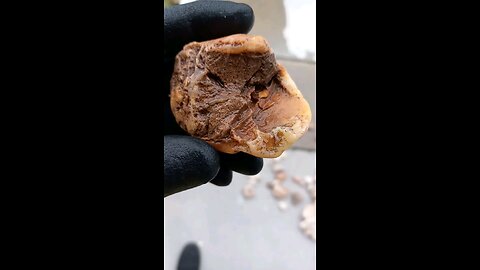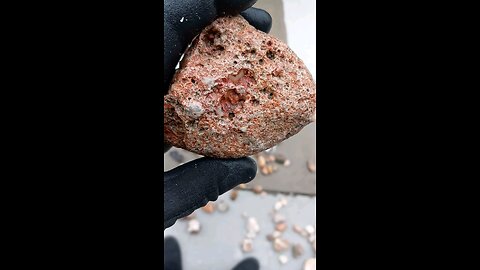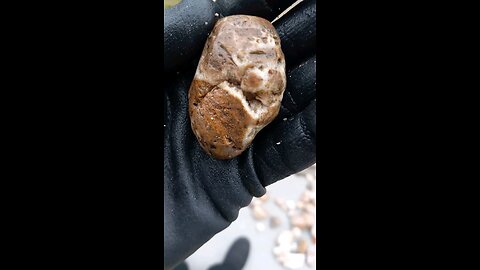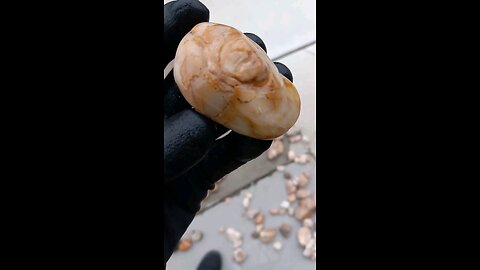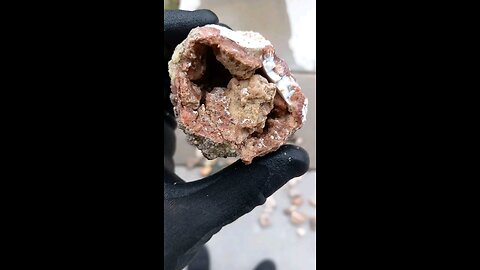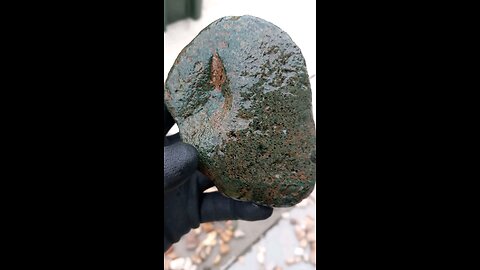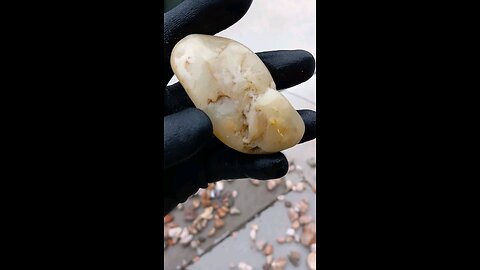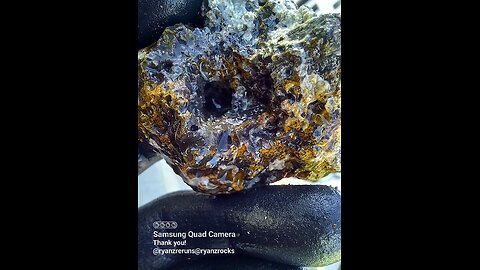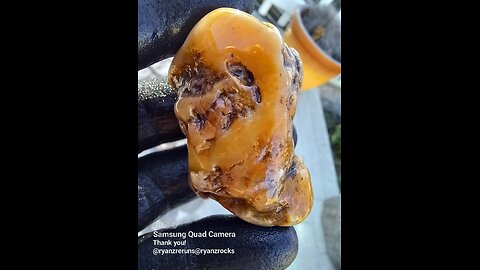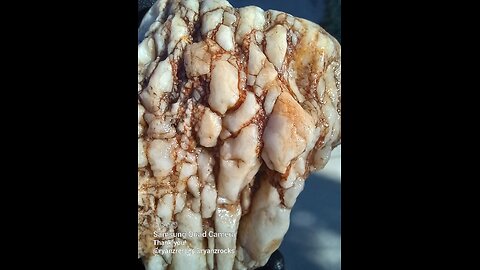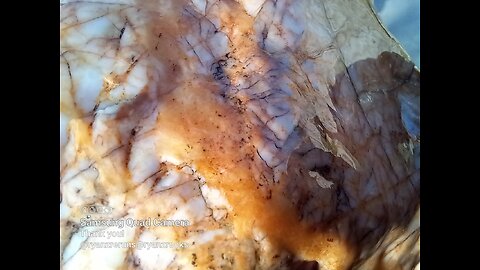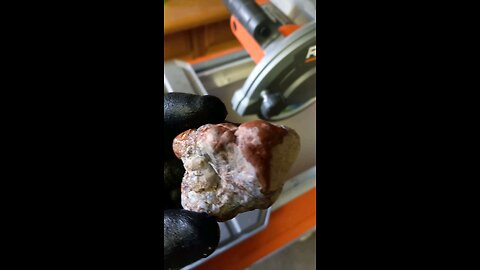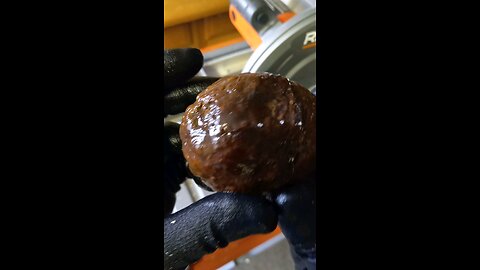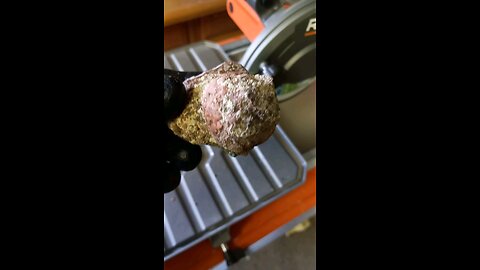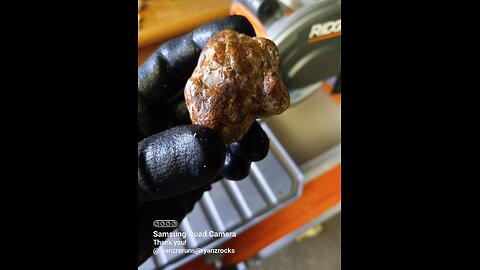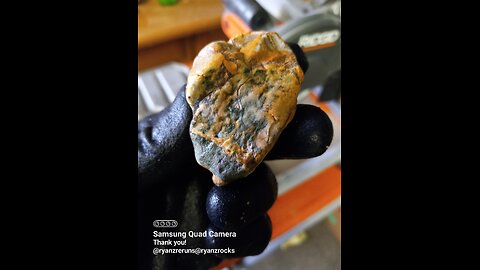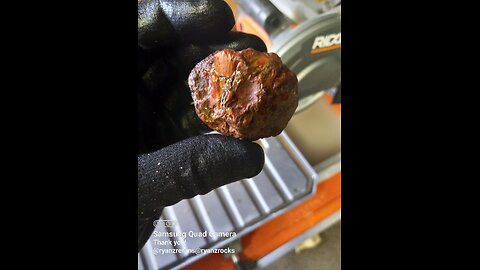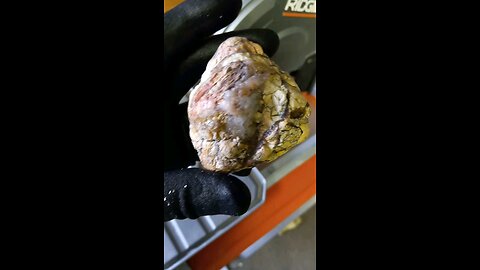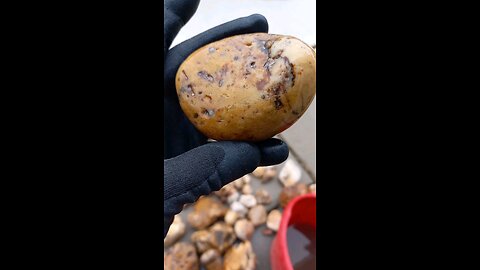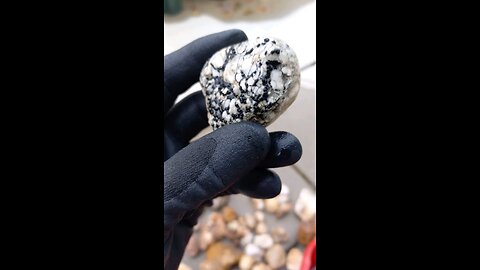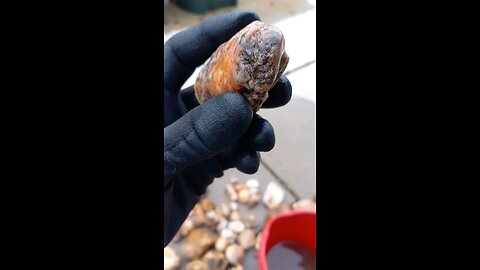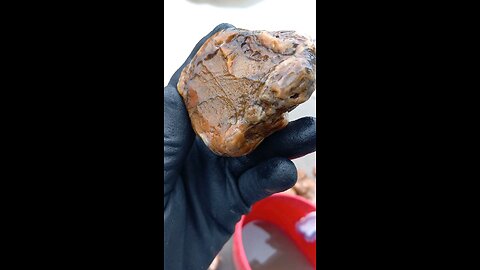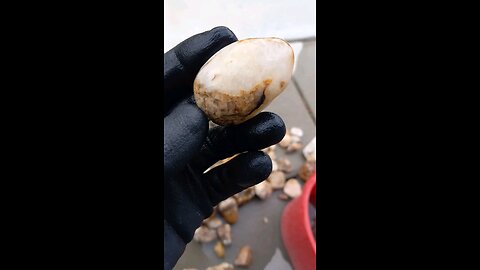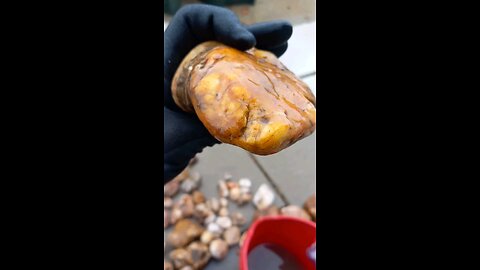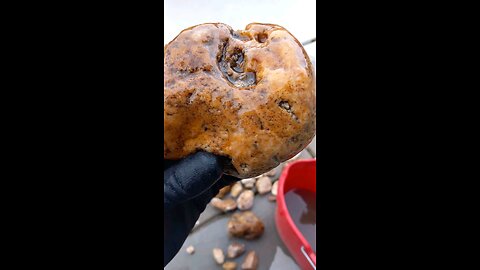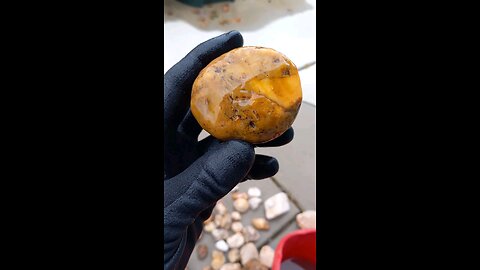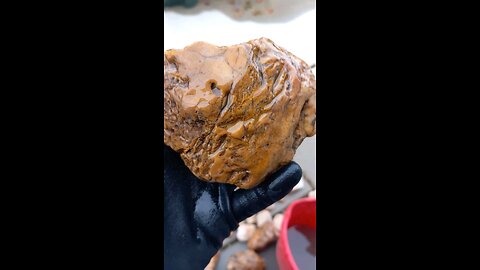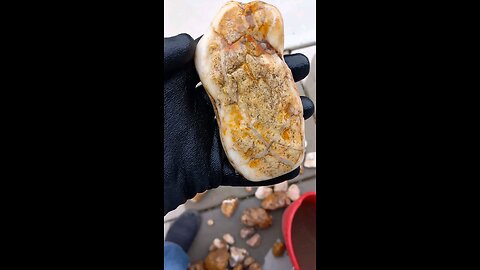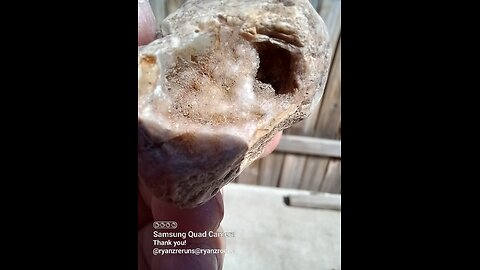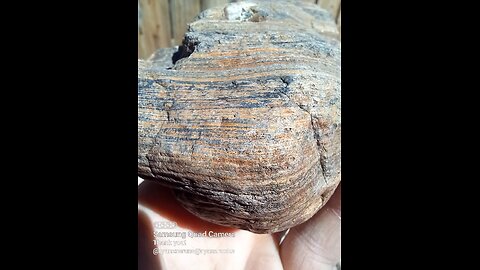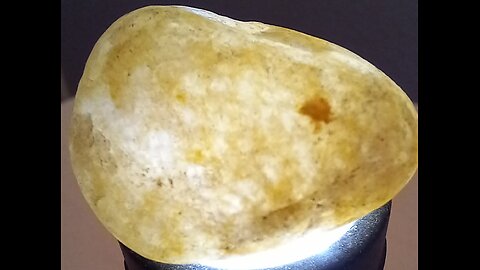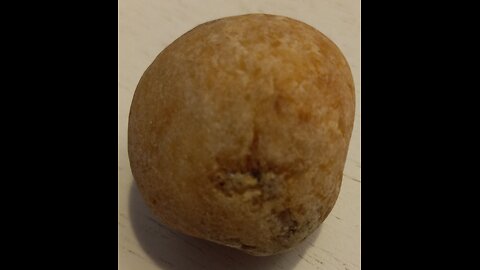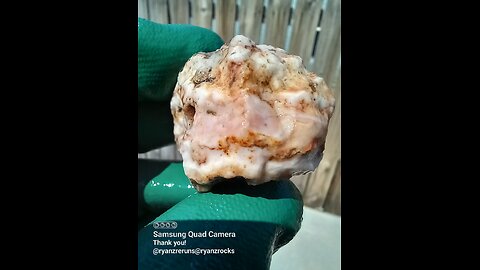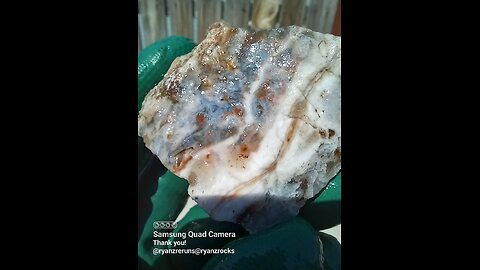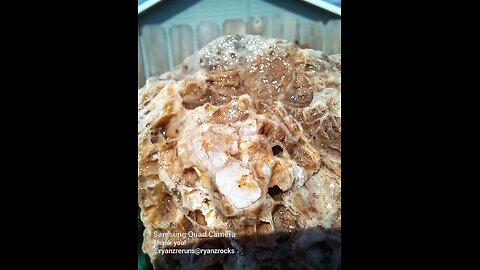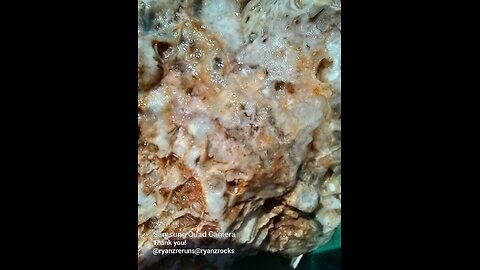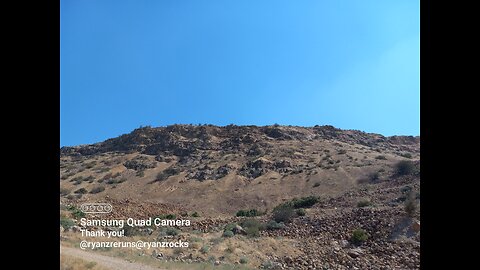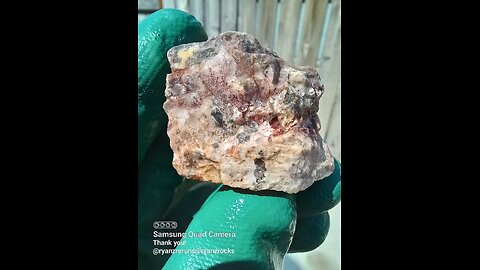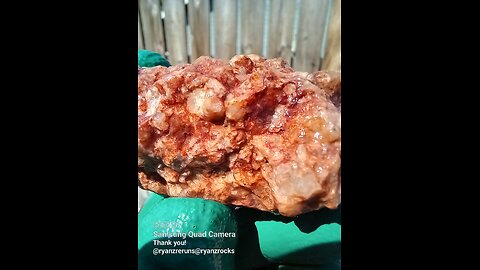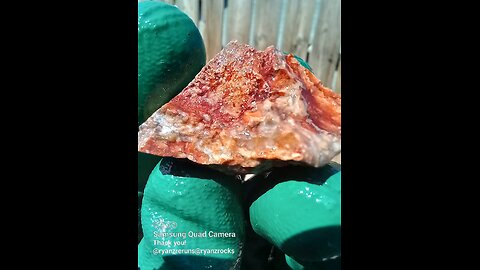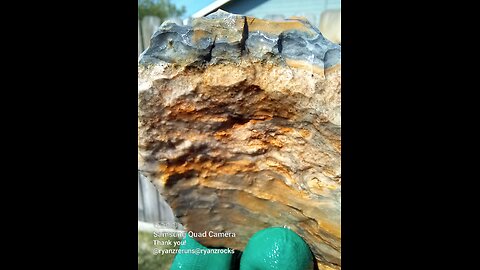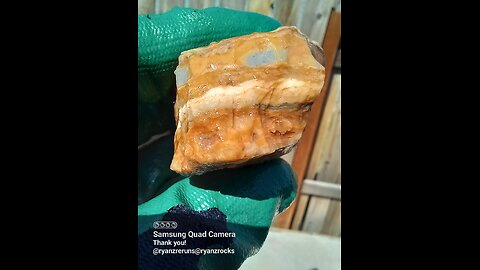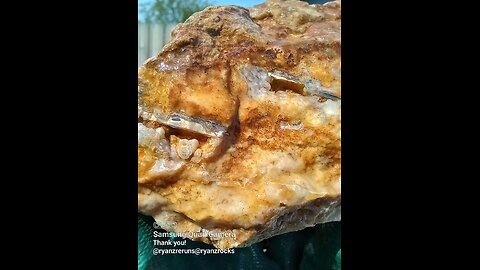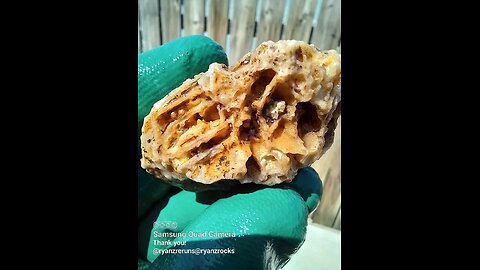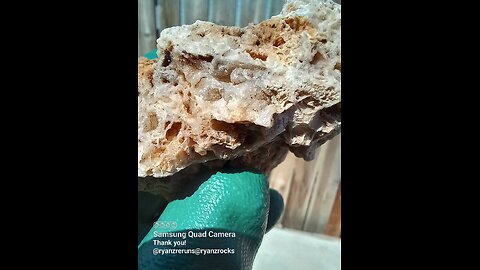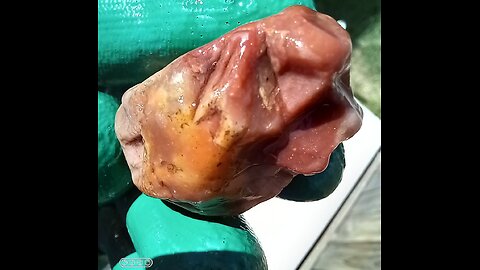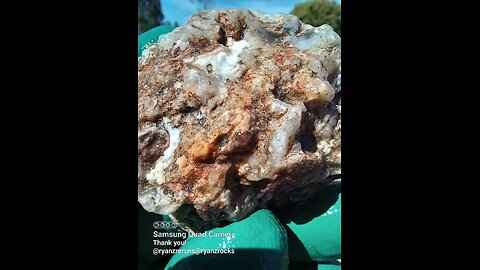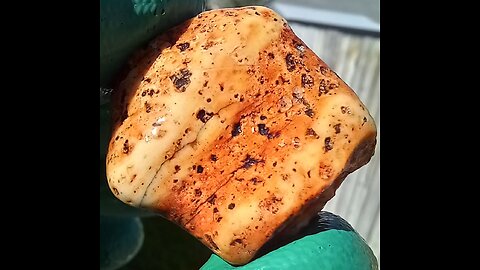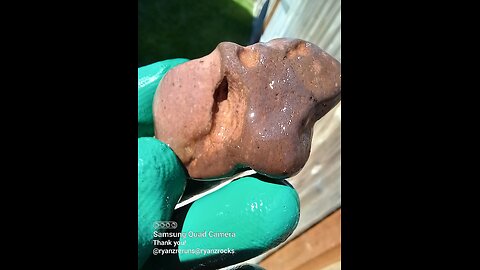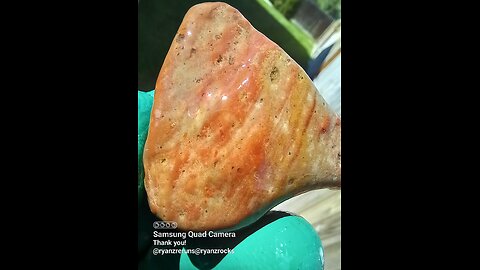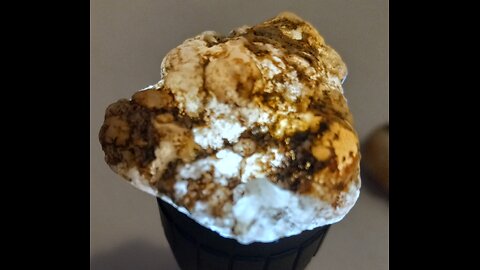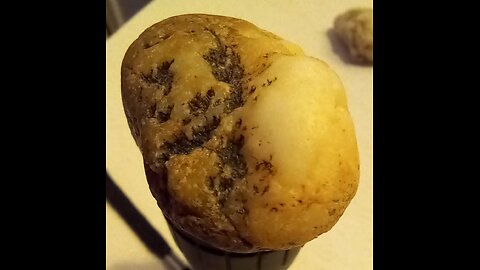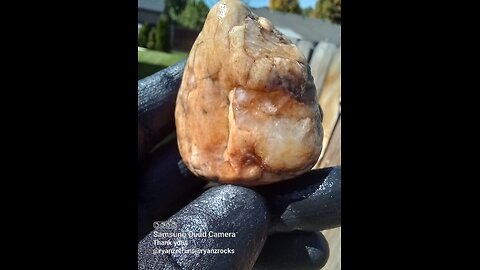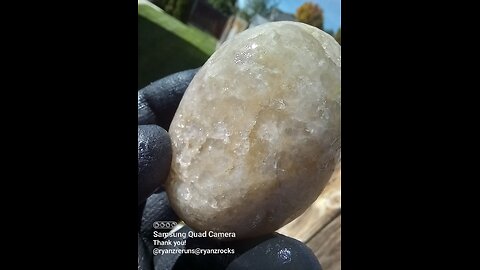Premium Only Content
This video is only available to Rumble Premium subscribers. Subscribe to
enjoy exclusive content and ad-free viewing.
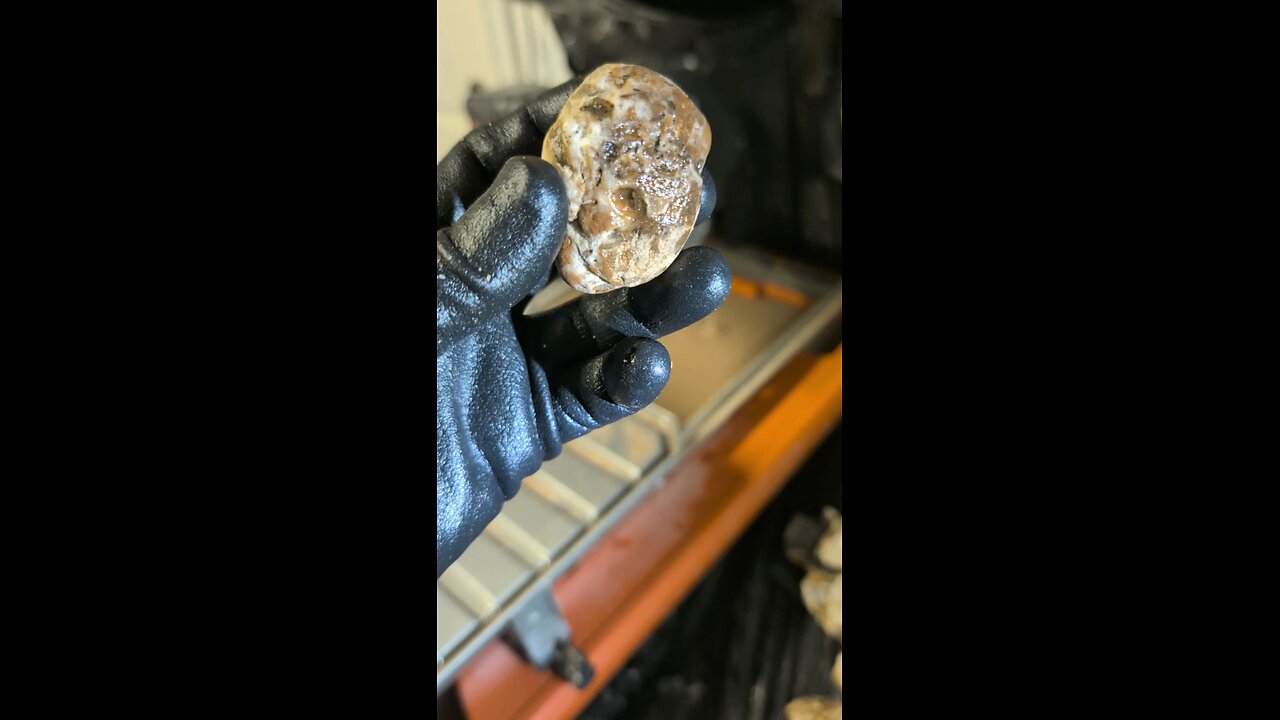
Idaho!
RyansRocks
- 45 / 200
1
Glow Carnelean!
RyanzRocks
This rock houses Carnelian, a type of chalcedony known for its rich, translucent, and warm orange to red-brown color. Here's why this identification might fit:
Color: Carnelian typically exhibits a range of colors from pale orange to deep red-brown, which matches the coloration seen in the rock in the image.
Translucency: Carnelian is often translucent to semi-translucent, which aligns with the way the light passes through the rock in the image, giving it a somewhat glassy appearance.
Layering: While not as pronounced as in banded agates, carnelian can sometimes show subtle banding or layers of color, which might be seen in the varying shades of orange and brown in the rock.
Texture: Carnelian has a waxy luster when polished, much like other forms of chalcedony, which seems consistent with the appearance of the rock in the image.
Carnelian is often used in jewelry and decorative items due to its vibrant color and attractive appearance. If this rock has been polished or cut for ornamental use, it would typically enhance its color and luster, making it look like this one.
2
Glow Plume Nugget!
RyanzRocks
Plume agate is a distinctive variety of agate, known for its unique and intricate patterns that resemble plumes, feathers, or even landscapes. Here are some key points about plume agate:
Formation: Plume agate forms when silica-rich solutions seep into cavities in volcanic rocks. The "plumes" are created by manganese or iron oxides that get trapped in the silica, forming these feather-like patterns.
Colors: The colors of plume agate can vary widely depending on the minerals present. Common colors include reds, browns, yellows, blacks, and whites, with the plumes often contrasting against the base color of the agate.
Locations: Notable locations where plume agate is found include Oregon in the United States (specifically, the Owyhee Mountain area), Mexico, and Brazil. Each location can produce agates with unique characteristics.
Uses: Plume agate is popular among collectors and is often used in jewelry like pendants, rings, and beads due to its aesthetic appeal. It's also valued in metaphysical communities, where it's believed to enhance one's connection to the Earth, promote creativity, and aid in grounding.
Care: Like other agates, plume agate is relatively hard (about 6.5-7 on the Mohs scale), making it durable for jewelry. However, it should be protected from sharp blows or extreme temperature changes to avoid cracking.
Identification: When identifying plume agate, look for the characteristic plume-like inclusions. These inclusions should appear as if they are floating within the stone, giving a 3D effect when viewed from different angles.
Plume agate's beauty lies in its natural patterns, which can look like trees, clouds, or even abstract art, making each piece unique.
3
Glow Plume Slab!
RyanzRocks
Plume agate is a distinctive variety of agate, known for its unique and intricate patterns that resemble plumes, feathers, or even landscapes. Here are some key points about plume agate:
Formation: Plume agate forms when silica-rich solutions seep into cavities in volcanic rocks. The "plumes" are created by manganese or iron oxides that get trapped in the silica, forming these feather-like patterns.
Colors: The colors of plume agate can vary widely depending on the minerals present. Common colors include reds, browns, yellows, blacks, and whites, with the plumes often contrasting against the base color of the agate.
Locations: Notable locations where plume agate is found include Oregon in the United States (specifically, the Owyhee Mountain area), Mexico, and Brazil. Each location can produce agates with unique characteristics.
Uses: Plume agate is popular among collectors and is often used in jewelry like pendants, rings, and beads due to its aesthetic appeal. It's also valued in metaphysical communities, where it's believed to enhance one's connection to the Earth, promote creativity, and aid in grounding.
Care: Like other agates, plume agate is relatively hard (about 6.5-7 on the Mohs scale), making it durable for jewelry. However, it should be protected from sharp blows or extreme temperature changes to avoid cracking.
Identification: When identifying plume agate, look for the characteristic plume-like inclusions. These inclusions should appear as if they are floating within the stone, giving a 3D effect when viewed from different angles.
Plume agate's beauty lies in its natural patterns, which can look like trees, clouds, or even abstract art, making each piece unique.
4
Glowing Plume!
RyanzRocks
Plume agate is a distinctive variety of agate, known for its unique and intricate patterns that resemble plumes, feathers, or even landscapes. Here are some key points about plume agate:
Formation: Plume agate forms when silica-rich solutions seep into cavities in volcanic rocks. The "plumes" are created by manganese or iron oxides that get trapped in the silica, forming these feather-like patterns.
Colors: The colors of plume agate can vary widely depending on the minerals present. Common colors include reds, browns, yellows, blacks, and whites, with the plumes often contrasting against the base color of the agate.
Locations: Notable locations where plume agate is found include Oregon in the United States (specifically, the Owyhee Mountain area), Mexico, and Brazil. Each location can produce agates with unique characteristics.
Uses: Plume agate is popular among collectors and is often used in jewelry like pendants, rings, and beads due to its aesthetic appeal. It's also valued in metaphysical communities, where it's believed to enhance one's connection to the Earth, promote creativity, and aid in grounding.
Care: Like other agates, plume agate is relatively hard (about 6.5-7 on the Mohs scale), making it durable for jewelry. However, it should be protected from sharp blows or extreme temperature changes to avoid cracking.
Identification: When identifying plume agate, look for the characteristic plume-like inclusions. These inclusions should appear as if they are floating within the stone, giving a 3D effect when viewed from different angles.
Plume agate's beauty lies in its natural patterns, which can look like trees, clouds, or even abstract art, making each piece unique.
5
Carnelean Glow!
RyanzRocks
This rock houses Carnelian, a type of chalcedony known for its rich, translucent, and warm orange to red-brown color. Here's why this identification might fit:
Color: Carnelian typically exhibits a range of colors from pale orange to deep red-brown, which matches the coloration seen in the rock in the image.
Translucency: Carnelian is often translucent to semi-translucent, which aligns with the way the light passes through the rock in the image, giving it a somewhat glassy appearance.
Layering: While not as pronounced as in banded agates, carnelian can sometimes show subtle banding or layers of color, which might be seen in the varying shades of orange and brown in the rock.
Texture: Carnelian has a waxy luster when polished, much like other forms of chalcedony, which seems consistent with the appearance of the rock in the image.
Carnelian is often used in jewelry and decorative items due to its vibrant color and attractive appearance. If this rock has been polished or cut for ornamental use, it would typically enhance its color and luster, making it look like this one.
Plume Agate is a captivating variety of agate, renowned for its intricate and delicate feather-like inclusions. These mesmerizing formations resemble ethereal plumes or wisps suspended within the stone, creating a stunning visual effect. It belongs to the chalcedony family, characterized by its microcrystalline structure and vibrant colors.
Plume Agate derives its name from the feathery patterns that adorn its surface. These patterns are typically composed of mineral deposits, often in striking hues such as white, cream, pink, or red, contrasting against a translucent or opaque background. These intricate formations are formed through the slow crystallization of silica-rich solutions within cavities or fissures in volcanic rocks.
Each piece of Plume Agate is unique, showcasing a kaleidoscope of colors and patterns. The delicate plumes within the stone evoke a sense of tranquility and beauty, making it a highly sought-after gemstone among collectors and jewelry enthusiasts alike.
Plume Agate holds significant importance in the world of gemstones and jewelry for several reasons:
Aesthetic Appeal: Plume Agate’s captivating patterns and vibrant colors make it a favorite among jewelry designers and collectors. Its unique beauty adds an element of elegance and individuality to any piece of jewelry.
Metaphysical Properties: In addition to its visual allure, Plume Agate is believed to possess metaphysical properties that promote harmony, balance, and emotional healing. It is often used in alternative healing practices and spiritual rituals.
Collectibility: Due to its rarity and unique characteristics, Plume Agate is highly prized by gemstone collectors. Specimens with exceptional plume formations or intense colors can command high prices in the market.
Versatility: Plume Agate’s diverse color palette and patterns make it a versatile gemstone for jewelry design. It can be fashioned into various shapes and sizes, including cabochons, beads, and carvings, allowing for creativity and innovation in jewelry making.
Historical Significance: Throughout history, agates have been revered for their beauty and perceived mystical properties. Plume Agate, with its distinct plume-like inclusions, has been admired and utilized in adornments and talismans by ancient civilizations.
Plume Agate stands out as a gemstone of exceptional beauty, imbued with both aesthetic and metaphysical significance. Its popularity in the world of gemstones and jewelry continues to endure, captivating admirers with its mesmerizing patterns and timeless allure.
6
Agate Glow!
RyanzRocks
Agate is a microcrystalline variety of quartz, specifically a form of chalcedony, known for its fine grain and bright color patterns. Here are some key points about agate:
Formation: Agate forms in volcanic and sedimentary rocks. It often begins as a cavity in the rock, which then gets filled with layers of silica-rich water. Over time, this solution deposits minerals in layers, creating the characteristic banding of agate. This process can take millions of years.
Appearance: Agate is famous for its beautiful, often banded patterns of color, which can range from translucent to opaque. Colors include white, blue, red, black, yellow, and brown among others, with the patterns formed by the successive layers of chalcedony being deposited. Sometimes, agates can be found with inclusions like moss (moss agate) or even fossils.
Types of Agate:
Banded Agate: Shows clear, concentric bands of color.
Moss Agate: Contains mineral inclusions that look like moss or foliage.
Dendritic Agate: Similar to moss agate but with tree-like or branch-like patterns.
Fire Agate: Contains iridescent layers that appear to glow with fiery colors.
Lace Agate: Features lace-like patterns, most notably in Blue Lace Agate from Namibia.
Crazy Lace Agate: Known for its wild, chaotic patterns of colors.
Locations: Agates are found worldwide, but some of the most famous locations include Brazil, Uruguay, Mexico, Germany, Madagascar, and the United States (particularly in Oregon, Washington, and Idaho).
Uses:
Jewelry: Due to its beauty when polished, agate is widely used in jewelry like rings, pendants, and beads.
Decorative Items: Larger pieces or slices are used for decorative objects, bookends, or as display pieces.
Metaphysical: In metaphysical practices, agate is believed to have various healing properties, like balancing physical, emotional, and intellectual energy, and promoting strength and courage.
Cultural Significance: Agate has been used since ancient times; it was prized in Ancient Egypt for amulets and seals, in Greece and Rome for intaglios and cameos, and by many other cultures for its beauty and supposed protective qualities.
Cutting and Polishing: When cutting agate for jewelry or display, lapidaries look for the most visually appealing patterns. The process involves sawing, grinding, and polishing to bring out the internal beauty of the stone.
Agate's diversity in color and pattern, combined with its durability, makes it one of the most sought-after stones in the world of gemology and mineral collecting.
7
Plume Glow!
RyanzRocks
Plume agate is a distinctive variety of agate, known for its unique and intricate patterns that resemble plumes, feathers, or even landscapes. Here are some key points about plume agate:
Formation: Plume agate forms when silica-rich solutions seep into cavities in volcanic rocks. The "plumes" are created by manganese or iron oxides that get trapped in the silica, forming these feather-like patterns.
Colors: The colors of plume agate can vary widely depending on the minerals present. Common colors include reds, browns, yellows, blacks, and whites, with the plumes often contrasting against the base color of the agate.
Locations: Notable locations where plume agate is found include Oregon in the United States (specifically, the Owyhee Mountain area), Mexico, and Brazil. Each location can produce agates with unique characteristics.
Uses: Plume agate is popular among collectors and is often used in jewelry like pendants, rings, and beads due to its aesthetic appeal. It's also valued in metaphysical communities, where it's believed to enhance one's connection to the Earth, promote creativity, and aid in grounding.
Care: Like other agates, plume agate is relatively hard (about 6.5-7 on the Mohs scale), making it durable for jewelry. However, it should be protected from sharp blows or extreme temperature changes to avoid cracking.
Identification: When identifying plume agate, look for the characteristic plume-like inclusions. These inclusions should appear as if they are floating within the stone, giving a 3D effect when viewed from different angles.
Plume agate's beauty lies in its natural patterns, which can look like trees, clouds, or even abstract art, making each piece unique.
1
comment
8
Plume Agate with Brecciated Jasper!
RyanzRocks
Plume agate is a distinctive variety of agate, known for its unique and intricate patterns that resemble plumes, feathers, or even landscapes. Here are some key points about plume agate:
Formation: Plume agate forms when silica-rich solutions seep into cavities in volcanic rocks. The "plumes" are created by manganese or iron oxides that get trapped in the silica, forming these feather-like patterns.
Colors: The colors of plume agate can vary widely depending on the minerals present. Common colors include reds, browns, yellows, blacks, and whites, with the plumes often contrasting against the base color of the agate.
Locations: Notable locations where plume agate is found include Oregon in the United States (specifically, the Owyhee Mountain area), Mexico, and Brazil. Each location can produce agates with unique characteristics.
Uses: Plume agate is popular among collectors and is often used in jewelry like pendants, rings, and beads due to its aesthetic appeal. It's also valued in metaphysical communities, where it's believed to enhance one's connection to the Earth, promote creativity, and aid in grounding.
Care: Like other agates, plume agate is relatively hard (about 6.5-7 on the Mohs scale), making it durable for jewelry. However, it should be protected from sharp blows or extreme temperature changes to avoid cracking.
Identification: When identifying plume agate, look for the characteristic plume-like inclusions. These inclusions should appear as if they are floating within the stone, giving a 3D effect when viewed from different angles.
Plume agate's beauty lies in its natural patterns, which can look like trees, clouds, or even abstract art, making each piece unique.
Brecciated Jasper is a type of jasper that is characterized by its appearance as broken fragments or pieces of jasper that have been naturally cemented together. Here's a more detailed explanation:
Formation: Brecciated Jasper forms when existing jasper is fractured or broken into pieces due to geological processes like tectonic activity or weathering. These fragments are then cemented together by silica or other minerals, often quartz, which fills the spaces between the fragments.
Appearance: It typically has a distinctive, mosaic-like pattern where the jasper fragments are angular and vary in size, creating a visually striking contrast with the matrix that holds them together. The colors can range from red, brown, yellow, to white, depending on the impurities present in the jasper and the matrix material.
Uses: Due to its unique and attractive pattern, Brecciated Jasper is commonly used in jewelry, carvings, and decorative items. It's valued for its aesthetic appeal and the interesting geological story it tells.
Properties: Like other types of jasper, Brecciated Jasper is relatively hard (around 6.5 to 7 on the Mohs scale), making it durable for various uses. It also has a waxy to vitreous luster when polished.
This type of jasper not only adds beauty to various crafts but also provides insight into the geological processes that have shaped our planet.
9
Asteroid!
RyanzRocks
This rock appears to be a sedimentary rock, possibly a concretion or a nodule in mudstone or sandstone, with iron staining. Here's a more detailed breakdown:
Reasons for the Identification:
* Rounded Shape: The rock has a relatively rounded, irregular shape, which is often seen in concretions and nodules.
* Textural Variation: The rock shows variations in texture, with some areas appearing smoother and others more pitted or porous. This is common in concretions where different minerals may have precipitated in the pore spaces.
* Coloration: The rock has a mix of brown, gray, and orange hues, likely due to iron oxides staining the original material.
* Possible Internal Structure: The circular or oval-shaped depressions might indicate the presence of fossils or other structures that were replaced or dissolved, leaving behind a void.
Concretion or Nodule:
* Concretion: A concretion is a hard, compact mass of sedimentary rock formed by the precipitation of minerals around a nucleus (like a fossil fragment or leaf). They often have a different composition than the surrounding rock.
* Nodule: A nodule is a general term for a lump or mass of a mineral or rock with a rounded or irregular shape, distinct from the surrounding material.
Mudstone or Sandstone Matrix:
* The overall appearance suggests that the concretion or nodule is embedded in a fine-grained sedimentary rock, possibly mudstone or sandstone, which has been weathered and stained by iron oxides.
10
Interesting Botryoidal Formation!
RyanzRocks
A botryoidal formation refers to a mineral structure that resembles a cluster of grapes or small, rounded, and knobby protrusions. Here are some details about botryoidal formations:
Characteristics:
Shape: The term "botryoidal" comes from the Greek word "botryoeides," meaning "grape-like." These formations have a surface that looks like a bunch of grapes.
Texture: They typically have a smooth, rounded surface, which can sometimes be polished to enhance their appearance.
Formation:
Process: Botryoidal formations occur when minerals precipitate from solution in a manner that favors the growth of rounded, nodular shapes. This often happens in cavities or vugs where mineral-rich fluids slowly deposit layers over time.
Common Minerals: Minerals that commonly form botryoidal structures include:
Hematite: Often found in botryoidal forms, giving a shiny, metallic luster.
Malachite: Known for its vibrant green color in botryoidal formations.
Goethite: Can exhibit botryoidal textures, often with a brownish to yellowish hue.
Chalcedony: Sometimes forms botryoidal structures, especially in agates.
Examples:
Botryoidal Hematite: Often found in iron-rich environments, it has a metallic sheen and can be polished to a high gloss.
Botryoidal Malachite: Famous for its green color and banding, often found in the oxidized zones of copper deposits.
Locations:
Botryoidal formations can be found worldwide in various geological settings where mineral precipitation occurs, from mines to natural rock formations.
Uses:
Decorative: Botryoidal minerals are popular in mineral collections and for decorative purposes due to their unique and attractive appearance.
Jewelry: Some botryoidal minerals like malachite are cut and polished for use in jewelry.
Botryoidal formations are fascinating because they provide insight into the conditions under which they formed, often indicating slow, steady mineral deposition in specific environmental conditions.
Plume agate is a distinctive variety of agate, known for its unique and intricate patterns that resemble plumes, feathers, or even landscapes. Here are some key points about plume agate:
Formation: Plume agate forms when silica-rich solutions seep into cavities in volcanic rocks. The "plumes" are created by manganese or iron oxides that get trapped in the silica, forming these feather-like patterns.
Colors: The colors of plume agate can vary widely depending on the minerals present. Common colors include reds, browns, yellows, blacks, and whites, with the plumes often contrasting against the base color of the agate.
Locations: Notable locations where plume agate is found include Oregon in the United States (specifically, the Owyhee Mountain area), Mexico, and Brazil. Each location can produce agates with unique characteristics.
Uses: Plume agate is popular among collectors and is often used in jewelry like pendants, rings, and beads due to its aesthetic appeal. It's also valued in metaphysical communities, where it's believed to enhance one's connection to the Earth, promote creativity, and aid in grounding.
Care: Like other agates, plume agate is relatively hard (about 6.5-7 on the Mohs scale), making it durable for jewelry. However, it should be protected from sharp blows or extreme temperature changes to avoid cracking.
Identification: When identifying plume agate, look for the characteristic plume-like inclusions. These inclusions should appear as if they are floating within the stone, giving a 3D effect when viewed from different angles.
Plume agate's beauty lies in its natural patterns, which can look like trees, clouds, or even abstract art, making each piece unique.
11
Holy Jasper!
RyanzRocks
Jasper is a type of chalcedony, which is a microcrystalline variety of quartz. Specifically, jasper is known for its opaque appearance and often comes in various colors, primarily red, yellow, brown, or green, due to the presence of impurities like iron oxides or other minerals. Here are some key characteristics of jasper:
Texture: Typically fine-grained with a smooth, sometimes waxy, surface.
Hardness: On the Mohs scale, jasper ranks between 6.5 and 7, making it quite durable.
Formation: Jasper forms in hydrothermal veins, volcanic rocks, or as sedimentary deposits. It can also occur in nodules or as a cementing material in conglomerates.
Jasper often exhibits patterns or banding, which can be quite striking, leading to its use in jewelry, decorative items, and even in ancient artifacts for its beauty and durability. Varieties of jasper include:
Picture Jasper: Known for its landscape-like patterns.
Red Jasper: Often uniform in color, used for its deep red hue.
Ocean Jasper: Characterized by orbicular patterns in various colors.
12
Goethite!
RyanzRocks
This rock appears to be limonite or goethite, both iron oxides. Here's why and how to distinguish them:
Reasons for the Identification:
* Color: The rock exhibits a range of brown, yellowish-brown, and reddish-brown hues, which are typical for iron oxides.
* Texture: It has a porous, botryoidal (grape-like clusters) or earthy texture, also common in limonite and goethite.
* Appearance: The overall appearance suggests a hydrated iron oxide mineral.
Distinguishing Between Limonite and Goethite:
* Limonite: Limonite is not a true mineral but rather a mixture of hydrated iron oxides, primarily goethite. It's often amorphous and can appear as a rusty coating or in various forms like stalactitic or botryoidal.
* Goethite: Goethite is a specific iron oxide mineral (α-FeOOH). It can have a variety of colors (yellow, brown, reddish-brown) and forms (fibrous, botryoidal, massive).
13
Carnelean!
RyanzRocks
This rock houses Carnelian, a type of chalcedony known for its rich, translucent, and warm orange to red-brown color. Here's why this identification might fit:
Color: Carnelian typically exhibits a range of colors from pale orange to deep red-brown, which matches the coloration seen in the rock in the image.
Translucency: Carnelian is often translucent to semi-translucent, which aligns with the way the light passes through the rock in the image, giving it a somewhat glassy appearance.
Layering: While not as pronounced as in banded agates, carnelian can sometimes show subtle banding or layers of color, which might be seen in the varying shades of orange and brown in the rock.
Texture: Carnelian has a waxy luster when polished, much like other forms of chalcedony, which seems consistent with the appearance of the rock in the image.
Carnelian is often used in jewelry and decorative items due to its vibrant color and attractive appearance. If this rock has been polished or cut for ornamental use, it would typically enhance its color and luster, making it look like this one.
Plume Agate is a captivating variety of agate, renowned for its intricate and delicate feather-like inclusions. These mesmerizing formations resemble ethereal plumes or wisps suspended within the stone, creating a stunning visual effect. It belongs to the chalcedony family, characterized by its microcrystalline structure and vibrant colors.
Plume Agate derives its name from the feathery patterns that adorn its surface. These patterns are typically composed of mineral deposits, often in striking hues such as white, cream, pink, or red, contrasting against a translucent or opaque background. These intricate formations are formed through the slow crystallization of silica-rich solutions within cavities or fissures in volcanic rocks.
Each piece of Plume Agate is unique, showcasing a kaleidoscope of colors and patterns. The delicate plumes within the stone evoke a sense of tranquility and beauty, making it a highly sought-after gemstone among collectors and jewelry enthusiasts alike.
Plume Agate holds significant importance in the world of gemstones and jewelry for several reasons:
Aesthetic Appeal: Plume Agate’s captivating patterns and vibrant colors make it a favorite among jewelry designers and collectors. Its unique beauty adds an element of elegance and individuality to any piece of jewelry.
Metaphysical Properties: In addition to its visual allure, Plume Agate is believed to possess metaphysical properties that promote harmony, balance, and emotional healing. It is often used in alternative healing practices and spiritual rituals.
Collectibility: Due to its rarity and unique characteristics, Plume Agate is highly prized by gemstone collectors. Specimens with exceptional plume formations or intense colors can command high prices in the market.
Versatility: Plume Agate’s diverse color palette and patterns make it a versatile gemstone for jewelry design. It can be fashioned into various shapes and sizes, including cabochons, beads, and carvings, allowing for creativity and innovation in jewelry making.
Historical Significance: Throughout history, agates have been revered for their beauty and perceived mystical properties. Plume Agate, with its distinct plume-like inclusions, has been admired and utilized in adornments and talismans by ancient civilizations.
Plume Agate stands out as a gemstone of exceptional beauty, imbued with both aesthetic and metaphysical significance. Its popularity in the world of gemstones and jewelry continues to endure, captivating admirers with its mesmerizing patterns and timeless allure.
14
Carnelean!
RyanzRocks
This rock houses Carnelian, a type of chalcedony known for its rich, translucent, and warm orange to red-brown color. Here's why this identification might fit:
Color: Carnelian typically exhibits a range of colors from pale orange to deep red-brown, which matches the coloration seen in the rock in the image.
Translucency: Carnelian is often translucent to semi-translucent, which aligns with the way the light passes through the rock in the image, giving it a somewhat glassy appearance.
Layering: While not as pronounced as in banded agates, carnelian can sometimes show subtle banding or layers of color, which might be seen in the varying shades of orange and brown in the rock.
Texture: Carnelian has a waxy luster when polished, much like other forms of chalcedony, which seems consistent with the appearance of the rock in the image.
Carnelian is often used in jewelry and decorative items due to its vibrant color and attractive appearance. If this rock has been polished or cut for ornamental use, it would typically enhance its color and luster, making it look like this one.
Plume Agate is a captivating variety of agate, renowned for its intricate and delicate feather-like inclusions. These mesmerizing formations resemble ethereal plumes or wisps suspended within the stone, creating a stunning visual effect. It belongs to the chalcedony family, characterized by its microcrystalline structure and vibrant colors.
Plume Agate derives its name from the feathery patterns that adorn its surface. These patterns are typically composed of mineral deposits, often in striking hues such as white, cream, pink, or red, contrasting against a translucent or opaque background. These intricate formations are formed through the slow crystallization of silica-rich solutions within cavities or fissures in volcanic rocks.
Each piece of Plume Agate is unique, showcasing a kaleidoscope of colors and patterns. The delicate plumes within the stone evoke a sense of tranquility and beauty, making it a highly sought-after gemstone among collectors and jewelry enthusiasts alike.
Plume Agate holds significant importance in the world of gemstones and jewelry for several reasons:
Aesthetic Appeal: Plume Agate’s captivating patterns and vibrant colors make it a favorite among jewelry designers and collectors. Its unique beauty adds an element of elegance and individuality to any piece of jewelry.
Metaphysical Properties: In addition to its visual allure, Plume Agate is believed to possess metaphysical properties that promote harmony, balance, and emotional healing. It is often used in alternative healing practices and spiritual rituals.
Collectibility: Due to its rarity and unique characteristics, Plume Agate is highly prized by gemstone collectors. Specimens with exceptional plume formations or intense colors can command high prices in the market.
Versatility: Plume Agate’s diverse color palette and patterns make it a versatile gemstone for jewelry design. It can be fashioned into various shapes and sizes, including cabochons, beads, and carvings, allowing for creativity and innovation in jewelry making.
Historical Significance: Throughout history, agates have been revered for their beauty and perceived mystical properties. Plume Agate, with its distinct plume-like inclusions, has been admired and utilized in adornments and talismans by ancient civilizations.
Plume Agate stands out as a gemstone of exceptional beauty, imbued with both aesthetic and metaphysical significance. Its popularity in the world of gemstones and jewelry continues to endure, captivating admirers with its mesmerizing patterns and timeless allure.
15
Plume chunk!
RyanzRocks
Plume agate is a distinctive variety of agate, known for its unique and intricate patterns that resemble plumes, feathers, or even landscapes. Here are some key points about plume agate:
Formation: Plume agate forms when silica-rich solutions seep into cavities in volcanic rocks. The "plumes" are created by manganese or iron oxides that get trapped in the silica, forming these feather-like patterns.
Colors: The colors of plume agate can vary widely depending on the minerals present. Common colors include reds, browns, yellows, blacks, and whites, with the plumes often contrasting against the base color of the agate.
Locations: Notable locations where plume agate is found include Oregon in the United States (specifically, the Owyhee Mountain area), Mexico, and Brazil. Each location can produce agates with unique characteristics.
Uses: Plume agate is popular among collectors and is often used in jewelry like pendants, rings, and beads due to its aesthetic appeal. It's also valued in metaphysical communities, where it's believed to enhance one's connection to the Earth, promote creativity, and aid in grounding.
Care: Like other agates, plume agate is relatively hard (about 6.5-7 on the Mohs scale), making it durable for jewelry. However, it should be protected from sharp blows or extreme temperature changes to avoid cracking.
Identification: When identifying plume agate, look for the characteristic plume-like inclusions. These inclusions should appear as if they are floating within the stone, giving a 3D effect when viewed from different angles.
Plume agate's beauty lies in its natural patterns, which can look like trees, clouds, or even abstract art, making each piece unique.
16
Slice O' Plume!
RyanzRocks
Plume agate is a distinctive variety of agate, known for its unique and intricate patterns that resemble plumes, feathers, or even landscapes. Here are some key points about plume agate:
Formation: Plume agate forms when silica-rich solutions seep into cavities in volcanic rocks. The "plumes" are created by manganese or iron oxides that get trapped in the silica, forming these feather-like patterns.
Colors: The colors of plume agate can vary widely depending on the minerals present. Common colors include reds, browns, yellows, blacks, and whites, with the plumes often contrasting against the base color of the agate.
Locations: Notable locations where plume agate is found include Oregon in the United States (specifically, the Owyhee Mountain area), Mexico, and Brazil. Each location can produce agates with unique characteristics.
Uses: Plume agate is popular among collectors and is often used in jewelry like pendants, rings, and beads due to its aesthetic appeal. It's also valued in metaphysical communities, where it's believed to enhance one's connection to the Earth, promote creativity, and aid in grounding.
Care: Like other agates, plume agate is relatively hard (about 6.5-7 on the Mohs scale), making it durable for jewelry. However, it should be protected from sharp blows or extreme temperature changes to avoid cracking.
Identification: When identifying plume agate, look for the characteristic plume-like inclusions. These inclusions should appear as if they are floating within the stone, giving a 3D effect when viewed from different angles.
Plume agate's beauty lies in its natural patterns, which can look like trees, clouds, or even abstract art, making each piece unique.
17
Alien Rock!
RyanzRocks
This rock appears to be a sedimentary rock, possibly mudstone or argillite with iron staining. Here's a breakdown of the reasoning:
Reasons for the Identification:
* Texture: The rock has a relatively smooth, fine-grained texture, which is characteristic of mudstone or argillite.
* Color: The colors are a mix of gray, brown, and greenish-brown, suggesting the presence of iron oxides or other minerals that commonly stain sedimentary rocks.
* Layering (Possible): There might be subtle layering visible on the surface, which is a common feature in sedimentary rocks.
* Overall Appearance: The rock has a "rocky" feel, but lacks the crystalline structure of many igneous or metamorphic rocks.
Why Mudstone or Argillite?
* Mudstone: Mudstone is a fine-grained sedimentary rock composed of clay-sized particles. It's often gray, brown, or reddish and can have a smooth or slightly grainy feel.
* Argillite: Argillite is a slightly metamorphosed mudstone, meaning it has been subjected to some heat and pressure but not enough to significantly change its mineralogy. It can have a similar appearance to mudstone but might be slightly harder.
Iron Staining:
* The reddish and brownish areas likely indicate the presence of iron oxides, which are common in sedimentary environments and can stain the rock through weathering or groundwater interaction.
Further Confirmation:
* Hardness Test: Mudstone and argillite are relatively soft rocks. You should be able to scratch them with a knife or even a nail.
* Texture Observation: A closer look with a magnifying glass might reveal the fine-grained texture and possible layering.
* Break Test: Breaking a small piece of the rock might reveal a more detailed view of its internal structure and texture.
In conclusion, the rock is most likely a sedimentary rock, potentially mudstone or argillite with iron staining.
18
Plume Agate!
RyanzRocks
Plume agate is a distinctive variety of agate, known for its unique and intricate patterns that resemble plumes, feathers, or even landscapes. Here are some key points about plume agate:
Formation: Plume agate forms when silica-rich solutions seep into cavities in volcanic rocks. The "plumes" are created by manganese or iron oxides that get trapped in the silica, forming these feather-like patterns.
Colors: The colors of plume agate can vary widely depending on the minerals present. Common colors include reds, browns, yellows, blacks, and whites, with the plumes often contrasting against the base color of the agate.
Locations: Notable locations where plume agate is found include Oregon in the United States (specifically, the Owyhee Mountain area), Mexico, and Brazil. Each location can produce agates with unique characteristics.
Uses: Plume agate is popular among collectors and is often used in jewelry like pendants, rings, and beads due to its aesthetic appeal. It's also valued in metaphysical communities, where it's believed to enhance one's connection to the Earth, promote creativity, and aid in grounding.
Care: Like other agates, plume agate is relatively hard (about 6.5-7 on the Mohs scale), making it durable for jewelry. However, it should be protected from sharp blows or extreme temperature changes to avoid cracking.
Identification: When identifying plume agate, look for the characteristic plume-like inclusions. These inclusions should appear as if they are floating within the stone, giving a 3D effect when viewed from different angles.
Plume agate's beauty lies in its natural patterns, which can look like trees, clouds, or even abstract art, making each piece unique.
19
Plume Agate Chunk!
RyanzRocks
Plume agate is a distinctive variety of agate, known for its unique and intricate patterns that resemble plumes, feathers, or even landscapes. Here are some key points about plume agate:
Formation: Plume agate forms when silica-rich solutions seep into cavities in volcanic rocks. The "plumes" are created by manganese or iron oxides that get trapped in the silica, forming these feather-like patterns.
Colors: The colors of plume agate can vary widely depending on the minerals present. Common colors include reds, browns, yellows, blacks, and whites, with the plumes often contrasting against the base color of the agate.
Locations: Notable locations where plume agate is found include Oregon in the United States (specifically, the Owyhee Mountain area), Mexico, and Brazil. Each location can produce agates with unique characteristics.
Uses: Plume agate is popular among collectors and is often used in jewelry like pendants, rings, and beads due to its aesthetic appeal. It's also valued in metaphysical communities, where it's believed to enhance one's connection to the Earth, promote creativity, and aid in grounding.
Care: Like other agates, plume agate is relatively hard (about 6.5-7 on the Mohs scale), making it durable for jewelry. However, it should be protected from sharp blows or extreme temperature changes to avoid cracking.
Identification: When identifying plume agate, look for the characteristic plume-like inclusions. These inclusions should appear as if they are floating within the stone, giving a 3D effect when viewed from different angles.
Plume agate's beauty lies in its natural patterns, which can look like trees, clouds, or even abstract art, making each piece unique.
20
Slab o' Plume!
RyanzRocks
Plume agate is a distinctive variety of agate, known for its unique and intricate patterns that resemble plumes, feathers, or even landscapes. Here are some key points about plume agate:
Formation: Plume agate forms when silica-rich solutions seep into cavities in volcanic rocks. The "plumes" are created by manganese or iron oxides that get trapped in the silica, forming these feather-like patterns.
Colors: The colors of plume agate can vary widely depending on the minerals present. Common colors include reds, browns, yellows, blacks, and whites, with the plumes often contrasting against the base color of the agate.
Locations: Notable locations where plume agate is found include Oregon in the United States (specifically, the Owyhee Mountain area), Mexico, and Brazil. Each location can produce agates with unique characteristics.
Uses: Plume agate is popular among collectors and is often used in jewelry like pendants, rings, and beads due to its aesthetic appeal. It's also valued in metaphysical communities, where it's believed to enhance one's connection to the Earth, promote creativity, and aid in grounding.
Care: Like other agates, plume agate is relatively hard (about 6.5-7 on the Mohs scale), making it durable for jewelry. However, it should be protected from sharp blows or extreme temperature changes to avoid cracking.
Identification: When identifying plume agate, look for the characteristic plume-like inclusions. These inclusions should appear as if they are floating within the stone, giving a 3D effect when viewed from different angles.
Plume agate's beauty lies in its natural patterns, which can look like trees, clouds, or even abstract art, making each piece unique.
21
Dam Drivin'!
RyanzRocks
Lucky Peak State Park is located in Idaho, just a short distance from Boise. It’s a popular spot for outdoor activities like swimming, picnicking, fishing, boating, and biking. The park consists of three main areas: Discovery Park, Sandy Point, and Spring Shores, each offering its own unique features.
Discovery Park is great for picnicking and fishing along the Boise River, with shaded areas and a calm, flat water section perfect for kayaking or canoeing. It’s about 8 miles southeast of Boise and easily accessible by car or a 30-minute bike ride via the Boise River Greenbelt.
Sandy Point, located at the base of Lucky Peak Dam, has a sandy beach for swimming and sunbathing, though pets aren’t allowed here. It’s open from 8 AM to 4 PM daily.
Spring Shores features a marina with boat ramps and rentals, ideal for boating enthusiasts, and is a 40-minute drive from Boise. Both Discovery Park and Spring Shores are open from sunrise to sunset.
The park surrounds part of Lucky Peak Reservoir, created in 1955 by the Lucky Peak Dam, managed by the U.S. Army Corps of Engineers. Entry fees range from $7 to $14 per vehicle, depending on the day. It’s a fantastic place to enjoy nature close to the city, drawing over half a million visitors annually.
22
Lucky Peak Dam!
RyanzRocks
Lucky Peak State Park is located in Idaho, just a short distance from Boise. It’s a popular spot for outdoor activities like swimming, picnicking, fishing, boating, and biking. The park consists of three main areas: Discovery Park, Sandy Point, and Spring Shores, each offering its own unique features.
Discovery Park is great for picnicking and fishing along the Boise River, with shaded areas and a calm, flat water section perfect for kayaking or canoeing. It’s about 8 miles southeast of Boise and easily accessible by car or a 30-minute bike ride via the Boise River Greenbelt.
Sandy Point, located at the base of Lucky Peak Dam, has a sandy beach for swimming and sunbathing, though pets aren’t allowed here. It’s open from 8 AM to 4 PM daily.
Spring Shores features a marina with boat ramps and rentals, ideal for boating enthusiasts, and is a 40-minute drive from Boise. Both Discovery Park and Spring Shores are open from sunrise to sunset.
The park surrounds part of Lucky Peak Reservoir, created in 1955 by the Lucky Peak Dam, managed by the U.S. Army Corps of Engineers. Entry fees range from $7 to $14 per vehicle, depending on the day. It’s a fantastic place to enjoy nature close to the city, drawing over half a million visitors annually.
23
Quartz+!
RyanzRocks
Quartzite is a metamorphic rock that forms from the metamorphism of quartz sandstone or quartz-rich sedimentary rock. Here are some key points about quartzite:
Formation: Quartzite forms when quartz sandstone is subjected to high temperatures and pressures, typically during regional metamorphism. This process recrystallizes the quartz grains, fusing them together, and sometimes introduces new minerals.
Composition: It is predominantly composed of quartz, with minor amounts of other minerals like mica, feldspar, or iron oxides, which can affect its color.
Texture: Quartzite has a granular texture but becomes more compact and crystalline with metamorphism. Unlike sandstone, which can be porous, quartzite is typically very dense and hard.
Color: Pure quartzite is usually white or light gray, but impurities can give it colors ranging from pink, red, yellow, to green or blue. Iron oxides can tint it red or yellow, while other minerals might contribute different hues.
Properties:
Hardness: Quartzite is very hard, with a Mohs hardness of about 7, similar to quartz.
Durability: It's highly resistant to weathering and erosion, making it durable for various uses.
Uses:
Construction: Due to its hardness and aesthetic appeal, quartzite is used in building facades, flooring, countertops, and as a decorative stone.
Landscaping: It's popular in landscaping for paths, walls, and decorative elements because of its durability.
Art: Its fine grain and ability to take a high polish make it suitable for sculptures and carvings.
Geological Significance: Quartzite provides evidence of past geological processes, particularly the conditions of metamorphism. It can help geologists understand the history of mountain building and the transformation of sedimentary rocks into metamorphic ones.
1
comment
24
Rockhounding at The Graveyard!
RyanzRocks
Graveyard Point in Idaho is a fascinating spot, especially if you’re into rockhounding or curious about unique natural and historical sites. It’s located in Owyhee County, near the Oregon-Idaho border, just a few miles west of Homedale, Idaho. The area is renowned for its rich deposits of plume agate, a type of chalcedony with feathery, plume-like inclusions, often found in seams within the local basalt rock. This makes it a popular destination for rock collectors looking to dig up or pick through surface “float” material for treasures like agates, jasper, or even petrified wood.
The name "Graveyard Point" comes from a small pioneer cemetery perched on a hill, marked by a stone monument built in the early 1950s by rockhounds from the Northwest and California mineral societies. The monument lists five names—McConnell (1896), Thomas infant (1901), Mussell infant (1901), Jack Sparks (1914), and Old Uncle Billy Stull (no date)—though historical records suggest some graves might be missing or misnamed. It’s a bit of a haunting footnote to an otherwise rugged, desert landscape.
Getting there can be tricky due to private property and “No Trespassing” signs, but there’s public land managed by the Bureau of Land Management (BLM) where collecting is allowed. A common route starts in Homedale: head west on Highway 19, turn onto Graveyard Point Road, and follow it about 4 miles to where it connects to public access points near Nielsen Lane (also called Sage Road). From there, a high-clearance 4WD vehicle is recommended as the dirt roads get rough, winding through sagebrush desert toward the collecting sites southwest of the cemetery. Coordinates like N 43°33.554' W 117°02.066' can guide you to the heart of the agate area.
The terrain’s a mix of high desert and hills, with agate veins popping up every 10 yards or so across hundreds of acres. Some veins are a foot thick and stretch 30 feet long, filled with clear or colorful chalcedony—think blues, ambers, or grays—sometimes with black dendrites or angel wing formations. It’s been a rockhounding hotspot since the 1950s, and while there are active mining claims (like the Beverly Marie claim), plenty of free collecting spots remain if you steer clear of private land.
If you’re planning a trip, bring tools like a shovel, geology pick, or chisel, and expect a remote vibe—camping’s an option, but there’s no fancy lodging nearby. Closest towns for a bed are Homedale or farther out, Nampa or Caldwell. Just respect the land, watch for private boundaries, and you’ll likely leave with some stunning finds and a story to tell.
25
Graveyard Point Rockhunt!
RyanzRocks
Graveyard Point in Idaho is a fascinating spot, especially if you’re into rockhounding or curious about unique natural and historical sites. It’s located in Owyhee County, near the Oregon-Idaho border, just a few miles west of Homedale, Idaho. The area is renowned for its rich deposits of plume agate, a type of chalcedony with feathery, plume-like inclusions, often found in seams within the local basalt rock. This makes it a popular destination for rock collectors looking to dig up or pick through surface “float” material for treasures like agates, jasper, or even petrified wood.
The name "Graveyard Point" comes from a small pioneer cemetery perched on a hill, marked by a stone monument built in the early 1950s by rockhounds from the Northwest and California mineral societies. The monument lists five names—McConnell (1896), Thomas infant (1901), Mussell infant (1901), Jack Sparks (1914), and Old Uncle Billy Stull (no date)—though historical records suggest some graves might be missing or misnamed. It’s a bit of a haunting footnote to an otherwise rugged, desert landscape.
Getting there can be tricky due to private property and “No Trespassing” signs, but there’s public land managed by the Bureau of Land Management (BLM) where collecting is allowed. A common route starts in Homedale: head west on Highway 19, turn onto Graveyard Point Road, and follow it about 4 miles to where it connects to public access points near Nielsen Lane (also called Sage Road). From there, a high-clearance 4WD vehicle is recommended as the dirt roads get rough, winding through sagebrush desert toward the collecting sites southwest of the cemetery. Coordinates like N 43°33.554' W 117°02.066' can guide you to the heart of the agate area.
The terrain’s a mix of high desert and hills, with agate veins popping up every 10 yards or so across hundreds of acres. Some veins are a foot thick and stretch 30 feet long, filled with clear or colorful chalcedony—think blues, ambers, or grays—sometimes with black dendrites or angel wing formations. It’s been a rockhounding hotspot since the 1950s, and while there are active mining claims (like the Beverly Marie claim), plenty of free collecting spots remain if you steer clear of private land.
If you’re planning a trip, bring tools like a shovel, geology pick, or chisel, and expect a remote vibe—camping’s an option, but there’s no fancy lodging nearby. Closest towns for a bed are Homedale or farther out, Nampa or Caldwell. Just respect the land, watch for private boundaries, and you’ll likely leave with some stunning finds and a story to tell.
26
Beautiful day at The Graveyard!
RyanzRocks
Graveyard Point in Idaho is a fascinating spot, especially if you’re into rockhounding or curious about unique natural and historical sites. It’s located in Owyhee County, near the Oregon-Idaho border, just a few miles west of Homedale, Idaho. The area is renowned for its rich deposits of plume agate, a type of chalcedony with feathery, plume-like inclusions, often found in seams within the local basalt rock. This makes it a popular destination for rock collectors looking to dig up or pick through surface “float” material for treasures like agates, jasper, or even petrified wood.
The name "Graveyard Point" comes from a small pioneer cemetery perched on a hill, marked by a stone monument built in the early 1950s by rockhounds from the Northwest and California mineral societies. The monument lists five names—McConnell (1896), Thomas infant (1901), Mussell infant (1901), Jack Sparks (1914), and Old Uncle Billy Stull (no date)—though historical records suggest some graves might be missing or misnamed. It’s a bit of a haunting footnote to an otherwise rugged, desert landscape.
Getting there can be tricky due to private property and “No Trespassing” signs, but there’s public land managed by the Bureau of Land Management (BLM) where collecting is allowed. A common route starts in Homedale: head west on Highway 19, turn onto Graveyard Point Road, and follow it about 4 miles to where it connects to public access points near Nielsen Lane (also called Sage Road). From there, a high-clearance 4WD vehicle is recommended as the dirt roads get rough, winding through sagebrush desert toward the collecting sites southwest of the cemetery. Coordinates like N 43°33.554' W 117°02.066' can guide you to the heart of the agate area.
The terrain’s a mix of high desert and hills, with agate veins popping up every 10 yards or so across hundreds of acres. Some veins are a foot thick and stretch 30 feet long, filled with clear or colorful chalcedony—think blues, ambers, or grays—sometimes with black dendrites or angel wing formations. It’s been a rockhounding hotspot since the 1950s, and while there are active mining claims (like the Beverly Marie claim), plenty of free collecting spots remain if you steer clear of private land.
If you’re planning a trip, bring tools like a shovel, geology pick, or chisel, and expect a remote vibe—camping’s an option, but there’s no fancy lodging nearby. Closest towns for a bed are Homedale or farther out, Nampa or Caldwell. Just respect the land, watch for private boundaries, and you’ll likely leave with some stunning finds and a story to tell.
27
Whole & Broken Geodes!
RyanzRocks
A geode is a hollow, usually spherical rock, that when broken open reveals a cavity lined with crystals or other mineral formations. Here are some key points about geodes:
Formation: Geodes form when gas bubbles or cavities in volcanic or sedimentary rock are filled with mineral-rich water. As the water evaporates, it leaves behind minerals which crystallize over time, lining the inside of the cavity.
Structure: The outer layer of a geode is typically rough and nondescript, often making it look like an ordinary rock until it's cracked open. Inside, you might find crystals like quartz, amethyst, calcite, or even rarer minerals.
Location: They are commonly found in regions with volcanic activity or limestone deposits. Famous locations include parts of the United States, Brazil, Uruguay, and Mexico.
Uses: Geodes are popular among rock collectors and are often cut and polished for use in jewelry or as decorative pieces. Some are also used in metaphysical practices for their supposed healing properties.
Identification: To identify a geode, one would typically look for a rock that is unusually light for its size or has a hollow sound when tapped. However, the only definitive way to confirm is by breaking it open or using specialized equipment like X-rays.
If you're interested in finding or identifying geodes, or if you have any other questions about them, feel free to ask!Rabbit Springs Geode Field, is a well-known rockhounding site located in southern Idaho near the Nevada border. It’s a popular spot for collectors seeking thundereggs—spherical rocks that often contain beautiful agate or crystal-filled centers, some of which fluoresce under UV light due to mineral content like chalcedony or quartz.
28
Moss Agate Polish!
RyanzRocks
Moss agate is a type of chalcedony, a mineral in the quartz family, known for its unique and beautiful appearance. It’s typically translucent to semi-opaque with a milky or clear base, featuring green, moss-like inclusions that resemble tiny ferns, trees, or landscapes. These inclusions are usually formed by minerals like chlorite, iron, or manganese, giving it that earthy, forest-floor vibe.
Unlike true agates, which have banded patterns, moss agate doesn’t always show banding—its charm lies in those organic, dendritic (branch-like) designs. It’s often used in jewelry, like rings or pendants, because of its durability (it’s about a 6.5-7 on the Mohs hardness scale) and its one-of-a-kind look. People also associate it with calming, grounding energy in crystal enthusiast circles, though that’s more anecdotal than scientific.
Found in places like India, Brazil, and the U.S., it’s been prized for centuries, even popping up in ancient cultures for decorative or spiritual uses. Each piece is a little different, which is part of what makes it so cool.
1
comment
29
Geode Field!
RyanzRocks
Rabbit Springs Geode Field, also known as Rabbit Springs Thundereggs, is a well-known rockhounding site located in southern Idaho near the Nevada border. It’s a popular spot for collectors seeking thundereggs—spherical rocks that often contain beautiful agate or crystal-filled centers, some of which fluoresce under UV light due to mineral content like chalcedony or quartz. This site sits along U.S. Highway 93, roughly 38 miles from Twin Falls, Idaho, and about 130 miles from Mountain Home, making it accessible yet remote enough to feel like a true adventure.
The coordinates for Rabbit Springs are approximately 42.06572°N, -114.67387°W. You can get there by driving south from Twin Falls toward Jackpot, Nevada, and looking for the old Rabbit Springs rest area, a historical marker for the site. The terrain is rugged, typical of the high desert landscape in this region, with volcanic and sedimentary rocks from ancient geological activity providing the perfect conditions for thunderegg formation. These rocks are remnants of gas pockets in lava flows that filled with silica-rich fluids over millions of years.
No heavy digging is necessary here—surface collecting with a bucket is the way to go, as many thundereggs are weathered out and scattered across the ground. A rock hammer might come in handy to crack them open, but locals and seasoned rockhounds suggest the best finds are often already exposed, and breaking into the bedrock isn’t worth the effort. The thundereggs vary in size, from plums to grapefruits, and some glow a striking green or orange under a 365nm UV light, thanks to trace minerals. Rumors of radioactivity have floated around, but tests with Geiger counters have debunked that myth.
The site is on public land managed by the Bureau of Land Management (BLM), so casual collecting is allowed as long as you’re not using heavy machinery or digging extensive tunnels—stick to hand tools and surface finds. Any vehicle can make the trip, though the final approach might involve a short walk from the highway. September’s cooler weather makes it an ideal time to visit, avoiding the summer heat of this arid region.
30
Ammonite fossil!
RyanzRocks
The fossil in the image appears to be a cross-section of an ammonite. Ammonites are a group of extinct marine mollusks within the class Cephalopoda, related to modern squids, octopuses, and nautiluses. The distinctive spiral shell with internal chambers is a key characteristic of ammonites. The chambers are divided by septa, which are the walls you see in the fossil, and the intricate patterns are typical of the internal structure of ammonite shells.
1
comment
31
Trilobite fossil!
RyanzRocks
Based on the image, the fossil appears to be a trilobite. Trilobites are a group of extinct marine arachnomorph arthropods that form the class Trilobita. They are one of the earliest-known groups of arthropods, with their first appearance in the fossil record defining the base of the Atdabanian stage of the Early Cambrian period. The segmented structure and the overall shape in the image are characteristic of trilobite fossils.
1
comment
32
Agate Drop!
RyanzRocks
Agate is a microcrystalline variety of quartz, specifically a form of chalcedony, known for its fine grain and bright color patterns. Here are some key points about agate:
Formation: Agate forms in volcanic and sedimentary rocks. It often begins as a cavity in the rock, which then gets filled with layers of silica-rich water. Over time, this solution deposits minerals in layers, creating the characteristic banding of agate. This process can take millions of years.
Appearance: Agate is famous for its beautiful, often banded patterns of color, which can range from translucent to opaque. Colors include white, blue, red, black, yellow, and brown among others, with the patterns formed by the successive layers of chalcedony being deposited. Sometimes, agates can be found with inclusions like moss (moss agate) or even fossils.
Types of Agate:
Banded Agate: Shows clear, concentric bands of color.
Moss Agate: Contains mineral inclusions that look like moss or foliage.
Dendritic Agate: Similar to moss agate but with tree-like or branch-like patterns.
Fire Agate: Contains iridescent layers that appear to glow with fiery colors.
Lace Agate: Features lace-like patterns, most notably in Blue Lace Agate from Namibia.
Crazy Lace Agate: Known for its wild, chaotic patterns of colors.
Locations: Agates are found worldwide, but some of the most famous locations include Brazil, Uruguay, Mexico, Germany, Madagascar, and the United States (particularly in Oregon, Washington, and Idaho).
Uses:
Jewelry: Due to its beauty when polished, agate is widely used in jewelry like rings, pendants, and beads.
Decorative Items: Larger pieces or slices are used for decorative objects, bookends, or as display pieces.
Metaphysical: In metaphysical practices, agate is believed to have various healing properties, like balancing physical, emotional, and intellectual energy, and promoting strength and courage.
Cultural Significance: Agate has been used since ancient times; it was prized in Ancient Egypt for amulets and seals, in Greece and Rome for intaglios and cameos, and by many other cultures for its beauty and supposed protective qualities.
Cutting and Polishing: When cutting agate for jewelry or display, lapidaries look for the most visually appealing patterns. The process involves sawing, grinding, and polishing to bring out the internal beauty of the stone.
Agate's diversity in color and pattern, combined with its durability, makes it one of the most sought-after stones in the world of gemology and mineral collecting.
33
Snowball geode!
RyanzRocks
A geode is a hollow, usually spherical rock, that when broken open reveals a cavity lined with crystals or other mineral formations. Here are some key points about geodes:
Formation: Geodes form when gas bubbles or cavities in volcanic or sedimentary rock are filled with mineral-rich water. As the water evaporates, it leaves behind minerals which crystallize over time, lining the inside of the cavity.
Structure: The outer layer of a geode is typically rough and nondescript, often making it look like an ordinary rock until it's cracked open. Inside, you might find crystals like quartz, amethyst, calcite, or even rarer minerals.
Location: They are commonly found in regions with volcanic activity or limestone deposits. Famous locations include parts of the United States, Brazil, Uruguay, and Mexico.
Uses: Geodes are popular among rock collectors and are often cut and polished for use in jewelry or as decorative pieces. Some are also used in metaphysical practices for their supposed healing properties.
Identification: To identify a geode, one would typically look for a rock that is unusually light for its size or has a hollow sound when tapped. However, the only definitive way to confirm is by breaking it open or using specialized equipment like X-rays.
34
Agatized wood!
RyanzRocks
This looks like petrified wood.
The distinct wood grain pattern visible on the surface, combined with the stone-like texture and the various colors, are strong indicators of petrified wood.
Petrification is a process where organic material is replaced by minerals, essentially turning wood into stone while preserving its original structure. The colors are often due to the minerals present during the petrification process.
35
Chert Chunk!
RyanzRocks
Chert is a hard, fine-grained sedimentary rock composed mostly of microcrystalline quartz, which is a form of silica (SiO₂). Here are some key details about chert:
Formation: Chert can form in several ways:
Marine Environment: It often forms from the accumulation of microscopic silica organisms like diatoms or radiolarians in deep ocean environments, which later get compacted into rock.
Chemical Precipitation: In some cases, chert forms through the direct precipitation of silica from water, either in marine or freshwater settings, filling cavities or replacing other materials.
Replacement: Chert can replace carbonate rocks like limestone through a process known as silicification, where silica-rich fluids replace the original carbonate minerals.
Composition: Primarily composed of microcrystalline quartz, chert might also contain minor amounts of other minerals like calcite, dolomite, or iron oxides, which can affect its color.
Texture: Chert has a dense, fine-grained texture due to the very small size of the quartz crystals. It often has a smooth, sometimes waxy or glassy feel when polished.
Color: Chert can be found in a variety of colors including white, gray, black, red, green, or brown. The color is influenced by impurities or the presence of other minerals. For example, iron oxides can give it a red or brown hue.
Types:
Flint: A type of chert that is often dark in color and found in chalk or marly limestone.
Jasper: A red, yellow, brown, or green variety of chert, often with more iron content.
Radiolarite: Chert rich in the remains of radiolarians, often found in deep-sea deposits.
Bedded Chert: Layered chert found in sedimentary sequences.
Uses:
Tool Making: Historically, chert (especially flint) was extensively used by prehistoric peoples for making tools and weapons due to its hardness and ability to be finely chipped.
Construction: When polished, chert can be used as a decorative stone in buildings or for flooring.
Jewelry: Some varieties like jasper are used in jewelry due to their color and ability to take a polish.
Geological Significance: Chert provides insights into ancient oceanic conditions, particularly the silica cycle. It can help geologists understand the chemical composition of ancient seas, the presence of silica-secreting organisms, and the processes of diagenesis and lithification.
36
Petrified wood ball!
RyanzRocks
This looks like petrified wood.
The distinct wood grain pattern visible on the surface, combined with the stone-like texture and the various colors, are strong indicators of petrified wood.
Petrification is a process where organic material is replaced by minerals, essentially turning wood into stone while preserving its original structure. The colors are often due to the minerals present during the petrification process.
37
Plume Cut!
RyanzRocks
Plume agate is a distinctive variety of agate, known for its unique and intricate patterns that resemble plumes, feathers, or even landscapes. Here are some key points about plume agate:
Formation: Plume agate forms when silica-rich solutions seep into cavities in volcanic rocks. The "plumes" are created by manganese or iron oxides that get trapped in the silica, forming these feather-like patterns.
Colors: The colors of plume agate can vary widely depending on the minerals present. Common colors include reds, browns, yellows, blacks, and whites, with the plumes often contrasting against the base color of the agate.
Locations: Notable locations where plume agate is found include Oregon in the United States (specifically, the Owyhee Mountain area), Mexico, and Brazil. Each location can produce agates with unique characteristics.
Uses: Plume agate is popular among collectors and is often used in jewelry like pendants, rings, and beads due to its aesthetic appeal. It's also valued in metaphysical communities, where it's believed to enhance one's connection to the Earth, promote creativity, and aid in grounding.
Care: Like other agates, plume agate is relatively hard (about 6.5-7 on the Mohs scale), making it durable for jewelry. However, it should be protected from sharp blows or extreme temperature changes to avoid cracking.
Identification: When identifying plume agate, look for the characteristic plume-like inclusions. These inclusions should appear as if they are floating within the stone, giving a 3D effect when viewed from different angles.
Plume agate's beauty lies in its natural patterns, which can look like trees, clouds, or even abstract art, making each piece unique.
38
Jasper nugget cut!
RyanzRocks
Jasper is a type of chalcedony, which is a microcrystalline variety of quartz. Specifically, jasper is known for its opaque appearance and often comes in various colors, primarily red, yellow, brown, or green, due to the presence of impurities like iron oxides or other minerals. Here are some key characteristics of jasper:
Texture: Typically fine-grained with a smooth, sometimes waxy, surface.
Hardness: On the Mohs scale, jasper ranks between 6.5 and 7, making it quite durable.
Formation: Jasper forms in hydrothermal veins, volcanic rocks, or as sedimentary deposits. It can also occur in nodules or as a cementing material in conglomerates.
Jasper often exhibits patterns or banding, which can be quite striking, leading to its use in jewelry, decorative items, and even in ancient artifacts for its beauty and durability. Varieties of jasper include:
Picture Jasper: Known for its landscape-like patterns.
Red Jasper: Often uniform in color, used for its deep red hue.
Ocean Jasper: Characterized by orbicular patterns in various colors.
39
Chert Chunk!
RyanzRocks
Chert is a hard, fine-grained sedimentary rock composed mostly of microcrystalline quartz, which is a form of silica (SiO₂). Here are some key details about chert:
Formation: Chert can form in several ways:
Marine Environment: It often forms from the accumulation of microscopic silica organisms like diatoms or radiolarians in deep ocean environments, which later get compacted into rock.
Chemical Precipitation: In some cases, chert forms through the direct precipitation of silica from water, either in marine or freshwater settings, filling cavities or replacing other materials.
Replacement: Chert can replace carbonate rocks like limestone through a process known as silicification, where silica-rich fluids replace the original carbonate minerals.
Composition: Primarily composed of microcrystalline quartz, chert might also contain minor amounts of other minerals like calcite, dolomite, or iron oxides, which can affect its color.
Texture: Chert has a dense, fine-grained texture due to the very small size of the quartz crystals. It often has a smooth, sometimes waxy or glassy feel when polished.
Color: Chert can be found in a variety of colors including white, gray, black, red, green, or brown. The color is influenced by impurities or the presence of other minerals. For example, iron oxides can give it a red or brown hue.
Types:
Flint: A type of chert that is often dark in color and found in chalk or marly limestone.
Jasper: A red, yellow, brown, or green variety of chert, often with more iron content.
Radiolarite: Chert rich in the remains of radiolarians, often found in deep-sea deposits.
Bedded Chert: Layered chert found in sedimentary sequences.
Uses:
Tool Making: Historically, chert (especially flint) was extensively used by prehistoric peoples for making tools and weapons due to its hardness and ability to be finely chipped.
Construction: When polished, chert can be used as a decorative stone in buildings or for flooring.
Jewelry: Some varieties like jasper are used in jewelry due to their color and ability to take a polish.
Geological Significance: Chert provides insights into ancient oceanic conditions, particularly the silica cycle. It can help geologists understand the chemical composition of ancient seas, the presence of silica-secreting organisms, and the processes of diagenesis and lithification.
40
Agatized wood!
RyanzRocks
This rock appears to be agatized wood, also known as petrified wood with agate.
Here's why:
* Wood Grain Presence: You can still see the distinct wood grain structure, indicating it was once wood.
* Agate Inclusions: The darker, bubbly or layered formations within the wood grain are likely agate. Agate is a type of chalcedony (a form of quartz) that often fills voids and replaces organic material in petrified wood.
* Color Variation: The mix of earthy tones (browns, tans, creams) along with the darker, more translucent areas (likely the agate) is typical of agatized wood.
Agatized wood is a fascinating combination of fossilized wood and agate, making it a popular material for collectors and lapidary artists.
41
Ice Ice Baby!
RyanzRocks
A geode is a hollow, usually spherical rock, that when broken open reveals a cavity lined with crystals or other mineral formations. Here are some key points about geodes:
Formation: Geodes form when gas bubbles or cavities in volcanic or sedimentary rock are filled with mineral-rich water. As the water evaporates, it leaves behind minerals which crystallize over time, lining the inside of the cavity.
Structure: The outer layer of a geode is typically rough and nondescript, often making it look like an ordinary rock until it's cracked open. Inside, you might find crystals like quartz, amethyst, calcite, or even rarer minerals.
Location: They are commonly found in regions with volcanic activity or limestone deposits. Famous locations include parts of the United States, Brazil, Uruguay, and Mexico.
Uses: Geodes are popular among rock collectors and are often cut and polished for use in jewelry or as decorative pieces. Some are also used in metaphysical practices for their supposed healing properties.
Identification: To identify a geode, one would typically look for a rock that is unusually light for its size or has a hollow sound when tapped. However, the only definitive way to confirm is by breaking it open or using specialized equipment like X-rays.
42
Plume ball!
RyanzRocks
Plume agate is a distinctive variety of agate, known for its unique and intricate patterns that resemble plumes, feathers, or even landscapes. Here are some key points about plume agate:
Formation: Plume agate forms when silica-rich solutions seep into cavities in volcanic rocks. The "plumes" are created by manganese or iron oxides that get trapped in the silica, forming these feather-like patterns.
Colors: The colors of plume agate can vary widely depending on the minerals present. Common colors include reds, browns, yellows, blacks, and whites, with the plumes often contrasting against the base color of the agate.
Locations: Notable locations where plume agate is found include Oregon in the United States (specifically, the Owyhee Mountain area), Mexico, and Brazil. Each location can produce agates with unique characteristics.
Uses: Plume agate is popular among collectors and is often used in jewelry like pendants, rings, and beads due to its aesthetic appeal. It's also valued in metaphysical communities, where it's believed to enhance one's connection to the Earth, promote creativity, and aid in grounding.
Care: Like other agates, plume agate is relatively hard (about 6.5-7 on the Mohs scale), making it durable for jewelry. However, it should be protected from sharp blows or extreme temperature changes to avoid cracking.
Identification: When identifying plume agate, look for the characteristic plume-like inclusions. These inclusions should appear as if they are floating within the stone, giving a 3D effect when viewed from different angles.
Plume agate's beauty lies in its natural patterns, which can look like trees, clouds, or even abstract art, making each piece unique.
43
Opalized wood!
RyanzRocks
This rock looks like opalized wood or opalized petrified wood.
Here's why:
* Wood Grain Texture: You can see the distinct grain and texture of wood, indicating it was once a piece of a tree or branch.
* Opal-like Sheen/Color: The light blue, almost milky appearance with hints of other colors (like the brown you see in the center) is characteristic of opal. Opal is a mineraloid that often replaces organic materials, including wood.
* Fracturing: The way the surface is cracked or shows a "crazed" pattern is also common in opal, as it can be somewhat brittle.
Opalized wood forms when silica-rich solutions infiltrate wood and replace the organic material with opal, preserving the wood's form. The presence of opal gives it a unique look compared to other types of petrified wood.
44
Beautiful!
RyanzRocks
Based on the appearance of the rock in the image, it looks like a type of jasper, specifically a variety known as plume agate or plume jasper. This type of rock is characterized by its colorful, intricate patterns that often resemble plumes or feathers, which is evident in the red and green patterns seen in your rock. Jasper is a form of chalcedony, which is a cryptocrystalline form of silica, and it often contains inclusions of other minerals that give it its distinctive colors and patterns.
1
comment
Agate Cut!
RyanzRocks
Based on the image provided, the rock appears to be a type of agate, specifically a moss agate. Moss agate is characterized by its green inclusions that resemble moss, although in this specimen, the inclusions are more brown and yellowish. These inclusions are typically composed of minerals like iron or manganese oxides. The rock also shows some banding and crystalline structures, which are typical features of agates.
Moss agates are often found in volcanic rock and are prized for their unique patterns and colors.
46
Brecciated Jasper w/Chalcedony!
RyanzRocks
Based on the image provided, the rock appears to be a type of jasper, specifically a brecciated jasper. Jasper is known for its rich, earthy colors and often contains patterns or inclusions. Brecciated jasper is characterized by its fragmented appearance, where pieces of jasper are cemented together with silica or other minerals, creating a mosaic-like pattern.
This specimen shows a mix of red, brown, and some lighter inclusions, which is typical of jasper. Jasper is an opaque variety of chalcedony and is commonly found in various colors due to impurities like iron.
1
comment
47
Petrified Bark Cut!
RyanzRocks
Based on the image, the petrified wood appears to have a vibrant mix of colors, predominantly orange, brown, and white. This type of coloration is often associated with petrified wood from certain regions known for their unique mineralization processes. Here are a few possibilities:
Arizona Petrified Wood: Known for its vibrant colors, especially reds, oranges, and yellows, due to the presence of iron oxides.
Oregon Petrified Wood: Also known for its colorful specimens, often with similar orange and brown hues, due to the mineral content in the region.
Washington Petrified Wood: Can have a similar color palette, though often with more varied patterns due to the geological history.
48
Grey dendrites!
RyanzRocks
This petrified wood shows a mix of brown, orange, and some white crystalline inclusions. The patterns and colors suggest it might be from a region known for such mineralization. Here are a few possibilities:
Arizona Petrified Wood: This type often features vibrant colors with intricate patterns due to iron oxides and other minerals.
Oregon Petrified Wood: Known for its colorful specimens with similar patterns, often due to the presence of silica and other minerals.
Washington Petrified Wood: This can also display similar characteristics, with unique patterns due to the geological processes in the area.
The white crystalline inclusions could be quartz or calcite, which are common in petrified wood.
49
Cuttin' the Basalt Ball!
RyanzRocks
Basalt is a common extrusive igneous rock formed from the rapid cooling of basaltic lava exposed at or very near the surface of a planet or moon. Here are some key characteristics and facts about basalt:
Composition: It is primarily composed of plagioclase and pyroxene minerals, with possible minor amounts of olivine and amphibole. It has a silica content typically between 45% and 52%.
Texture: Basalt generally has a fine-grained texture due to rapid cooling, which prevents large crystals from forming. However, it can also have larger crystals (phenocrysts) if some minerals crystallized before the lava reached the surface.
Color: It ranges in color from dark gray to black, often with shades of green or brown due to the presence of different minerals.
Formation: Basalt forms from the eruption of lava at volcanoes, often found at mid-ocean ridges, hotspots, and in flood basalt provinces. It's one of the most common rock types on Earth, covering much of the ocean floor.
Uses: Due to its durability and abundance, basalt is used in construction for road base, concrete aggregate, and as dimension stone. It's also used in the manufacture of rock wool, a type of insulation.
Geological Significance: Basalt is significant in understanding the Earth's crust, as it constitutes much of the oceanic crust. It's also found on other planetary bodies like the Moon, Mars, and some asteroids, providing insights into planetary geology.
50
Black plume!
RyanzRocks
Based on the appearance of the rock in the image, it looks like a type of agate, specifically a Moss Agate or Fortification Agate. Here's why:
Coloration: The rock has a mix of translucent to semi-translucent areas with inclusions of various colors, including brown, black, and some hints of yellow and green. This is typical of agates which often have colorful inclusions due to the presence of different minerals.
Patterns: The patterns in the rock, including the banding and the moss-like inclusions, are characteristic of moss agate. Moss agate is known for its green, brown, or black inclusions that resemble moss or foliage within the stone.
Translucency: The rock has a somewhat translucent quality, especially around the edges, which is common in agates due to their silica composition.
Agates are formed from silica-rich water depositing layers in cavities within volcanic rocks or other types of rock formations. The specific patterns and colors depend on the minerals present in the water during the formation process.
51
Jumpin' Jasper!
RyanzRocks
Based on the image, the rock appears to be a type of jasper. Here are some reasons why:
Coloration: Jasper often displays a variety of colors, including reds, yellows, browns, and greens, which match the hues seen in your rock. The presence of these colors suggests the inclusion of iron oxides or other minerals.
Texture and Pattern: Jasper typically has a smooth, somewhat waxy luster when polished and can show banding or mottled patterns, which is evident in your specimen. The patterns in your rock look somewhat like flow patterns or layers, which is common in jasper due to its formation process.
Composition: Jasper is an opaque, impure variety of silica, usually containing significant amounts of iron, which contributes to its color. The rock in the image has the appearance of being dense and fine-grained, typical of jasper.
Jasper is often used in jewelry, carvings, and as a decorative stone due to its hardness and attractive patterns.
52
Hot mess!
RyanzRocks
Based on the appearance of the rock in the image, it looks like a type of geode or vesicular basalt. Here's why:
Vesicular Basalt: The rock has a rough, porous texture with numerous cavities, which is characteristic of vesicular basalt. This type of basalt forms when lava with dissolved gases cools quickly at the surface, trapping gas bubbles as vesicles. The brown and yellowish coloration could be due to oxidation of iron within the rock.
Geode: Alternatively, it could be a grouping of crushed geodes, which are a hollow, vaguely spherical rock, often lined with crystals inside. The outer surface of your rock looks somewhat rough and earthy, which is typical for the interior of a geode before it's been cut or broken open to reveal the crystals inside.
53
Agate Cut!
RyanzRocks
This rock appears to be a type of agate, specifically a banded agate or onyx. Here's why:
Coloration and Banding: The rock shows distinct bands of color, which is characteristic of agate. The bands can be seen in various shades of white, brown, and hints of orange or yellow, which is typical for agates due to the layering of different minerals during its formation.
Translucency: Agates are known for their translucency, especially when polished or cut like in your image. The rock has a semi-translucent quality, particularly in the white and lighter areas.
Patterns: The patterns in the rock, including the banding and some moss-like or dendritic inclusions, are common in agates. These patterns form due to the slow deposition of silica in cavities within volcanic rocks or other types of rock formations.
1
comment
54
Chalcedony glow!
RyanzRocks
This rock appears to be a type of agate, specifically a form known as Banded Agate or Fortification Agate. Here are some key characteristics that led to this identification:
Banded Structure: The rock shows clear banding, which is characteristic of agates formed in cavities where silica-rich solutions deposit in layers over time.
Translucency: Parts of the rock are translucent, which is typical for agate due to its chalcedony composition.
Color Variations: The presence of various shades like white, brown, and hints of yellow or orange indicates different mineral inclusions or variations in the silica deposition process.
Patterns: The patterns resemble a fortification or landscape, which is common in fortification agates where the bands follow the outline of the cavity in which they formed.
Agates are a variety of chalcedony, which is a cryptocrystalline form of silica, and they often contain colorful bands or layers due to changes in the composition of the depositing fluids or the presence of different minerals. This particular specimen seems to have been polished or naturally smoothed, enhancing its translucency and the visibility of its internal structures.
If you're interested in further identification or more detailed information, I could suggest searching for similar examples or consulting with a mineralogist or gemologist.
55
Botryoidal Chalcedony n' Jasper Glow!
RyanzRocks
Brecciated Jasper with chalcedony is a fascinating combination in the world of gemstones and minerals, offering both visual complexity and a unique geological story. Here's an overview:
Brecciated Jasper:
Formation: Brecciated Jasper forms when fragments of jasper (which is a form of microcrystalline quartz) are cemented together by a later mineral deposit. This process often involves the fracturing of existing jasper through geological activities like faulting or weathering, followed by the filling of these fractures with siliceous material, often chalcedony or quartz.
Appearance: The result is a rock with a mosaic-like appearance, where different colored jasper fragments are held together by the matrix. The colors can vary widely, but reds, browns, yellows, and greens are common, with the matrix often being a lighter or contrasting color.
Properties: Brecciated Jasper is known for its grounding and protective qualities in metaphysical circles. It's believed to stabilize energy and bring about feelings of wholeness and strength.
Chalcedony:
Nature: Chalcedony is a cryptocrystalline form of silica, consisting of very fine intergrowths of quartz and moganite. It can appear in a range of colors, from translucent white to various hues, depending on impurities.
In Brecciated Jasper: When chalcedony acts as the cement in Brecciated Jasper, it contributes to the stone's overall appearance by providing a contrasting matrix. This chalcedony can be translucent to semi-translucent, adding a different texture and sometimes color to the piece.
Visual Effect: The combination creates a striking visual contrast, where the angular or jagged pieces of jasper are highlighted against the smoother, often lighter chalcedony matrix. This can result in patterns that look like broken glass or stained glass windows.
Combined Properties:
Aesthetic: This combination is particularly sought after for its unique, mosaic-like beauty. It's used in jewelry, decorative items, and lapidary arts where the natural patterning can be showcased.
Geological Interest: From a geological perspective, this stone tells a story of disruption and healing in the Earth's crust, where old rock is broken and then naturally mended with new material.
Healing and Metaphysical Uses: The addition of chalcedony might enhance the stone's reputed healing properties, like promoting emotional balance, nurturing, and communication, complementing the stabilizing effects of jasper.
Availability and Use: You can find this type of jasper in various forms, from polished cabochons for jewelry to raw or tumbled stones for collectors or metaphysical use. It's sourced from places like Brazil, India, and the United States, among other locations.
When buying or working with Brecciated Jasper with chalcedony, look for pieces where the contrast between the jasper fragments and the chalcedony matrix is most pronounced for maximum visual impact. Remember, like all natural stones, each piece can be quite unique due to the natural processes involved in its formation.
56
Broken Thunderegg Cluster!
RyanzRocks
A Thunderegg is a geological structure similar to a geode but with unique characteristics. Here's an overview:
Formation: Thundereggs form within rhyolitic volcanic ash layers. They start as gas bubbles or steam pockets in the lava, which act as molds. Over time, these are filled with silica-rich fluids, mainly chalcedony, agate, jasper, or opal, creating intricate patterns and colors inside.
Appearance: On the outside, thundereggs look like ordinary, rough-textured rocks, often with a white-gray to reddish-brown surface. However, when cut and polished, they reveal a variety of internal structures, from solid agate or chalcedony cores to sometimes hollow centers with crystals.
Size: They can range from small, about the size of a baseball, to larger specimens over a meter across, though most commonly they are between two to six inches in diameter.
Locations: While Oregon, USA, is particularly famous for thundereggs, especially in counties like Crook, Jefferson, Malheur, Wasco, and Wheeler, they are found globally wherever the geological conditions are right. Other notable locations include Germany, Australia, Brazil, Canada, Mexico, Poland, Romania, and Turkey.
Cultural Significance: In Oregon, the thunderegg was designated as the state rock in 1965, reflecting its importance in local geology and culture. Native American legends attribute their formation to thunder spirits or gods throwing these rocks during thunderstorms.
Collection and Use: Thundereggs are popular among rock collectors for their unique beauty once cut open. They're often used in jewelry making or as display pieces due to their aesthetic appeal after being sliced and polished.
Variations: Each thunderegg is unique due to the minerals present in the area where it forms, leading to a wide variety in color, pattern, and structure even from the same bed.
57
Sommer Camp Rd area!
RyanzRocks
Sommer Camp Road in Idaho, particularly around the Owyhee County area, is known for its rockhounding potential due to the region's rich geological history. Here's what you might find or need to know if you're interested in rockhounding there:
Rockhounding Potential:
Minerals and Gems: The area around Sommer Camp Road could potentially yield various minerals and gems, including agates, jaspers, and possibly fossils. Idaho is renowned for its variety of rockhounding opportunities, with places like the Owyhee Mountains being known for agates and jasper.
Regulations:
Public Land: Much of the land in Idaho where rockhounding is popular, including areas near Sommer Camp Rd, is managed by the Bureau of Land Management (BLM) or the U.S. Forest Service. Casual collecting is generally permitted, but collecting on state endowment trust land requires that the land isn't under a valid exploration location or mineral lease.
Private Property: It's crucial to respect private property rights. Always seek permission before entering or collecting on private land.
Local Tips:
Sinker Creek: Near Marsing, which is relatively close to Sommer Camp Rd, is known for fossilized wood, petrified palm root, and agate. This could be a nearby spot to explore if rockhounding on Sommer Camp Rd itself isn't fruitful.
Tools and Preparation: Equip yourself with the right gear like rock hammers, chisels, safety goggles, gloves, and containers for your finds. Always be prepared for the terrain, which can be rugged.
Best Practices:
Always verify land status before you start collecting. Information about land use can be obtained from local BLM or Idaho Department of Lands (IDL) offices.
Practice responsible collecting by not disturbing the environment more than necessary, and only take what you can use for your collection.
Additional Considerations:
Safety and Environment: Be aware of the natural environment, including potential wildlife like snakes, as mentioned in local guides. Also, be mindful of weather conditions, especially in remote areas where rescue might be delayed.
Community Engagement: Joining a local rockhounding club can provide you with more specific insights, group trips, and collective knowledge which can enhance your rockhounding experience.
While Sommer Camp Rd itself might not be explicitly listed as a prime rockhounding location in the immediate resources, the surrounding area in Owyhee County certainly holds promise for those interested in geology. Always ensure you have the latest information on collecting regulations and land status from official sources or local rockhounding communities before you set out.
58
Do you see the Cross?
RyanzRocks
Sommer Camp Road in Idaho, particularly around the Owyhee County area, is known for its rockhounding potential due to the region's rich geological history. Here's what you might find or need to know if you're interested in rockhounding there:
Rockhounding Potential:
Minerals and Gems: The area around Sommer Camp Road could potentially yield various minerals and gems, including agates, jaspers, and possibly fossils. Idaho is renowned for its variety of rockhounding opportunities, with places like the Owyhee Mountains being known for agates and jasper.
Regulations:
Public Land: Much of the land in Idaho where rockhounding is popular, including areas near Sommer Camp Rd, is managed by the Bureau of Land Management (BLM) or the U.S. Forest Service. Casual collecting is generally permitted, but collecting on state endowment trust land requires that the land isn't under a valid exploration location or mineral lease.
Private Property: It's crucial to respect private property rights. Always seek permission before entering or collecting on private land.
Local Tips:
Sinker Creek: Near Marsing, which is relatively close to Sommer Camp Rd, is known for fossilized wood, petrified palm root, and agate. This could be a nearby spot to explore if rockhounding on Sommer Camp Rd itself isn't fruitful.
Tools and Preparation: Equip yourself with the right gear like rock hammers, chisels, safety goggles, gloves, and containers for your finds. Always be prepared for the terrain, which can be rugged.
Best Practices:
Always verify land status before you start collecting. Information about land use can be obtained from local BLM or Idaho Department of Lands (IDL) offices.
Practice responsible collecting by not disturbing the environment more than necessary, and only take what you can use for your collection.
Additional Considerations:
Safety and Environment: Be aware of the natural environment, including potential wildlife like snakes, as mentioned in local guides. Also, be mindful of weather conditions, especially in remote areas where rescue might be delayed.
Community Engagement: Joining a local rockhounding club can provide you with more specific insights, group trips, and collective knowledge which can enhance your rockhounding experience.
While Sommer Camp Rd itself might not be explicitly listed as a prime rockhounding location in the immediate resources, the surrounding area in Owyhee County certainly holds promise for those interested in geology. Always ensure you have the latest information on collecting regulations and land status from official sources or local rockhounding communities before you set out.
59
Chalcedony n' Quartz Veins!
RyanzRocks
Chalcedony is a cryptocrystalline form of silica, which means it's composed of very fine intergrowths of quartz and moganite. These crystals are so small that they can only be seen under high magnification. Chalcedony has a waxy luster and can appear in a variety of colors, often due to impurities or inclusions within the stone. Here are some key points about chalcedony:
Composition: It's primarily made of silica (SiO₂), with quartz and moganite being the two main components.
Varieties: Chalcedony includes several well-known gemstones like agate, onyx, jasper, carnelian, and chrysoprase, each with distinct patterns or colors.
Formation: It typically forms in the cavities of volcanic rocks, where silica-rich solutions deposit over time.
Properties: It has a hardness of 6.5 to 7 on the Mohs scale, making it quite durable. Its toughness and ability to take a high polish make it popular in jewelry and decorative items.
Uses: Besides being used in jewelry, chalcedony has historical significance in tool-making, art, and even as a gemstone for metaphysical purposes.
60
Half a thunderegg!
RyanzRocks
A Thunderegg is a geological structure similar to a geode but with unique characteristics. Here's an overview:
Formation: Thundereggs form within rhyolitic volcanic ash layers. They start as gas bubbles or steam pockets in the lava, which act as molds. Over time, these are filled with silica-rich fluids, mainly chalcedony, agate, jasper, or opal, creating intricate patterns and colors inside.
Appearance: On the outside, thundereggs look like ordinary, rough-textured rocks, often with a white-gray to reddish-brown surface. However, when cut and polished, they reveal a variety of internal structures, from solid agate or chalcedony cores to sometimes hollow centers with crystals.
Size: They can range from small, about the size of a baseball, to larger specimens over a meter across, though most commonly they are between two to six inches in diameter.
Locations: While Oregon, USA, is particularly famous for thundereggs, especially in counties like Crook, Jefferson, Malheur, Wasco, and Wheeler, they are found globally wherever the geological conditions are right. Other notable locations include Germany, Australia, Brazil, Canada, Mexico, Poland, Romania, and Turkey.
Cultural Significance: In Oregon, the thunderegg was designated as the state rock in 1965, reflecting its importance in local geology and culture. Native American legends attribute their formation to thunder spirits or gods throwing these rocks during thunderstorms.
Collection and Use: Thundereggs are popular among rock collectors for their unique beauty once cut open. They're often used in jewelry making or as display pieces due to their aesthetic appeal after being sliced and polished.
Variations: Each thunderegg is unique due to the minerals present in the area where it forms, leading to a wide variety in color, pattern, and structure even from the same bed.
61
Brecciated Jasper!
RyanzRocks
Brecciated Jasper is a form of jasper, which is a variety of chalcedony, a microcrystalline quartz. Here's what characterizes brecciated jasper:
Appearance: Brecciated jasper has a distinctive look due to its formation process. It consists of angular, sharp-edged fragments (breccia) of jasper cemented together by another mineral, often more jasper or quartz. This creates a mosaic-like pattern where you can see different colors and textures pieced together, giving it a unique, broken or fragmented appearance.
Color: The colors can vary widely but are commonly red, brown, yellow, and sometimes green or black. The matrix or cementing material might contrast with the fragments, enhancing the visual appeal.
Formation: Brecciation occurs when rocks are broken into fragments by geological processes like faulting, weathering, or other forms of tectonic activity. These fragments are then cemented back together over time by mineral-rich fluids. In the case of brecciated jasper, the fragments are jasper, and they're often cemented by the same or similar mineral composition.
Properties:
Hardness: Like all jasper, brecciated jasper has a hardness of about 6.5 to 7 on the Mohs scale, making it suitable for various types of jewelry and decorative items.
Luster: It typically has a waxy to dull luster when unpolished, but polishing can bring out a more vitreous shine.
Uses:
Jewelry: Due to its attractive patterns and colors, brecciated jasper is often used in beads, cabochons, and other ornamental pieces.
Decorative Stones: It's also used in carvings, decorative stones, and sometimes in architecture for its aesthetic appeal.
Metaphysical Properties: In the realm of crystal healing or metaphysical beliefs, brecciated jasper is thought to combine the properties of jasper (grounding, stabilizing) with the energizing effects of hematite if present, promoting physical vitality and emotional stability.
Geographical Locations: Brecciated jasper can be found in various parts of the world where jasper is abundant, including but not limited to the United States, particularly in states like Oregon, Idaho, and Arizona, as well as in Brazil and India.
When collecting or purchasing brecciated jasper, enthusiasts look for pieces with clear patterns, vibrant colors, and interesting contrasts between the jasper fragments and the matrix. Remember, the exact appearance can vary greatly from one location to another due to differences in the minerals involved and the geological history of the area where it was formed.
62
Thunderegg Cluster w Common Opal!
RyanzRocks
A Thunderegg is a geological structure similar to a geode but with unique characteristics. Here's an overview:
Formation: Thundereggs form within rhyolitic volcanic ash layers. They start as gas bubbles or steam pockets in the lava, which act as molds. Over time, these are filled with silica-rich fluids, mainly chalcedony, agate, jasper, or opal, creating intricate patterns and colors inside.
Appearance: On the outside, thundereggs look like ordinary, rough-textured rocks, often with a white-gray to reddish-brown surface. However, when cut and polished, they reveal a variety of internal structures, from solid agate or chalcedony cores to sometimes hollow centers with crystals.
Size: They can range from small, about the size of a baseball, to larger specimens over a meter across, though most commonly they are between two to six inches in diameter.
Locations: While Oregon, USA, is particularly famous for thundereggs, especially in counties like Crook, Jefferson, Malheur, Wasco, and Wheeler, they are found globally wherever the geological conditions are right. Other notable locations include Germany, Australia, Brazil, Canada, Mexico, Poland, Romania, and Turkey.
Cultural Significance: In Oregon, the thunderegg was designated as the state rock in 1965, reflecting its importance in local geology and culture. Native American legends attribute their formation to thunder spirits or gods throwing these rocks during thunderstorms.
Collection and Use: Thundereggs are popular among rock collectors for their unique beauty once cut open. They're often used in jewelry making or as display pieces due to their aesthetic appeal after being sliced and polished.
Variations: Each thunderegg is unique due to the minerals present in the area where it forms, leading to a wide variety in color, pattern, and structure even from the same bed.
63
Red Thunderegg Shard!
RyanzRocks
A Thunderegg is a geological structure similar to a geode but with unique characteristics. Here's an overview:
Formation: Thundereggs form within rhyolitic volcanic ash layers. They start as gas bubbles or steam pockets in the lava, which act as molds. Over time, these are filled with silica-rich fluids, mainly chalcedony, agate, jasper, or opal, creating intricate patterns and colors inside.
Appearance: On the outside, thundereggs look like ordinary, rough-textured rocks, often with a white-gray to reddish-brown surface. However, when cut and polished, they reveal a variety of internal structures, from solid agate or chalcedony cores to sometimes hollow centers with crystals.
Size: They can range from small, about the size of a baseball, to larger specimens over a meter across, though most commonly they are between two to six inches in diameter.
Locations: While Oregon, USA, is particularly famous for thundereggs, especially in counties like Crook, Jefferson, Malheur, Wasco, and Wheeler, they are found globally wherever the geological conditions are right. Other notable locations include Germany, Australia, Brazil, Canada, Mexico, Poland, Romania, and Turkey.
Cultural Significance: In Oregon, the thunderegg was designated as the state rock in 1965, reflecting its importance in local geology and culture. Native American legends attribute their formation to thunder spirits or gods throwing these rocks during thunderstorms.
Collection and Use: Thundereggs are popular among rock collectors for their unique beauty once cut open. They're often used in jewelry making or as display pieces due to their aesthetic appeal after being sliced and polished.
Variations: Each thunderegg is unique due to the minerals present in the area where it forms, leading to a wide variety in color, pattern, and structure even from the same bed.
64
Iron rich formation!
RyanzRocks
Based on the appearance of the rock in the image, it looks like it could be a type of iron-rich rock, possibly a form of iron ore like goethite or limonite. These rocks often have a rusty brown color due to the presence of iron oxides. The cavities and the texture suggest it might have undergone some weathering or dissolution processes, which is common in such rocks.
65
Jasper!
RyanzRocks
Brecciated Jasper is a form of jasper, which is a variety of chalcedony, a microcrystalline quartz. Here's what characterizes brecciated jasper:
Appearance: Brecciated jasper has a distinctive look due to its formation process. It consists of angular, sharp-edged fragments (breccia) of jasper cemented together by another mineral, often more jasper or quartz. This creates a mosaic-like pattern where you can see different colors and textures pieced together, giving it a unique, broken or fragmented appearance.
Color: The colors can vary widely but are commonly red, brown, yellow, and sometimes green or black. The matrix or cementing material might contrast with the fragments, enhancing the visual appeal.
Formation: Brecciation occurs when rocks are broken into fragments by geological processes like faulting, weathering, or other forms of tectonic activity. These fragments are then cemented back together over time by mineral-rich fluids. In the case of brecciated jasper, the fragments are jasper, and they're often cemented by the same or similar mineral composition.
Properties:
Hardness: Like all jasper, brecciated jasper has a hardness of about 6.5 to 7 on the Mohs scale, making it suitable for various types of jewelry and decorative items.
Luster: It typically has a waxy to dull luster when unpolished, but polishing can bring out a more vitreous shine.
Uses:
Jewelry: Due to its attractive patterns and colors, brecciated jasper is often used in beads, cabochons, and other ornamental pieces.
Decorative Stones: It's also used in carvings, decorative stones, and sometimes in architecture for its aesthetic appeal.
Metaphysical Properties: In the realm of crystal healing or metaphysical beliefs, brecciated jasper is thought to combine the properties of jasper (grounding, stabilizing) with the energizing effects of hematite if present, promoting physical vitality and emotional stability.
Geographical Locations: Brecciated jasper can be found in various parts of the world where jasper is abundant, including but not limited to the United States, particularly in states like Oregon, Idaho, and Arizona, as well as in Brazil and India.
When collecting or purchasing brecciated jasper, enthusiasts look for pieces with clear patterns, vibrant colors, and interesting contrasts between the jasper fragments and the matrix. Remember, the exact appearance can vary greatly from one location to another due to differences in the minerals involved and the geological history of the area where it was formed.
66
Huntin' near the Gulch!
RyanzRocks
Opalene Gulch is located in Owyhee County, Idaho. Here are some details about Opalene Gulch:
Location: It is situated near the town of Marsing, Idaho. The gulch itself is a physical feature classified as a valley with coordinates around Latitude 43.41804 and Longitude -116.7755202.
Length: Opalene Gulch stretches approximately 4.6 miles in length.
Elevation: It has an elevation of about 2,569 feet above sea level.
Geological Interest: The area around Opalene Gulch is known for its opal deposits. There are mentions of opal mining activities near Opalene Gulch, Hardtrigger Creek, and Squaw Creek. These areas have been of interest to rockhounds and gem collectors.
Fishing and Recreation: For those interested in fishing, Opalene Gulch does not have specific special rules applied, but general fishing regulations in Idaho would apply. However, no stocking records for fish have been found specifically for Opalene Gulch.
Weather: For today's weather, Opalene Gulch, like much of Owyhee County, might experience overcast conditions with temperatures around the mid-70s and cooling down to the 60s by night. However, exact conditions can vary, so checking a local weather forecast would be advisable before planning a visit.
Maps and Topography: There's a USGS topographic map named after Opalene Gulch, which provides detailed geographical and topographical information about the area. Maps from various years, including 1992, are available for those interested in historical or detailed land features.
This information should provide a good overview if you're planning to visit or are researching Opalene Gulch, Idaho. Remember, for activities like rockhounding, always ensure you have the proper permissions, especially since some areas might be on private or claimed land.
67
Opalene Gulch Area!
RyanzRocks
Opalene Gulch is located in Owyhee County, Idaho. Here are some details about Opalene Gulch:
Location: It is situated near the town of Marsing, Idaho. The gulch itself is a physical feature classified as a valley with coordinates around Latitude 43.41804 and Longitude -116.7755202.
Length: Opalene Gulch stretches approximately 4.6 miles in length.
Elevation: It has an elevation of about 2,569 feet above sea level.
Geological Interest: The area around Opalene Gulch is known for its opal deposits. There are mentions of opal mining activities near Opalene Gulch, Hardtrigger Creek, and Squaw Creek. These areas have been of interest to rockhounds and gem collectors.
Fishing and Recreation: For those interested in fishing, Opalene Gulch does not have specific special rules applied, but general fishing regulations in Idaho would apply. However, no stocking records for fish have been found specifically for Opalene Gulch.
Weather: For today's weather, Opalene Gulch, like much of Owyhee County, might experience overcast conditions with temperatures around the mid-70s and cooling down to the 60s by night. However, exact conditions can vary, so checking a local weather forecast would be advisable before planning a visit.
Maps and Topography: There's a USGS topographic map named after Opalene Gulch, which provides detailed geographical and topographical information about the area. Maps from various years, including 1992, are available for those interested in historical or detailed land features.
This information should provide a good overview if you're planning to visit or are researching Opalene Gulch, Idaho. Remember, for activities like rockhounding, always ensure you have the proper permissions, especially since some areas might be on private or claimed land.
68
Huntin' the Gulch!
RyanzRocks
Opalene Gulch is located in Owyhee County, Idaho. Here are some details about Opalene Gulch:
Location: It is situated near the town of Marsing, Idaho. The gulch itself is a physical feature classified as a valley with coordinates around Latitude 43.41804 and Longitude -116.7755202.
Length: Opalene Gulch stretches approximately 4.6 miles in length.
Elevation: It has an elevation of about 2,569 feet above sea level.
Geological Interest: The area around Opalene Gulch is known for its opal deposits. There are mentions of opal mining activities near Opalene Gulch, Hardtrigger Creek, and Squaw Creek. These areas have been of interest to rockhounds and gem collectors.
Fishing and Recreation: For those interested in fishing, Opalene Gulch does not have specific special rules applied, but general fishing regulations in Idaho would apply. However, no stocking records for fish have been found specifically for Opalene Gulch.
Weather: For today's weather, Opalene Gulch, like much of Owyhee County, might experience overcast conditions with temperatures around the mid-70s and cooling down to the 60s by night. However, exact conditions can vary, so checking a local weather forecast would be advisable before planning a visit.
Maps and Topography: There's a USGS topographic map named after Opalene Gulch, which provides detailed geographical and topographical information about the area. Maps from various years, including 1992, are available for those interested in historical or detailed land features.
This information should provide a good overview if you're planning to visit or are researching Opalene Gulch, Idaho. Remember, for activities like rockhounding, always ensure you have the proper permissions, especially since some areas might be on private or claimed land.
69
Beautiful day coming back from the Gulch!
RyanzRocks
Opalene Gulch is located in Owyhee County, Idaho. Here are some details about Opalene Gulch:
Location: It is situated near the town of Marsing, Idaho. The gulch itself is a physical feature classified as a valley with coordinates around Latitude 43.41804 and Longitude -116.7755202.
Length: Opalene Gulch stretches approximately 4.6 miles in length.
Elevation: It has an elevation of about 2,569 feet above sea level.
Geological Interest: The area around Opalene Gulch is known for its opal deposits. There are mentions of opal mining activities near Opalene Gulch, Hardtrigger Creek, and Squaw Creek. These areas have been of interest to rockhounds and gem collectors.
Fishing and Recreation: For those interested in fishing, Opalene Gulch does not have specific special rules applied, but general fishing regulations in Idaho would apply. However, no stocking records for fish have been found specifically for Opalene Gulch.
Weather: For today's weather, Opalene Gulch, like much of Owyhee County, might experience overcast conditions with temperatures around the mid-70s and cooling down to the 60s by night. However, exact conditions can vary, so checking a local weather forecast would be advisable before planning a visit.
Maps and Topography: There's a USGS topographic map named after Opalene Gulch, which provides detailed geographical and topographical information about the area. Maps from various years, including 1992, are available for those interested in historical or detailed land features.
This information should provide a good overview if you're planning to visit or are researching Opalene Gulch, Idaho. Remember, for activities like rockhounding, always ensure you have the proper permissions, especially since some areas might be on private or claimed land.
70
Petrified wood!
RyanzRocks
Petrified wood is a type of fossil where the organic materials of a tree or tree-like plant have been replaced by minerals, preserving the original structure of the wood in stone form. Here are some key details about petrified wood:
Formation: The process of petrifaction involves several steps:
Burial: The wood must be buried quickly in sediment, usually in environments like river floodplains or volcanic ash deposits, to prevent decay.
Mineralization: Groundwater rich in dissolved minerals, primarily silica (but can also include iron, manganese, or other minerals), seeps into the wood. Over time, the minerals precipitate out of the water and replace the organic material cell by cell, effectively turning the wood into stone while maintaining its original structure.
Recrystallization: The silica often recrystallizes into quartz, preserving the cellular structure of the wood in fine detail.
Composition: While the primary mineral in petrified wood is often quartz, other minerals like calcite, pyrite, or oxides of iron and manganese can also be involved, contributing to the variety of colors seen in petrified wood.
Texture: Petrified wood retains the texture of the original wood, with growth rings, knots, and even bark sometimes visible. The texture can range from fine-grained to coarse, depending on the degree of mineral replacement and the type of wood.
Color: The color of petrified wood varies widely based on the minerals involved in the replacement process:
Silica: Usually results in white, gray, or clear petrified wood.
Iron Oxides: Can give shades of red, yellow, or brown.
Manganese Oxides: Often produce black or dark brown colors.
Copper Compounds: Can result in green or blue hues.
Uses:
Decorative: Petrified wood is popular in home decor, used for making furniture, tabletops, bookends, and as display pieces due to its unique beauty and historical significance.
Jewelry: Slices or small pieces of petrified wood can be polished and used in jewelry, especially when colorful or with interesting patterns.
Scientific Study: It's valuable in paleobotany for understanding ancient forests, plant evolution, and the environmental conditions of the past.
Geological Significance: Petrified wood provides a window into ancient ecosystems, showing what types of vegetation existed millions of years ago. It's also a record of geological processes like volcanic activity, flooding, or changes in river courses that led to the burial and preservation of the wood.
71
A Cold Lake Lowell Rockhunt!
RyanzRocks
Lake Lowell, located in Nampa, Idaho, is a significant recreational and wildlife area. Here are some key points about Lake Lowell:
Historical Background: Lake Lowell was originally called Deer Flat Reservoir and was the first storage reservoir completed for the Boise Project, one of the earliest Reclamation projects. It opened in 1909 and has since played a crucial role in irrigating over 200,000 acres of land in Canyon County.
Recreational Activities: The lake offers a variety of activities including boating, swimming, fishing, birdwatching, hiking, and hunting. It is known for its steady breeze, making it a favored spot for sailing among Boise sailors. Motorized and non-motorized boating are allowed from April 15 to September 30, with human-powered boats permitted 200 yards in front of the Upper and Lower Dams between October 1 and April 14.
Wildlife and Conservation: Part of the Deer Flat National Wildlife Refuge, Lake Lowell is home to over 200 recorded avian species, making it a great birding spot. The refuge provides habitats for a wide range of wildlife, including spectacular concentrations of mallards and Canada geese.
Fishing: The lake is popular for fishing, with largemouth bass being the most sought-after species. Other fish include channel catfish, black and white crappie, rainbow trout, bluegill, pumpkinseed sunfish, and yellow perch. The Idaho Fish and Game regularly stocks catfish to enhance fishing opportunities.
Health Advisories: There have been instances where health advisories were issued due to high levels of toxin-producing cyanobacteria in the water, which can be harmful to people, pets, and livestock. Precautions include avoiding swimming, ensuring pets do not enter the water, and not using the lake water for cooking or drinking.
Park and Facilities: Lake Lowell Park, managed by Canyon County, offers amenities like picnic tables, BBQ grills, restrooms, water fountains, a disc golf course, and a story trail. However, certain activities like using bounce houses or inflatables are prohibited.
Access and Directions: Lake Lowell is accessible from various points, with one of the main routes being taking Exit 35 off Interstate 84, heading north and then west on Karcher Road to Lake Avenue, and south to the Upper Dam.
72
Lake Lowell Rockhunt?
RyanzRocks
Lake Lowell, located in Idaho, is a significant man-made reservoir within the Deer Flat National Wildlife Refuge. Here are some key points about Lake Lowell:
Location: Lake Lowell is situated approximately 5 miles southwest of Nampa, Idaho, in Canyon County.
History and Purpose: Originally called Deer Flat Reservoir, it was the first storage reservoir completed for the Boise Project, one of the earliest projects by the U.S. Bureau of Reclamation, aimed at providing irrigation water for agriculture in the region. It opened in 1909.
Size and Capacity: The lake covers an area of about 9,800 acres (14.5 square miles) with 28 miles of shoreline and has a maximum capacity of 169,000 acre-feet of water.
Wildlife and Recreation: It's a part of one of the oldest wildlife refuges in the U.S., hosting over 200 recorded avian species, making it a great spot for birdwatching. Recreational activities include boating, fishing, swimming, disc golf, and more. The lake is open for boating from April 15 to September 30 each year, with human-powered boats allowed year-round near the Upper and Lower Dams.
Fishing: Lake Lowell is popular for fishing, with species like largemouth bass, channel catfish, rainbow trout, bluegill, crappie, and yellow perch available. Idaho Fish & Game regularly stocks catfish to enhance fishing opportunities.
Health Advisories: There have been instances where health advisories were issued due to high levels of toxin-producing cyanobacteria in the water, which can be harmful to people, pets, and livestock. Precautions include avoiding swimming, wading, or other water contact during advisory periods.
Amenities: Lake Lowell Park, managed by Canyon County, offers amenities like picnic tables, BBQ grills, restrooms, a water fountain, a disc golf course, and a Story Trail. No reservations are required; amenities are available on a first-come, first-served basis.
Access: The lake can be accessed via various points, including Lake Lowell Park on the Upper Dam's east side. Directions usually involve exiting Interstate 84 at exit 35 and heading towards Karcher Road, then Lake Avenue.
Lake Lowell serves both as an essential irrigation source and a recreational hub in southwestern Idaho, providing a blend of natural beauty, wildlife observation opportunities, and various outdoor activities.
73
Plume botryoidal chalcedony nugget!
RyanzRocks
Plume Agate is a captivating variety of agate, renowned for its intricate and delicate feather-like inclusions. These mesmerizing formations resemble ethereal plumes or wisps suspended within the stone, creating a stunning visual effect. It belongs to the chalcedony family, characterized by its microcrystalline structure and vibrant colors.
Plume Agate derives its name from the feathery patterns that adorn its surface. These patterns are typically composed of mineral deposits, often in striking hues such as white, cream, pink, or red, contrasting against a translucent or opaque background. These intricate formations are formed through the slow crystallization of silica-rich solutions within cavities or fissures in volcanic rocks.
Each piece of Plume Agate is unique, showcasing a kaleidoscope of colors and patterns. The delicate plumes within the stone evoke a sense of tranquility and beauty, making it a highly sought-after gemstone among collectors and jewelry enthusiasts alike.
Plume Agate holds significant importance in the world of gemstones and jewelry for several reasons:
Aesthetic Appeal: Plume Agate’s captivating patterns and vibrant colors make it a favorite among jewelry designers and collectors. Its unique beauty adds an element of elegance and individuality to any piece of jewelry.
Metaphysical Properties: In addition to its visual allure, Plume Agate is believed to possess metaphysical properties that promote harmony, balance, and emotional healing. It is often used in alternative healing practices and spiritual rituals.
Collectibility: Due to its rarity and unique characteristics, Plume Agate is highly prized by gemstone collectors. Specimens with exceptional plume formations or intense colors can command high prices in the market.
Versatility: Plume Agate’s diverse color palette and patterns make it a versatile gemstone for jewelry design. It can be fashioned into various shapes and sizes, including cabochons, beads, and carvings, allowing for creativity and innovation in jewelry making.
Historical Significance: Throughout history, agates have been revered for their beauty and perceived mystical properties. Plume Agate, with its distinct plume-like inclusions, has been admired and utilized in adornments and talismans by ancient civilizations.
Plume Agate stands out as a gemstone of exceptional beauty, imbued with both aesthetic and metaphysical significance. Its popularity in the world of gemstones and jewelry continues to endure, captivating admirers with its mesmerizing patterns and timeless allure.
- https://geologyscience.com/gemstone/plume-agate/
74
Plume slice!
RyanzRocks
Plume Agate is a captivating variety of agate, renowned for its intricate and delicate feather-like inclusions. These mesmerizing formations resemble ethereal plumes or wisps suspended within the stone, creating a stunning visual effect. It belongs to the chalcedony family, characterized by its microcrystalline structure and vibrant colors.
Plume Agate derives its name from the feathery patterns that adorn its surface. These patterns are typically composed of mineral deposits, often in striking hues such as white, cream, pink, or red, contrasting against a translucent or opaque background. These intricate formations are formed through the slow crystallization of silica-rich solutions within cavities or fissures in volcanic rocks.
Each piece of Plume Agate is unique, showcasing a kaleidoscope of colors and patterns. The delicate plumes within the stone evoke a sense of tranquility and beauty, making it a highly sought-after gemstone among collectors and jewelry enthusiasts alike.
Plume Agate holds significant importance in the world of gemstones and jewelry for several reasons:
Aesthetic Appeal: Plume Agate’s captivating patterns and vibrant colors make it a favorite among jewelry designers and collectors. Its unique beauty adds an element of elegance and individuality to any piece of jewelry.
Metaphysical Properties: In addition to its visual allure, Plume Agate is believed to possess metaphysical properties that promote harmony, balance, and emotional healing. It is often used in alternative healing practices and spiritual rituals.
Collectibility: Due to its rarity and unique characteristics, Plume Agate is highly prized by gemstone collectors. Specimens with exceptional plume formations or intense colors can command high prices in the market.
Versatility: Plume Agate’s diverse color palette and patterns make it a versatile gemstone for jewelry design. It can be fashioned into various shapes and sizes, including cabochons, beads, and carvings, allowing for creativity and innovation in jewelry making.
Historical Significance: Throughout history, agates have been revered for their beauty and perceived mystical properties. Plume Agate, with its distinct plume-like inclusions, has been admired and utilized in adornments and talismans by ancient civilizations.
Plume Agate stands out as a gemstone of exceptional beauty, imbued with both aesthetic and metaphysical significance. Its popularity in the world of gemstones and jewelry continues to endure, captivating admirers with its mesmerizing patterns and timeless allure.
- https://geologyscience.com/gemstone/plume-agate/
75
Botryoidal slice!
RyanzRocks
Plume Agate is a captivating variety of agate, renowned for its intricate and delicate feather-like inclusions. These mesmerizing formations resemble ethereal plumes or wisps suspended within the stone, creating a stunning visual effect. It belongs to the chalcedony family, characterized by its microcrystalline structure and vibrant colors.
Plume Agate derives its name from the feathery patterns that adorn its surface. These patterns are typically composed of mineral deposits, often in striking hues such as white, cream, pink, or red, contrasting against a translucent or opaque background. These intricate formations are formed through the slow crystallization of silica-rich solutions within cavities or fissures in volcanic rocks.
Each piece of Plume Agate is unique, showcasing a kaleidoscope of colors and patterns. The delicate plumes within the stone evoke a sense of tranquility and beauty, making it a highly sought-after gemstone among collectors and jewelry enthusiasts alike.
Plume Agate holds significant importance in the world of gemstones and jewelry for several reasons:
Aesthetic Appeal: Plume Agate’s captivating patterns and vibrant colors make it a favorite among jewelry designers and collectors. Its unique beauty adds an element of elegance and individuality to any piece of jewelry.
Metaphysical Properties: In addition to its visual allure, Plume Agate is believed to possess metaphysical properties that promote harmony, balance, and emotional healing. It is often used in alternative healing practices and spiritual rituals.
Collectibility: Due to its rarity and unique characteristics, Plume Agate is highly prized by gemstone collectors. Specimens with exceptional plume formations or intense colors can command high prices in the market.
Versatility: Plume Agate’s diverse color palette and patterns make it a versatile gemstone for jewelry design. It can be fashioned into various shapes and sizes, including cabochons, beads, and carvings, allowing for creativity and innovation in jewelry making.
Historical Significance: Throughout history, agates have been revered for their beauty and perceived mystical properties. Plume Agate, with its distinct plume-like inclusions, has been admired and utilized in adornments and talismans by ancient civilizations.
Plume Agate stands out as a gemstone of exceptional beauty, imbued with both aesthetic and metaphysical significance. Its popularity in the world of gemstones and jewelry continues to endure, captivating admirers with its mesmerizing patterns and timeless allure.
- https://geologyscience.com/gemstone/plume-agate/
76
Plume agate inspection!
RyanzRocks
Plume Agate is a captivating variety of agate, renowned for its intricate and delicate feather-like inclusions. These mesmerizing formations resemble ethereal plumes or wisps suspended within the stone, creating a stunning visual effect. It belongs to the chalcedony family, characterized by its microcrystalline structure and vibrant colors.
Plume Agate derives its name from the feathery patterns that adorn its surface. These patterns are typically composed of mineral deposits, often in striking hues such as white, cream, pink, or red, contrasting against a translucent or opaque background. These intricate formations are formed through the slow crystallization of silica-rich solutions within cavities or fissures in volcanic rocks.
Each piece of Plume Agate is unique, showcasing a kaleidoscope of colors and patterns. The delicate plumes within the stone evoke a sense of tranquility and beauty, making it a highly sought-after gemstone among collectors and jewelry enthusiasts alike.
Plume Agate holds significant importance in the world of gemstones and jewelry for several reasons:
Aesthetic Appeal: Plume Agate’s captivating patterns and vibrant colors make it a favorite among jewelry designers and collectors. Its unique beauty adds an element of elegance and individuality to any piece of jewelry.
Metaphysical Properties: In addition to its visual allure, Plume Agate is believed to possess metaphysical properties that promote harmony, balance, and emotional healing. It is often used in alternative healing practices and spiritual rituals.
Collectibility: Due to its rarity and unique characteristics, Plume Agate is highly prized by gemstone collectors. Specimens with exceptional plume formations or intense colors can command high prices in the market.
Versatility: Plume Agate’s diverse color palette and patterns make it a versatile gemstone for jewelry design. It can be fashioned into various shapes and sizes, including cabochons, beads, and carvings, allowing for creativity and innovation in jewelry making.
Historical Significance: Throughout history, agates have been revered for their beauty and perceived mystical properties. Plume Agate, with its distinct plume-like inclusions, has been admired and utilized in adornments and talismans by ancient civilizations.
Plume Agate stands out as a gemstone of exceptional beauty, imbued with both aesthetic and metaphysical significance. Its popularity in the world of gemstones and jewelry continues to endure, captivating admirers with its mesmerizing patterns and timeless allure.
- https://geologyscience.com/gemstone/plume-agate/
77
Plume flow!
RyanzRocks
Plume Agate is a captivating variety of agate, renowned for its intricate and delicate feather-like inclusions. These mesmerizing formations resemble ethereal plumes or wisps suspended within the stone, creating a stunning visual effect. It belongs to the chalcedony family, characterized by its microcrystalline structure and vibrant colors.
Plume Agate derives its name from the feathery patterns that adorn its surface. These patterns are typically composed of mineral deposits, often in striking hues such as white, cream, pink, or red, contrasting against a translucent or opaque background. These intricate formations are formed through the slow crystallization of silica-rich solutions within cavities or fissures in volcanic rocks.
Each piece of Plume Agate is unique, showcasing a kaleidoscope of colors and patterns. The delicate plumes within the stone evoke a sense of tranquility and beauty, making it a highly sought-after gemstone among collectors and jewelry enthusiasts alike.
Plume Agate holds significant importance in the world of gemstones and jewelry for several reasons:
Aesthetic Appeal: Plume Agate’s captivating patterns and vibrant colors make it a favorite among jewelry designers and collectors. Its unique beauty adds an element of elegance and individuality to any piece of jewelry.
Metaphysical Properties: In addition to its visual allure, Plume Agate is believed to possess metaphysical properties that promote harmony, balance, and emotional healing. It is often used in alternative healing practices and spiritual rituals.
Collectibility: Due to its rarity and unique characteristics, Plume Agate is highly prized by gemstone collectors. Specimens with exceptional plume formations or intense colors can command high prices in the market.
Versatility: Plume Agate’s diverse color palette and patterns make it a versatile gemstone for jewelry design. It can be fashioned into various shapes and sizes, including cabochons, beads, and carvings, allowing for creativity and innovation in jewelry making.
Historical Significance: Throughout history, agates have been revered for their beauty and perceived mystical properties. Plume Agate, with its distinct plume-like inclusions, has been admired and utilized in adornments and talismans by ancient civilizations.
Plume Agate stands out as a gemstone of exceptional beauty, imbued with both aesthetic and metaphysical significance. Its popularity in the world of gemstones and jewelry continues to endure, captivating admirers with its mesmerizing patterns and timeless allure.
- https://geologyscience.com/gemstone/plume-agate/
78
Botryoidal Chalcedony Nugget!
RyanzRocks
Chalcedony, a microcrystalline variety of quartz. It forms in concentric layers within cavities of rocks, typically igneous rocks such as volcanic basalt. Botryoidal agate forms when layers of silica-rich fluids deposit successive layers of chalcedony around a central nucleus, creating these distinctive rounded shapes.
One of the most intriguing aspects of botryoidal agate is its diverse range of colors and patterns. These patterns are often accentuated by the unique banding and translucency inherent to agate. From vibrant hues of blue, green, and purple to earthy tones of brown and gray, each specimen showcases its own distinct beauty.
1
comment
79
Salmon Falls Creek Reservoir!
RyanzRocks
Salmon Falls Creek Reservoir has a multifaceted history intertwined with the region's agricultural development, engineering achievements, and recreational evolution:
Construction and Purpose: The Salmon Falls Dam, which created the Salmon Falls Creek Reservoir, was constructed between 1908 and 1910 by the Salmon River Canal Company. Originally, the dam was built to provide irrigation water for farms in the region, addressing the need for a reliable water source for agriculture in the arid climate of southern Idaho. The dam was one of the largest in the world at the time of its construction and was listed on the National Register of Historic Places in 2009 due to its historical significance.
Challenges: The dam faced initial challenges due to the porous, lava-rich terrain which allowed water to leak through rather than accumulate in the reservoir as planned. It took 74 years for the reservoir to reach full capacity in 1984, significantly longer than anticipated.
Recreational Development: Over time, the reservoir transformed from a primarily irrigation-focused water body to a significant recreational area. Lud Drexler, a pioneer sportsman, played a crucial role in its development for public use, leading to the establishment of Lud Drexler Park in 1981. This park now offers facilities for boating, fishing, camping, and other outdoor activities, making the reservoir a popular spot for recreation in south-central Idaho and Northern Nevada.
Fishing and Wildlife: The reservoir is renowned for its fishing, particularly for walleye, making it one of the premier walleye fisheries in Idaho. Various species of fish like brown trout, Chinook and kokanee salmon, yellow perch, among others, are stocked or naturally present, contributing to its status as one of the most plentiful fisheries in southern Idaho. However, there have been concerns about the health of the walleye population due to issues like forage availability and stunted growth from over-abundant predators.
Environmental Impact: Efforts have been made to manage the environmental impact, particularly concerning water quality and the ecological balance of species within the reservoir. Actions like adjusting water releases for flood control and managing fish populations have been part of this ongoing effort.
Community and Cultural Significance: The area around Salmon Falls Creek Reservoir has historical significance beyond just its physical structures. It served as a trade route for Native American groups between the Snake River Plain and the Great Basin, highlighting its cultural importance before modern development.
This history reflects a story of engineering ambition, environmental adaptation, and the transformation of a landscape into a community resource for both agriculture and leisure.
80
Playing with color!
RyanzRocks
Plume agate is a variety of chalcedony, a microcrystalline quartz, characterized by delicate, plume-like inclusions of various colors and minerals. These inclusions often resemble feathers, flowers, or flames, giving the agate a unique and visually appealing appearance.
Plume agate only forms in hotsprings with the help of thermophiles and extremophiles (microscopic organisms that like harsh and hot environments) collecting silica and other dissolved particles in silica rich hotsprings and depositing them in wild patterns within the agate.
A combination of clays, metals and minerals make up the cool colors and textures we experience.
There are many famous deposits of plume, flame and other varieties of textures made with the assistance of microbes.
1
comment
81
Plume chunk glow!
RyanzRocks
Plume agate is a variety of chalcedony, a microcrystalline quartz, characterized by delicate, plume-like inclusions of various colors and minerals. These inclusions often resemble feathers, flowers, or flames, giving the agate a unique and visually appealing appearance.
Plume agate only forms in hotsprings with the help of thermophiles and extremophiles (microscopic organisms that like harsh and hot environments) collecting silica and other dissolved particles in silica rich hotsprings and depositing them in wild patterns within the agate.
A combination of clays, metals and minerals make up the cool colors and textures we experience.
There are many famous deposits of plume, flame and other varieties of textures made with the assistance of microbes.
82
Red dot glow slice!
RyanzRocks
Plume agate is a variety of chalcedony, a microcrystalline quartz, characterized by delicate, plume-like inclusions of various colors and minerals. These inclusions often resemble feathers, flowers, or flames, giving the agate a unique and visually appealing appearance.
Plume agate only forms in hotsprings with the help of thermophiles and extremophiles (microscopic organisms that like harsh and hot environments) collecting silica and other dissolved particles in silica rich hotsprings and depositing them in wild patterns within the agate.
A combination of clays, metals and minerals make up the cool colors and textures we experience.
There are many famous deposits of plume, flame and other varieties of textures made with the assistance of microbes.
83
Glow plume!
RyanzRocks
Plume agate is a variety of chalcedony, a microcrystalline quartz, characterized by delicate, plume-like inclusions of various colors and minerals. These inclusions often resemble feathers, flowers, or flames, giving the agate a unique and visually appealing appearance.
Plume agate only forms in hotsprings with the help of thermophiles and extremophiles (microscopic organisms that like harsh and hot environments) collecting silica and other dissolved particles in silica rich hotsprings and depositing them in wild patterns within the agate.
A combination of clays, metals and minerals make up the cool colors and textures we experience.
There are many famous deposits of plume, flame and other varieties of textures made with the assistance of microbes.
84
Carnelean Glow!
RyanzRocks
Plume agate is a variety of chalcedony, a microcrystalline quartz, characterized by delicate, plume-like inclusions of various colors and minerals. These inclusions often resemble feathers, flowers, or flames, giving the agate a unique and visually appealing appearance.
Plume agate only forms in hotsprings with the help of thermophiles and extremophiles (microscopic organisms that like harsh and hot environments) collecting silica and other dissolved particles in silica rich hotsprings and depositing them in wild patterns within the agate.
A combination of clays, metals and minerals make up the cool colors and textures we experience.
There are many famous deposits of plume, flame and other varieties of textures made with the assistance of microbes.
85
Jasper glow!
RyanzRocks
Plume agate is a variety of chalcedony, a microcrystalline quartz, characterized by delicate, plume-like inclusions of various colors and minerals. These inclusions often resemble feathers, flowers, or flames, giving the agate a unique and visually appealing appearance.
Plume agate only forms in hotsprings with the help of thermophiles and extremophiles (microscopic organisms that like harsh and hot environments) collecting silica and other dissolved particles in silica rich hotsprings and depositing them in wild patterns within the agate.
A combination of clays, metals and minerals make up the cool colors and textures we experience.
There are many famous deposits of plume, flame and other varieties of textures made with the assistance of microbes.
1
comment
86
Glow Plume!
RyanzRocks
Plume agate is a variety of chalcedony, a microcrystalline quartz, characterized by delicate, plume-like inclusions of various colors and minerals. These inclusions often resemble feathers, flowers, or flames, giving the agate a unique and visually appealing appearance.
Plume agate only forms in hotsprings with the help of thermophiles and extremophiles (microscopic organisms that like harsh and hot environments) collecting silica and other dissolved particles in silica rich hotsprings and depositing them in wild patterns within the agate.
A combination of clays, metals and minerals make up the cool colors and textures we experience.
There are many famous deposits of plume, flame and other varieties of textures made with the assistance of microbes.
87
Thundercup glow!
RyanzRocks
These rocks appears to be a type of **thunder egg**. Here's why:
1. **Coloration and Banding**: The rock shows a combination of colors, including brown, white, green, and possibly some hints of other colors, which is typical for agates and thunder eggs. The banding pattern is also characteristic of agates, which form in cavities of volcanic rocks.
2. **Translucency**: Some parts of the rock are translucent, which is common in agates due to their chalcedony composition.
3. **Texture**: The rock's texture looks somewhat waxy or glassy, which is typical for agates that have been polished or naturally worn smooth.
4. **Inclusions**: The yellowish or brownish areas could be due to iron oxide or other mineral inclusions, which are often found in agates. Thunder eggs are nodules of agate found in volcanic rocks, and they often have a hollow or partially hollow interior filled with crystals or banded agate.
88
Thunderegg glow!
RyanzRocks
These rocks appears to be a type of **thunder egg**. Here's why:
1. **Coloration and Banding**: The rock shows a combination of colors, including brown, white, green, and possibly some hints of other colors, which is typical for agates and thunder eggs. The banding pattern is also characteristic of agates, which form in cavities of volcanic rocks.
2. **Translucency**: Some parts of the rock are translucent, which is common in agates due to their chalcedony composition.
3. **Texture**: The rock's texture looks somewhat waxy or glassy, which is typical for agates that have been polished or naturally worn smooth.
4. **Inclusions**: The yellowish or brownish areas could be due to iron oxide or other mineral inclusions, which are often found in agates. Thunder eggs are nodules of agate found in volcanic rocks, and they often have a hollow or partially hollow interior filled with crystals or banded agate.
1
comment
89
Plume chunk glow!
RyanzRocks
Plume Agate is a captivating variety of agate, renowned for its intricate and delicate feather-like inclusions. These mesmerizing formations resemble ethereal plumes or wisps suspended within the stone, creating a stunning visual effect. It belongs to the chalcedony family, characterized by its microcrystalline structure and vibrant colors.
Plume Agate derives its name from the feathery patterns that adorn its surface. These patterns are typically composed of mineral deposits, often in striking hues such as white, cream, pink, or red, contrasting against a translucent or opaque background. These intricate formations are formed through the slow crystallization of silica-rich solutions within cavities or fissures in volcanic rocks.
Each piece of Plume Agate is unique, showcasing a kaleidoscope of colors and patterns. The delicate plumes within the stone evoke a sense of tranquility and beauty, making it a highly sought-after gemstone among collectors and jewelry enthusiasts alike.
Plume Agate holds significant importance in the world of gemstones and jewelry for several reasons:
Aesthetic Appeal: Plume Agate’s captivating patterns and vibrant colors make it a favorite among jewelry designers and collectors. Its unique beauty adds an element of elegance and individuality to any piece of jewelry.
Metaphysical Properties: In addition to its visual allure, Plume Agate is believed to possess metaphysical properties that promote harmony, balance, and emotional healing. It is often used in alternative healing practices and spiritual rituals.
Collectibility: Due to its rarity and unique characteristics, Plume Agate is highly prized by gemstone collectors. Specimens with exceptional plume formations or intense colors can command high prices in the market.
Versatility: Plume Agate’s diverse color palette and patterns make it a versatile gemstone for jewelry design. It can be fashioned into various shapes and sizes, including cabochons, beads, and carvings, allowing for creativity and innovation in jewelry making.
Historical Significance: Throughout history, agates have been revered for their beauty and perceived mystical properties. Plume Agate, with its distinct plume-like inclusions, has been admired and utilized in adornments and talismans by ancient civilizations.
Plume Agate stands out as a gemstone of exceptional beauty, imbued with both aesthetic and metaphysical significance. Its popularity in the world of gemstones and jewelry continues to endure, captivating admirers with its mesmerizing patterns and timeless allure.
- https://geologyscience.com/gemstone/plume-agate/
90
Slab o' Plume Glow!
RyanzRocks
Plume Agate is a captivating variety of agate, renowned for its intricate and delicate feather-like inclusions. These mesmerizing formations resemble ethereal plumes or wisps suspended within the stone, creating a stunning visual effect. It belongs to the chalcedony family, characterized by its microcrystalline structure and vibrant colors.
Plume Agate derives its name from the feathery patterns that adorn its surface. These patterns are typically composed of mineral deposits, often in striking hues such as white, cream, pink, or red, contrasting against a translucent or opaque background. These intricate formations are formed through the slow crystallization of silica-rich solutions within cavities or fissures in volcanic rocks.
Each piece of Plume Agate is unique, showcasing a kaleidoscope of colors and patterns. The delicate plumes within the stone evoke a sense of tranquility and beauty, making it a highly sought-after gemstone among collectors and jewelry enthusiasts alike.
Plume Agate holds significant importance in the world of gemstones and jewelry for several reasons:
Aesthetic Appeal: Plume Agate’s captivating patterns and vibrant colors make it a favorite among jewelry designers and collectors. Its unique beauty adds an element of elegance and individuality to any piece of jewelry.
Metaphysical Properties: In addition to its visual allure, Plume Agate is believed to possess metaphysical properties that promote harmony, balance, and emotional healing. It is often used in alternative healing practices and spiritual rituals.
Collectibility: Due to its rarity and unique characteristics, Plume Agate is highly prized by gemstone collectors. Specimens with exceptional plume formations or intense colors can command high prices in the market.
Versatility: Plume Agate’s diverse color palette and patterns make it a versatile gemstone for jewelry design. It can be fashioned into various shapes and sizes, including cabochons, beads, and carvings, allowing for creativity and innovation in jewelry making.
Historical Significance: Throughout history, agates have been revered for their beauty and perceived mystical properties. Plume Agate, with its distinct plume-like inclusions, has been admired and utilized in adornments and talismans by ancient civilizations.
Plume Agate stands out as a gemstone of exceptional beauty, imbued with both aesthetic and metaphysical significance. Its popularity in the world of gemstones and jewelry continues to endure, captivating admirers with its mesmerizing patterns and timeless allure.
- https://geologyscience.com/gemstone/plume-agate/
91
Glow chunk!
RyanzRocks
Plume Agate is a captivating variety of agate, renowned for its intricate and delicate feather-like inclusions. These mesmerizing formations resemble ethereal plumes or wisps suspended within the stone, creating a stunning visual effect. It belongs to the chalcedony family, characterized by its microcrystalline structure and vibrant colors.
Plume Agate derives its name from the feathery patterns that adorn its surface. These patterns are typically composed of mineral deposits, often in striking hues such as white, cream, pink, or red, contrasting against a translucent or opaque background. These intricate formations are formed through the slow crystallization of silica-rich solutions within cavities or fissures in volcanic rocks.
Each piece of Plume Agate is unique, showcasing a kaleidoscope of colors and patterns. The delicate plumes within the stone evoke a sense of tranquility and beauty, making it a highly sought-after gemstone among collectors and jewelry enthusiasts alike.
Plume Agate holds significant importance in the world of gemstones and jewelry for several reasons:
Aesthetic Appeal: Plume Agate’s captivating patterns and vibrant colors make it a favorite among jewelry designers and collectors. Its unique beauty adds an element of elegance and individuality to any piece of jewelry.
Metaphysical Properties: In addition to its visual allure, Plume Agate is believed to possess metaphysical properties that promote harmony, balance, and emotional healing. It is often used in alternative healing practices and spiritual rituals.
Collectibility: Due to its rarity and unique characteristics, Plume Agate is highly prized by gemstone collectors. Specimens with exceptional plume formations or intense colors can command high prices in the market.
Versatility: Plume Agate’s diverse color palette and patterns make it a versatile gemstone for jewelry design. It can be fashioned into various shapes and sizes, including cabochons, beads, and carvings, allowing for creativity and innovation in jewelry making.
Historical Significance: Throughout history, agates have been revered for their beauty and perceived mystical properties. Plume Agate, with its distinct plume-like inclusions, has been admired and utilized in adornments and talismans by ancient civilizations.
Plume Agate stands out as a gemstone of exceptional beauty, imbued with both aesthetic and metaphysical significance. Its popularity in the world of gemstones and jewelry continues to endure, captivating admirers with its mesmerizing patterns and timeless allure.
- https://geologyscience.com/gemstone/plume-agate/
1
comment
92
Plume agate glow!
RyanzRocks
Plume Agate is a captivating variety of agate, renowned for its intricate and delicate feather-like inclusions. These mesmerizing formations resemble ethereal plumes or wisps suspended within the stone, creating a stunning visual effect. It belongs to the chalcedony family, characterized by its microcrystalline structure and vibrant colors.
Plume Agate derives its name from the feathery patterns that adorn its surface. These patterns are typically composed of mineral deposits, often in striking hues such as white, cream, pink, or red, contrasting against a translucent or opaque background. These intricate formations are formed through the slow crystallization of silica-rich solutions within cavities or fissures in volcanic rocks.
Each piece of Plume Agate is unique, showcasing a kaleidoscope of colors and patterns. The delicate plumes within the stone evoke a sense of tranquility and beauty, making it a highly sought-after gemstone among collectors and jewelry enthusiasts alike.
Plume Agate holds significant importance in the world of gemstones and jewelry for several reasons:
Aesthetic Appeal: Plume Agate’s captivating patterns and vibrant colors make it a favorite among jewelry designers and collectors. Its unique beauty adds an element of elegance and individuality to any piece of jewelry.
Metaphysical Properties: In addition to its visual allure, Plume Agate is believed to possess metaphysical properties that promote harmony, balance, and emotional healing. It is often used in alternative healing practices and spiritual rituals.
Collectibility: Due to its rarity and unique characteristics, Plume Agate is highly prized by gemstone collectors. Specimens with exceptional plume formations or intense colors can command high prices in the market.
Versatility: Plume Agate’s diverse color palette and patterns make it a versatile gemstone for jewelry design. It can be fashioned into various shapes and sizes, including cabochons, beads, and carvings, allowing for creativity and innovation in jewelry making.
Historical Significance: Throughout history, agates have been revered for their beauty and perceived mystical properties. Plume Agate, with its distinct plume-like inclusions, has been admired and utilized in adornments and talismans by ancient civilizations.
Plume Agate stands out as a gemstone of exceptional beauty, imbued with both aesthetic and metaphysical significance. Its popularity in the world of gemstones and jewelry continues to endure, captivating admirers with its mesmerizing patterns and timeless allure.
- https://geologyscience.com/gemstone/plume-agate/
1
comment
93
Rabbit Springs Lava Flow!
RyanzRocks
Thundereggs can indeed be found near Jackpot, Nevada, particularly in an area known as Rabbit Springs, which is located just off Highway 93 about three miles north of Jackpot. Here's what you need to know based on the available information:
Location and Accessibility: The Rabbit Springs site between Twin Falls and Jackpot is noted for containing clusters of fluorescent thundereggs. These are accessible from Highway 93, making them relatively easy to find for rockhounding enthusiasts. The area is on Bureau of Land Management (BLM) land, which generally allows for rock collecting under certain conditions.
Nature of Thundereggs: Thundereggs found here are described as being made up of a combination of volcanic and agate materials. Their true beauty is fully realized when they are viewed under a fluorescent light source, which makes them glow. This property makes them particularly interesting to collectors.
Historical Context: While the specific site in Jackpot isn't detailed in historical context, the broader area of Nevada has a rich history of thunderegg mining, with notable sites like the Black Rock Desert being closed off, highlighting the rarity and value of these geological formations.
For anyone interested in rockhounding near Jackpot, Nevada:
Preparation: Bring tools like a rake, shovel, and perhaps a GPS unit as suggested for other rockhounding trips in the region. Be prepared for potentially digging into the soil to find these gems.
Legal Considerations: Always verify the current regulations for rock collecting on BLM land, as rules can change. Respect the environment by not over-digging or leaving the area in disarray.
Experience: Rockhounding here can be a fun family activity or a serious pursuit for collectors, given the unique properties of these thundereggs.
Remember, while the information provided here is based on the search results, conditions like access, rules, or even the availability of thundereggs can change. It's always good to check with local resources or BLM offices for the latest information before heading out.
94
Broken Geodes & Thundereggs!
RyanzRocks
These rocks appears to be a type of **thunder eggs** and **geodes**. Here's why:
1. **Coloration and Banding**: The rock shows a combination of colors, including brown, white, green, and possibly some hints of other colors, which is typical for agates and thunder eggs. The banding pattern is also characteristic of agates, which form in cavities of volcanic rocks.
2. **Translucency**: Some parts of the rock are translucent, which is common in agates due to their chalcedony composition.
3. **Texture**: The rock's texture looks somewhat waxy or glassy, which is typical for agates that have been polished or naturally worn smooth.
4. **Inclusions**: The yellowish or brownish areas could be due to iron oxide or other mineral inclusions, which are often found in agates. Thunder eggs are nodules of agate found in volcanic rocks, and they often have a hollow or partially hollow interior filled with crystals or banded agate.
95
Whole Thundereggs from Rabbit Springs Lava Flow!
RyanzRocks
Rabbit Springs, which is located just off Highway 93 about three miles north of Jackpot, Nevada. Here's a little bit on the lava field based on the available information:
Location and Accessibility: The Rabbit Springs site between Twin Falls and Jackpot is noted for containing clusters of fluorescent thundereggs. These are accessible from Highway 93, making them relatively easy to find for rockhounding enthusiasts. The area is on Bureau of Land Management (BLM) land, which generally allows for rock collecting under certain conditions.
Nature of Thundereggs: Thundereggs found here are described as being made up of a combination of volcanic and agate materials. Their true beauty is fully realized when they are viewed under a fluorescent light source, which makes them glow. This property makes them particularly interesting to collectors.
Historical Context: While the specific site in Jackpot isn't detailed in historical context, the broader area of Nevada has a rich history of thunderegg mining, with notable sites like the Black Rock Desert being closed off, highlighting the rarity and value of these geological formations.
For anyone interested in rockhounding near Jackpot, Nevada:
Preparation: Bring tools like a rake, shovel, and perhaps a GPS unit as suggested for other rockhounding trips in the region. Be prepared for potentially digging into the soil to find these gems.
Legal Considerations: Always verify the current regulations for rock collecting on BLM land, as rules can change. Respect the environment by not over-digging or leaving the area in disarray.
Experience: Rockhounding here can be a fun family activity or a serious pursuit for collectors, given the unique properties of these thundereggs.
Remember, while the information provided here is based on the search results, conditions like access, rules, or even the availability of thundereggs can change. It's always good to check with local resources or BLM offices for the latest information before heading out.
96
Thunderegg Nest!
RyanzRocks
Rabbit Springs, which is located just off Highway 93 about three miles north of Jackpot, Nevada. Here's a little bit on the lava field based on the available information:
Location and Accessibility: The Rabbit Springs site between Twin Falls and Jackpot is noted for containing clusters of fluorescent thundereggs. These are accessible from Highway 93, making them relatively easy to find for rockhounding enthusiasts. The area is on Bureau of Land Management (BLM) land, which generally allows for rock collecting under certain conditions.
Nature of Thundereggs: Thundereggs found here are described as being made up of a combination of volcanic and agate materials. Their true beauty is fully realized when they are viewed under a fluorescent light source, which makes them glow. This property makes them particularly interesting to collectors.
Historical Context: While the specific site in Jackpot isn't detailed in historical context, the broader area of Nevada has a rich history of thunderegg mining, with notable sites like the Black Rock Desert being closed off, highlighting the rarity and value of these geological formations.
For anyone interested in rockhounding near Jackpot, Nevada:
Preparation: Bring tools like a rake, shovel, and perhaps a GPS unit as suggested for other rockhounding trips in the region. Be prepared for potentially digging into the soil to find these gems.
Legal Considerations: Always verify the current regulations for rock collecting on BLM land, as rules can change. Respect the environment by not over-digging or leaving the area in disarray.
Experience: Rockhounding here can be a fun family activity or a serious pursuit for collectors, given the unique properties of these thundereggs.
Remember, while the information provided here is based on the search results, conditions like access, rules, or even the availability of thundereggs can change. It's always good to check with local resources or BLM offices for the latest information before heading out.
97
Snake River Canyon! (near the Evel Knieval jump)
RyanzRocks
The geology of the Snake River Canyon near Twin Falls, Idaho, is both fascinating and complex, shaped by millions of years of geological processes. Here's an overview:
Formation
Volcanic Activity: The canyon's history is closely tied to the volcanic activity of the Yellowstone hotspot. Around 17 million years ago, the hotspot began to influence the region, leading to extensive volcanic activity. The Columbia River Basalt Group, massive lava flows, covered much of the area, including where the Snake River now flows.
Erosion: The Snake River Canyon itself was primarily carved out by the erosive power of the Snake River. However, the initial shaping was also influenced by the uplift of the region, which began around 10 million years ago due to the tectonic forces associated with the Basin and Range Province.
Geological Features
Basalt Cliffs: The canyon walls are composed largely of basalt from the Columbia River Basalt Group eruptions. These layers of basalt, which can be seen in the various cliffs and outcrops, were formed by multiple volcanic events, each layer representing a different flow.
Perrine Bridge:
A significant geological feature near Twin Falls is the natural bridge known as the Perrine Bridge, which spans the canyon. While the bridge itself is man-made, it's built where the natural geology of the canyon narrows, showcasing the canyon's depth and the rugged basalt formations.
Craters of the Moon:
Although not directly part of the canyon's geology, the nearby Craters of the Moon National Monument provides a glimpse into the volcanic past that shaped the region, with its lava fields and cinder cones.
Erosion and Modern Geology
River Erosion: The Snake River continues to erode its path through the canyon, carrying sediment downstream. This ongoing process has resulted in the canyon's deep, V-shaped profile, especially notable around Shoshone Falls, sometimes called the "Niagara of the West."
Sedimentation: The river also deposits sediments, influencing the canyon's floor. Over geological time, these deposits have contributed to changes in the river's course and the canyon's shape.
Tectonic Uplift: Part of the Snake River Plain is still rising due to tectonic movements, which affects the river's gradient and, consequently, the erosion patterns in the canyon.
Recent Geological Events
Earthquakes: The region experiences seismic activity due to its location near the edge of the Basin and Range Province, which can influence the canyon's geology through minor shifts or larger earthquakes.
Human Impact: Human activities, including dam construction (like the Shoshone Falls Dam), have altered the natural flow and erosional patterns of the river, affecting the canyon's geological evolution.
The Snake River Canyon is a dynamic geological feature where volcanic, tectonic, and fluvial processes continue to shape the landscape, offering a rich field for geological study and appreciation.
3
comments
98
The green caught my eye!
RyanzRocks
This rock appears to be a type of jasper, possibly a variety of yellow and green jasper. Jasper is an opaque, impure variety of silica, typically composed of an aggregate of microgranular quartz and/or chalcedony along with other mineral phases. The yellow and green coloration can be due to inclusions of iron or other minerals. Jasper is often used for ornamental or gemstone purposes due to its attractive patterns and durability. However, without a more detailed analysis or context of where it was found, this identification is speculative.
99
Square geode!
RyanzRocks
This rock appears to be a type of geode, specifically an agate geode. The outer part is typically composed of a layer of chalcedony, which is a form of silica, often found in volcanic and metamorphic rocks. The inside, as seen in the photo, shows botryoidal formations, which are grape-like clusters, commonly formed by the deposition of minerals from groundwater within the cavities of the rock. The white and translucent nature of the interior suggests it could be lined with quartz or agate, which often forms in such structures. These formations are prized for their beauty and are often cut and polished for use in jewelry or as decorative pieces.
100
Big ol' chunk!
RyanzRocks
Plume agate is a variety of chalcedony, a microcrystalline quartz, characterized by delicate, plume-like inclusions of various colors and minerals. These inclusions often resemble feathers, flowers, or flames, giving the agate a unique and visually appealing appearance.
Plume agate only forms in hotsprings with the help of thermophiles and extremophiles (microscopic organisms that like harsh and hot environments) collecting silica and other dissolved particles in silica rich hotsprings and depositing them in wild patterns within the agate.
A combination of clays, metals and minerals make up the cool colors and textures we experience.
There are many famous deposits of plume, flame and other varieties of textures made with the assistance of microbes.
101
Beautiful dark opal!
RyanzRocks
Opal is a hydrated amorphous form of silica, with a water content typically between 3 and 21% by weight, most commonly around 6-10%. It's deposited at relatively low temperatures and can be found in the fissures of various rock types, including limonite, sandstone, rhyolite, marl, and basalt. Here's a deeper look into opal:
Types of Opal:
Precious Opal: Known for its "play-of-color," which is an optical phenomenon where colors flash or change as the angle of light or observation changes. This effect is due to the diffraction of light through the microscopic silica spheres within the opal.
Common Opal: Lacks the play-of-color and can come in a variety of colors like white, black, grey, yellow, orange, red, or brown. It's often referred to as "potch" when not gem-quality.
Fire Opal: Typically ranges in color from yellow to orange to red and can be transparent to translucent. Fire opals can exhibit play-of-color, but their name comes from the fiery body color.
Boulder Opal: A type of opal naturally attached to its host rock. It's often cut with the host rock to provide stability and to enhance the visual appeal.
Matrix Opal: The opal fills the cracks and cavities within the host rock, creating a network of opal that's visible on the surface.
Formation:
Primary Opal: Forms through the slow deposition of silica from groundwater in cavities or fractures of rocks.
Secondary Opal: Can form by weathering or alteration of other minerals, often in more superficial environments or through the action of silica-rich waters.
Locations:
Australia: The world's leading source, especially for precious opal, with significant deposits in places like Coober Pedy, Lightning Ridge, and White Cliffs.
Ethiopia: Known for its black opals and more recently discovered opal fields.
Mexico: Famous for fire opals.
Brazil: Produces a variety of opals, including crystal opal.
Properties:
Hardness: Typically ranges between 5.5 to 6.5 on the Mohs scale, though it can be softer if less hydrated or harder if more silica-rich.
Luster: Can range from waxy to resinous to vitreous.
Transparency: Varies from opaque to semi-translucent to transparent.
102
Hot Botryoidal Mess!
RyanzRocks
Plume agate is a variety of chalcedony, a microcrystalline quartz, characterized by delicate, plume-like inclusions of various colors and minerals. These inclusions often resemble feathers, flowers, or flames, giving the agate a unique and visually appealing appearance.
Plume agate only forms in hotsprings with the help of thermophiles and extremophiles (microscopic organisms that like harsh and hot environments) collecting silica and other dissolved particles in silica rich hotsprings and depositing them in wild patterns within the agate.
A combination of clays, metals and minerals make up the cool colors and textures we experience.
There are many famous deposits of plume, flame and other varieties of textures made with the assistance of microbes.
103
Plume agate!
RyanzRocks
Plume agate is a variety of chalcedony, a microcrystalline quartz, characterized by delicate, plume-like inclusions of various colors and minerals. These inclusions often resemble feathers, flowers, or flames, giving the agate a unique and visually appealing appearance.
Plume agate only forms in hotsprings with the help of thermophiles and extremophiles (microscopic organisms that like harsh and hot environments) collecting silica and other dissolved particles in silica rich hotsprings and depositing them in wild patterns within the agate.
A combination of clays, metals and minerals make up the cool colors and textures we experience.
There are many famous deposits of plume, flame and other varieties of textures made with the assistance of microbes.
104
A Bit o' Honey Plume Agate!
RyanzRocks
Plume agate is a variety of chalcedony, a microcrystalline quartz, characterized by delicate, plume-like inclusions of various colors and minerals. These inclusions often resemble feathers, flowers, or flames, giving the agate a unique and visually appealing appearance.
Plume agate only forms in hotsprings with the help of thermophiles and extremophiles (microscopic organisms that like harsh and hot environments) collecting silica and other dissolved particles in silica rich hotsprings and depositing them in wild patterns within the agate.
A combination of clays, metals and minerals make up the cool colors and textures we experience.
There are many famous deposits of plume, flame and other varieties of textures made with the assistance of microbes.
105
Brecciated jasper!
RyanzRocks
The rock appears to be a type of jasper, specifically "picture jasper" or "brecciated jasper." Here's why:
Color and Pattern: The rock has a mix of earthy tones, predominantly red, brown, and white, which is typical for jasper. The red color often comes from iron inclusions.
Texture: Jasper is usually opaque and has a waxy luster, which seems consistent with the appearance of this rock. The brecciated (broken and re-cemented) texture is also a characteristic of some forms of jasper.
Formation: Jasper forms from silica-rich waters that fill cavities or fractures in rocks, often leading to the layered or mottled appearance seen here.
Commonality: Jasper is a common rock used for various decorative purposes due to its color and pattern, making it a likely candidate for a rock of this appearance.
If you're looking for a precise identification or valuation, taking the rock to a geologist or a gemologist could provide more detailed information, especially if you're considering it for any specific use or sale. However, visually, it strongly resembles jasper based on its color palette and texture.
106
Plume agate!
RyanzRocks
Plume agate is a variety of chalcedony, a microcrystalline quartz, characterized by delicate, plume-like inclusions of various colors and minerals. These inclusions often resemble feathers, flowers, or flames, giving the agate a unique and visually appealing appearance.
Plume agate only forms in hotsprings with the help of thermophiles and extremophiles (microscopic organisms that like harsh and hot environments) collecting silica and other dissolved particles in silica rich hotsprings and depositing them in wild patterns within the agate.
A combination of clays, metals and minerals make up the cool colors and textures we experience.
There are many famous deposits of plume, flame and other varieties of textures made with the assistance of microbes.
107
Alien egg!
RyanzRocks
This rock appears to be a type of fossiliferous limestone. This type of rock is characterized by the presence of fossils, which are visible as various shell-like structures embedded within the rock. Limestone is primarily composed of calcium carbonate and is commonly found in marine environments where the accumulation of shell debris from marine organisms occurs over time. The texture and color variations in the rock suggest it might have undergone some weathering or diagenetic processes, which are common in such sedimentary rocks.
1
comment
108
Half of a geode!
RyanzRocks
This rock appears to be a type of geode, specifically an agate geode. The outer part is typically composed of a layer of chalcedony, which is a form of silica, often found in volcanic and metamorphic rocks. The inside, as seen in the photo, shows botryoidal formations, which are grape-like clusters, commonly formed by the deposition of minerals from groundwater within the cavities of the rock. The white and translucent nature of the interior suggests it could be lined with quartz or agate, which often forms in such structures. These formations are prized for their beauty and are often cut and polished for use in jewelry or as decorative pieces.
109
It's curved!
RyanzRocks
Plume agate is a variety of chalcedony, a microcrystalline quartz, characterized by delicate, plume-like inclusions of various colors and minerals. These inclusions often resemble feathers, flowers, or flames, giving the agate a unique and visually appealing appearance.
Plume agate only forms in hotsprings with the help of thermophiles and extremophiles (microscopic organisms that like harsh and hot environments) collecting silica and other dissolved particles in silica rich hotsprings and depositing them in wild patterns within the agate.
A combination of clays, metals and minerals make up the cool colors and textures we experience.
There are many famous deposits of plume, flame and other varieties of textures made with the assistance of microbes.
110
Plume Agate!
RyanzRocks
Plume agate is a variety of chalcedony, a microcrystalline quartz, characterized by delicate, plume-like inclusions of various colors and minerals. These inclusions often resemble feathers, flowers, or flames, giving the agate a unique and visually appealing appearance.
Plume agate only forms in hotsprings with the help of thermophiles and extremophiles (microscopic organisms that like harsh and hot environments) collecting silica and other dissolved particles in silica rich hotsprings and depositing them in wild patterns within the agate.
A combination of clays, metals and minerals make up the cool colors and textures we experience.
There are many famous deposits of plume, flame and other varieties of textures made with the assistance of microbes.
1
comment
111
Botryoidal formations!
RyanzRocks
Plume agate is a variety of chalcedony, a microcrystalline quartz, characterized by delicate, plume-like inclusions of various colors and minerals. These inclusions often resemble feathers, flowers, or flames, giving the agate a unique and visually appealing appearance.
Plume agate only forms in hotsprings with the help of thermophiles and extremophiles (microscopic organisms that like harsh and hot environments) collecting silica and other dissolved particles in silica rich hotsprings and depositing them in wild patterns within the agate.
A combination of clays, metals and minerals make up the cool colors and textures we experience.
There are many famous deposits of plume, flame and other varieties of textures made with the assistance of microbes.
112
Carnelian sandwich!
RyanzRocks
Carnelian is a semiprecious stone that is a variety of chalcedony, a silica mineral. It is a brownish-red to reddish-orange color, and is often confused with sard, which is usually darker and harder.
Color
Brownish-red to reddish-orange
Composition
Silicon dioxide with iron oxide
Uses
Jewelry, engraving stones, signet rings
History
Prized in Crete, Central Asia, and the Far East since ancient times
Symbolism
Ancient Egyptians saw it as a symbol of life
113
Broken geode!
RyanzRocks
This rock appears to be a type of geode, specifically an agate geode. The outer part is typically composed of a layer of chalcedony, which is a form of silica, often found in volcanic and metamorphic rocks. The inside, as seen in the photo, shows botryoidal formations, which are grape-like clusters, commonly formed by the deposition of minerals from groundwater within the cavities of the rock. The white and translucent nature of the interior suggests it could be lined with quartz or agate, which often forms in such structures. These formations are prized for their beauty and are often cut and polished for use in jewelry or as decorative pieces.
114
This half survived Monther Nature!
RyanzRocks
This rock appears to be a type of geode, specifically an agate geode. The outer part is typically composed of a layer of chalcedony, which is a form of silica, often found in volcanic and metamorphic rocks. The inside, as seen in the photo, shows botryoidal formations, which are grape-like clusters, commonly formed by the deposition of minerals from groundwater within the cavities of the rock. The white and translucent nature of the interior suggests it could be lined with quartz or agate, which often forms in such structures. These formations are prized for their beauty and are often cut and polished for use in jewelry or as decorative pieces.
115
Plume agate!
RyanzRocks
Plume agate is a variety of chalcedony, a microcrystalline quartz, characterized by delicate, plume-like inclusions of various colors and minerals. These inclusions often resemble feathers, flowers, or flames, giving the agate a unique and visually appealing appearance.
Plume agate only forms in hotsprings with the help of thermophiles and extremophiles (microscopic organisms that like harsh and hot environments) collecting silica and other dissolved particles in silica rich hotsprings and depositing them in wild patterns within the agate.
A combination of clays, metals and minerals make up the cool colors and textures we experience.
There are many famous deposits of plume, flame and other varieties of textures made with the assistance of microbes.
1
comment
116
Beautiful Colors!
RyanzRocks
The rock appears to be a type of jasper, specifically "picture jasper" or "brecciated jasper." Here's why:
Color and Pattern: The rock has a mix of earthy tones, predominantly red, brown, and white, which is typical for jasper. The red color often comes from iron inclusions.
Texture: Jasper is usually opaque and has a waxy luster, which seems consistent with the appearance of this rock. The brecciated (broken and re-cemented) texture is also a characteristic of some forms of jasper.
Formation: Jasper forms from silica-rich waters that fill cavities or fractures in rocks, often leading to the layered or mottled appearance seen here.
Commonality: Jasper is a common rock used for various decorative purposes due to its color and pattern, making it a likely candidate for a rock of this appearance.
If you're looking for a precise identification or valuation, taking the rock to a geologist or a gemologist could provide more detailed information, especially if you're considering it for any specific use or sale. However, visually, it strongly resembles jasper based on its color palette and texture.
117
Jasper, Chalcedony, Opal & ???
RyanzRocks
This rock has characteristics that suggest it could be a type of brecciated jasper or agate. Here are the reasons for this identification:
Texture and Appearance: The rock has a mix of colors, predominantly white with patches of brown, red, and possibly some darker inclusions. This mottled appearance with different colored sections embedded within a matrix is typical of brecciated materials.
Brecciation: The rock appears to have a brecciated texture, where there are fragments of one material (likely agate or jasper) embedded in a matrix of another. This can happen due to geological processes like faulting or intense weathering.
Silica Content: Jasper and agate are both forms of chalcedony, which is a type of silica. The shiny, somewhat translucent appearance of parts of the rock aligns with the properties of chalcedony.
Commonality: Jasper and agate are common and widely found, often appreciated for their decorative qualities due to their color and pattern.
If this rock was found in a specific location known for certain types of rocks, or if you're looking for a more precise identification, details about its origin or taking it to a local geologist or gemologist could provide more accurate information. However, based on the visual characteristics from the image, brecciated jasper or agate seems a likely identification.
118
Cool Banding!
RyanzRocks
This rock appears to be a type of jasper possibly a form with agate banding. Here are the characteristics that lead to this identification:
Coloration: The rock has a rich, warm coloration with shades of grey, purple, beige, and creme which are popular in jaspers due to iron oxide inclusions.
Translucency: Some parts of the rock are translucent, which is a common trait in agates. This translucency often comes from chalcedony, a form of silica.
Banding: The rock shows banding patterns, which are characteristic of agates where layers are formed by the deposition of silica from groundwater in cavities of volcanic rocks.
Texture: The surface appears somewhat polished, which is often done to enhance the natural beauty of agates and jaspers.
Given these features, it's likely that this rock is jasper. Agates are known for their fine grain and bright, contrasting colors, which aren't seen in this specimen.
119
Rockhunting at Graveyard Point!
RyanzRocks
The Graveyard Point area is seven miles from Homedale, Idaho, just two miles across the Idaho-Oregon border. There have been numerous different claims and mining operations in this area, including the Linda Marie and Beverly Marie claims. Graveyard Point Plume Agate is a well-known seam agate found in far eastern Oregon.
- https://www.google.com/search
2
comments
120
Broken nodule!
RyanzRocks
A nodule in geological terms refers to a small, irregularly rounded mass of a mineral or mineral aggregate that has a contrasting composition from the host rock in which it is found. Here are some characteristics and types of nodules:
Composition: Nodules can be composed of various minerals. Common examples include:
Concretions: Often made of minerals like calcium carbonate, iron oxide, or silica. They form by the precipitation of minerals around a nucleus (like a shell, bone, or other debris).
Chert Nodules: These are primarily made of microcrystalline quartz, silica, or opal, often found in limestone or chalk.
Manganese Nodules: Found on the ocean floor, these are rich in manganese and other metals like iron, nickel, copper, and cobalt.
Phosphorite Nodules: These contain high amounts of phosphate minerals, often found in marine sediments.
Formation:
Nodules generally form through diagenesis, the process where sediments are compacted and cemented into rock. The minerals precipitate out of solution around a nucleus, growing over time.
They can also form due to chemical reactions in the sediment or rock, often under conditions where there is a change in the chemistry of the surrounding environment.
Appearance: Nodules are typically hard, with a more or less spherical or elliptical shape, but they can be quite irregular. They often have a smooth surface and might be colored differently from the surrounding rock due to their different mineral composition.
Geological Context: Nodules can occur in various rock types, including sedimentary rocks like limestone, shale, and sandstone. They are particularly common in marine deposits where conditions are favorable for the precipitation of minerals.
When discussing nodules, it's important to specify the type because "nodule" is more a description of form and occurrence rather than a specific rock or mineral type. If you have a specific nodule in mind or find one, examining its composition and the context in which it's found will help in identifying what kind of nodule it is.
121
Big Red!
RyanzRocks
This rock appears to be a type of igneous rock known as vesicular basalt. Here's why:
Texture and Appearance: The rock has a porous, hole-filled (vesicular) texture, which is characteristic of basalt that has cooled quickly from lava, trapping gas bubbles as it solidifies. These holes or vesicles are where gas escaped or was trapped during the rapid cooling process.
Color: The reddish-brown color suggests the presence of iron oxides, which can give basalt this hue, especially if it has been weathered or oxidized.
Formation: Basalt is an extrusive igneous rock, meaning it forms from lava that erupted onto the Earth's surface. The rapid cooling of lava at the surface causes the formation of small crystals, and if the lava contains gas, it can form vesicles as seen in the rock.
This type of rock is common in volcanic regions and can be found in lava fields or near volcanic vents. If you're interested in a more precise identification or if you want to explore its mineral content, consulting with a geologist or using advanced analytical techniques like X-ray diffraction would be beneficial.This rock appears to be a type of igneous rock known as vesicular
basalt. Here's why:
Texture and Appearance: The rock has a porous, hole-filled (vesicular)
texture, which is characteristic of basalt that has cooled quickly from
lava, trapping gas bubbles as it solidifies. These holes or vesicles are
where gas escaped or was trapped during the rapid cooling process.
Color: The reddish-brown color suggests the presence of iron oxides,
which can give basalt this hue, especially if it has been weathered or
oxidized.
Formation: Basalt is an extrusive igneous rock, meaning it forms from
lava that erupted onto the Earth's surface. The rapid cooling of lava at
the surface causes the formation of small crystals, and if the lava
contains gas, it can form vesicles as seen in the rock.
This type of rock is common in volcanic regions and can be found in lava
fields or near volcanic vents.
122
Nodule with crystals!
RyanzRocks
A nodule in geological terms refers to a small, irregularly rounded mass of a mineral or mineral aggregate that has a contrasting composition from the host rock in which it is found. Here are some characteristics and types of nodules:
Composition: Nodules can be composed of various minerals. Common examples include:
Concretions: Often made of minerals like calcium carbonate, iron oxide, or silica. They form by the precipitation of minerals around a nucleus (like a shell, bone, or other debris).
Chert Nodules: These are primarily made of microcrystalline quartz, silica, or opal, often found in limestone or chalk.
Manganese Nodules: Found on the ocean floor, these are rich in manganese and other metals like iron, nickel, copper, and cobalt.
Phosphorite Nodules: These contain high amounts of phosphate minerals, often found in marine sediments.
Formation:
Nodules generally form through diagenesis, the process where sediments are compacted and cemented into rock. The minerals precipitate out of solution around a nucleus, growing over time.
They can also form due to chemical reactions in the sediment or rock, often under conditions where there is a change in the chemistry of the surrounding environment.
Appearance: Nodules are typically hard, with a more or less spherical or elliptical shape, but they can be quite irregular. They often have a smooth surface and might be colored differently from the surrounding rock due to their different mineral composition.
Geological Context: Nodules can occur in various rock types, including sedimentary rocks like limestone, shale, and sandstone. They are particularly common in marine deposits where conditions are favorable for the precipitation of minerals.
When discussing nodules, it's important to specify the type because "nodule" is more a description of form and occurrence rather than a specific rock or mineral type. If you have a specific nodule in mind or find one, examining its composition and the context in which it's found will help in identifying what kind of nodule it is.
123
Chalcedony or Opal!?
RyanzRocks
#Chalcedony is a cryptocrystalline form of silica, much like chert, but it's distinguished by its fibrous microcrystalline structure. Here are the key features of chalcedony:
Composition:
Silica (SiO₂): Like chert, it's primarily composed of quartz, but the structure of the crystals is different.
Texture and Structure:
Microcrystalline: The individual crystals are too small to be seen with the naked eye.
Fibrous: Chalcedony often displays a fibrous or acicular (needle-like) structure in contrast to the more blocky or mosaic structure of other quartz varieties like chert.
Varieties of Chalcedony:
Agate: Known for its banded or layered appearance; each band often has a slightly different color.
Jasper: Similar to chalcedony but typically more opaque and can contain significant impurities like iron, giving it a wide range of colors.
Onyx: Usually refers to chalcedony with parallel bands of black and white, though the term can be misused for other banded chalcedonies.
Carnelian: A reddish variety due to iron oxide impurities.
Chrysoprase: Colored green by nickel silicate inclusions.
Bloodstone (Heliotrope): A dark green chalcedony with red spots of iron oxide or hematite.
Physical Properties:
Hardness: 6.5 to 7 on the Mohs scale, slightly softer than quartz but still quite durable.
Luster: Waxy or greasy when polished.
Transparency: Can range from translucent to nearly opaque.
Fracture: Conchoidal, similar to chert, but due to its fibrous nature, it can show a splintery fracture in some cases.
124
Quartz Nugget!
RyanzRocks
Quartz is a silicate mineral, specifically a tectosilicate or framework silicate. It is one of the most common minerals on Earth's crust, with the chemical composition SiO₂ (silicon dioxide). Here are some key characteristics of quartz:
Crystal Structure: Quartz forms in hexagonal prisms, often with a pyramidal termination. It has a high degree of crystalline perfection.
Hardness: Quartz has a Mohs hardness of 7, making it relatively hard and durable.
Color: It can appear in many colors due to impurities or structural defects:
Clear or colorless quartz is called rock crystal.
Milky quartz has a white, cloudy appearance due to minute fluid inclusions.
Amethyst is purple due to irradiation and iron impurities.
Citrine ranges from yellow to orange or brown, colored by iron.
Smoky quartz is brown to black from natural radiation exposure.
Rose quartz is pink, with the color attributed to trace amounts of titanium, iron, or manganese.
Luster: Quartz typically has a vitreous (glass-like) luster.
Transparency: It can vary from transparent to translucent to opaque.
Cleavage: Quartz does not have cleavage; it fractures conchoidally (shell-like breaks), which is another characteristic of its durability.
Quartz is not only valued for its aesthetic qualities but also for its industrial uses, like in the manufacturing of glass, electronics (as silicon for semiconductors), and abrasives. It's also a significant component in many types of rock, including granite, where it often forms the light-colored, reflective crystals.
125
Crushed Thunderegg!
RyanzRocks
This rock appears to be a type of **thunder egg** or **agate**. Here's why:
1. **Coloration and Banding**: The rock shows a combination of colors, including brown, white, green, and possibly some hints of other colors, which is typical for agates and thunder eggs. The banding pattern is also characteristic of agates, which form in cavities of volcanic rocks.
2. **Translucency**: Some parts of the rock are translucent, which is common in agates due to their chalcedony composition.
3. **Texture**: The rock's texture looks somewhat waxy or glassy, which is typical for agates that have been polished or naturally worn smooth.
4. **Inclusions**: The yellowish or brownish areas could be due to iron oxide or other mineral inclusions, which are often found in agates. Thunder eggs are nodules of agate found in volcanic rocks, and they often have a hollow or partially hollow interior filled with crystals or banded agate.
However, without specific tests like a hardness test, streak test, or chemical analysis, this identification remains speculative. For a more precise identification: - **Hardness Test**: Agate has a hardness of around 7 on the Mohs scale, meaning it should scratch glass but not be scratched by a knife. - **Streak Test**: The streak of agate would typically be white or colorless. - **Consulting a Geologist or Using Spectroscopy**: For a definitive identification, especially if this rock might be of value or scientific interest. Remember, rock identification can be complex due to the natural variability and the presence of multiple minerals in one specimen. Visual characteristics alone can sometimes lead to misidentification.
126
Tri-cluster of Thundereggs!
RyanzRocks
This rock appears to be a type of **thunder egg** or **agate**. Here's why:
1. **Coloration and Banding**: The rock shows a combination of colors, including brown, white, green, and possibly some hints of other colors, which is typical for agates and thunder eggs. The banding pattern is also characteristic of agates, which form in cavities of volcanic rocks.
2. **Translucency**: Some parts of the rock are translucent, which is common in agates due to their chalcedony composition.
3. **Texture**: The rock's texture looks somewhat waxy or glassy, which is typical for agates that have been polished or naturally worn smooth.
4. **Inclusions**: The yellowish or brownish areas could be due to iron oxide or other mineral inclusions, which are often found in agates. Thunder eggs are nodules of agate found in volcanic rocks, and they often have a hollow or partially hollow interior filled with crystals or banded agate.
However, without specific tests like a hardness test, streak test, or chemical analysis, this identification remains speculative. For a more precise identification: - **Hardness Test**: Agate has a hardness of around 7 on the Mohs scale, meaning it should scratch glass but not be scratched by a knife. - **Streak Test**: The streak of agate would typically be white or colorless. - **Consulting a Geologist or Using Spectroscopy**: For a definitive identification, especially if this rock might be of value or scientific interest. Remember, rock identification can be complex due to the natural variability and the presence of multiple minerals in one specimen. Visual characteristics alone can sometimes lead to misidentification.
127
Big Green!
RyanzRocks
This rock appears to be a type of igneous rock known as vesicular basalt. Here's why:
Texture and Appearance: The rock has a porous, hole-filled (vesicular) texture, which is characteristic of basalt that has cooled quickly from lava, trapping gas bubbles as it solidifies. These holes or vesicles are where gas escaped or was trapped during the rapid cooling process.
Color: The green color suggests the presence of iron oxides, which can give basalt this hue, especially if it has been weathered or oxidized.
Formation: Basalt is an extrusive igneous rock, meaning it forms from lava that erupted onto the Earth's surface. The rapid cooling of lava at the surface causes the formation of small crystals, and if the lava contains gas, it can form vesicles as seen in the rock.
This type of rock is common in volcanic regions and can be found in lava fields or near volcanic vents. If you're interested in a more precise identification or if you want to explore its mineral content, consulting with a geologist or using advanced analytical techniques like X-ray diffraction would be beneficial.This rock appears to be a type of igneous rock known as vesicular
basalt. Here's why:
Texture and Appearance: The rock has a porous, hole-filled (vesicular)
texture, which is characteristic of basalt that has cooled quickly from
lava, trapping gas bubbles as it solidifies. These holes or vesicles are
where gas escaped or was trapped during the rapid cooling process.
Color: The reddish-brown color suggests the presence of iron oxides,
which can give basalt this hue, especially if it has been weathered or
oxidized.
Formation: Basalt is an extrusive igneous rock, meaning it forms from
lava that erupted onto the Earth's surface. The rapid cooling of lava at
the surface causes the formation of small crystals, and if the lava
contains gas, it can form vesicles as seen in the rock.
This type of rock is common in volcanic regions and can be found in lava
fields or near volcanic vents.
128
Chalcedony!
RyanzRocks
#Chalcedony is a cryptocrystalline form of silica, much like chert, but it's distinguished by its fibrous microcrystalline structure. Here are the key features of chalcedony:
Composition:
Silica (SiO₂): Like chert, it's primarily composed of quartz, but the structure of the crystals is different.
Texture and Structure:
Microcrystalline: The individual crystals are too small to be seen with the naked eye.
Fibrous: Chalcedony often displays a fibrous or acicular (needle-like) structure in contrast to the more blocky or mosaic structure of other quartz varieties like chert.
Varieties of Chalcedony:
Agate: Known for its banded or layered appearance; each band often has a slightly different color.
Jasper: Similar to chalcedony but typically more opaque and can contain significant impurities like iron, giving it a wide range of colors.
Onyx: Usually refers to chalcedony with parallel bands of black and white, though the term can be misused for other banded chalcedonies.
Carnelian: A reddish variety due to iron oxide impurities.
Chrysoprase: Colored green by nickel silicate inclusions.
Bloodstone (Heliotrope): A dark green chalcedony with red spots of iron oxide or hematite.
Physical Properties:
Hardness: 6.5 to 7 on the Mohs scale, slightly softer than quartz but still quite durable.
Luster: Waxy or greasy when polished.
Transparency: Can range from translucent to nearly opaque.
Fracture: Conchoidal, similar to chert, but due to its fibrous nature, it can show a splintery fracture in some cases.
129
Boise River Rockhunting!
RyanzRocks
Just down from Lucky Peak State Park. The Boise River is a 102-mile-long tributary of the Snake River in the Northwestern United States. It drains a rugged portion of the Sawtooth Range in southwestern Idaho northeast of Boise, as well as part of the western Snake River Plain.
- Wikipedia
130
Lava Rock!
RyanzRocks
The rock in the image appears to be a type of vesicular volcanic rock, most likely **scoria** or **pumice**. Here are some characteristics that lead to this identification:
1. **Vesicular Texture**: The rock has numerous small holes or vesicles, which are typical of volcanic rocks formed when gas escapes from cooling lava.
2. **Color**: The rock shows a mix of dark and light colors, often seen in scoria which can range from black to dark brown, with lighter mineral inclusions.
3. **Density**: While it's hard to tell from the image alone, scoria is typically denser than pumice. If the rock feels lighter than expected for its size, it might be pumice; if heavier, it could be scoria.
4. **Composition**: The presence of different colored minerals suggests it could be basaltic scoria, which often has a mix of minerals like olivine, pyroxene, and plagioclase. **Scoria** generally forms from basaltic magma, whereas **pumice** is usually from more silicic magmas.
The exact type might require closer examination or analysis of its mineral content, but based on the visual characteristics, scoria seems like a strong candidate. If you have more context like where it was found or its weight, that could help refine the identification further.
131
Carmel Chalcedony Nugget!
RyanzRocks
Chalcedony, a microcrystalline variety of quartz. It forms in concentric layers within cavities of rocks, typically igneous rocks such as volcanic basalt. Botryoidal agate forms when layers of silica-rich fluids deposit successive layers of chalcedony around a central nucleus, creating these distinctive rounded shapes.
One of the most intriguing aspects of botryoidal agate is its diverse range of colors and patterns. These patterns are often accentuated by the unique banding and translucency inherent to agate. From vibrant hues of blue, green, and purple to earthy tones of brown and gray, each specimen showcases its own distinct beauty.
132
Cracked Up Quartz!
RyanzRocks
If we consider the rock in the image to be quartz or a variety of quartz, here's how it might fit:
1. **Chalcedony**: As mentioned earlier, chalcedony is a type of quartz, specifically microcrystalline quartz. Its appearance can range from translucent to opaque, with colors influenced by impurities. The smooth, somewhat waxy luster and the mix of white with yellowish-brown in your rock could indeed fit chalcedony.
2. **Agate**: If there's any subtle banding not clearly visible in the image, it could be agate, a variety of chalcedony known for its fine grain and bright, attractive colors, often with bands or layers.
3. **Opal**: While not typically classified as quartz, opal can be associated with quartz deposits. However, its characteristic feature is its play-of-color, which isn't evident here. If it's common opal or opalite, it might lack this feature but still be related to quartz in geological context.
4. **Quartzite**: This is a metamorphic rock derived from sandstone, which is primarily quartz grains. If your rock has been subjected to metamorphism, the texture and color could be consistent with quartzite, especially if there's been some iron staining or if it's not fully recrystallized.
5. **Milky Quartz**: If the rock has a significant white component, it could be milky quartz, which is quartz with microscopic inclusions that give it a cloudy appearance. Given the context of quartz: -
**Chalcedony or Agate** seem like the most fitting categories for your rock if we're considering varieties of quartz. The smooth texture, potential for banding (even if not clearly visible in the image), and the color variation are all consistent with these forms.
Your rock's appearance aligns well with being a variety of quartz, particularly something like chalcedony or agate, based on its visual characteristics.
133
Cool Nodule!
RyanzRocks
The rock in the image appears to be a type of agate or jasper with interesting inclusions. The coloration and patterns suggest it could be a form of "Chicken Blood Stone" or "Cinnabar Agate," which is known for its red inclusions due to the presence of cinnabar. The white and yellowish areas could be agate or other forms of chalcedony, which often have such colorations due to different mineral inclusions and impurities. These types of rocks are valued for their vibrant colors and are often used in jewelry and decorative items.
134
Smooth as Glass!
RyanzRocks
@RyanzRocks #noob #rockhound #rockformation #chert #quartz #quartzite #chalcedony #agates #nodules #sandstone #limestone #tumbling #rocks #rockhounders #rockstructure #metamorphicrocks #metamorphic #igneousrocks #igneous #geology #minerals #crystals #glowrocks #idahorockhunting #idahogems #rockcutting #thundereggs #opal #lavarock #rigidtools #ryobitools #riverrocks #translucentrocks #translucent #rockgarden #flow #vevortools #jasper #granite #caves #marble #carnelian #gneiss #limestone #calcite #gold #silver #botryoidal #geodes
135
Did you see the little X?
RyanzRocks
If we consider the rock in the image to be quartz or a variety of quartz, here's how it might fit:
1. **Chalcedony**: As mentioned earlier, chalcedony is a type of quartz, specifically microcrystalline quartz. Its appearance can range from translucent to opaque, with colors influenced by impurities. The smooth, somewhat waxy luster and the mix of white with yellowish-brown in your rock could indeed fit chalcedony.
2. **Agate**: If there's any subtle banding not clearly visible in the image, it could be agate, a variety of chalcedony known for its fine grain and bright, attractive colors, often with bands or layers.
3. **Opal**: While not typically classified as quartz, opal can be associated with quartz deposits. However, its characteristic feature is its play-of-color, which isn't evident here. If it's common opal or opalite, it might lack this feature but still be related to quartz in geological context.
4. **Quartzite**: This is a metamorphic rock derived from sandstone, which is primarily quartz grains. If your rock has been subjected to metamorphism, the texture and color could be consistent with quartzite, especially if there's been some iron staining or if it's not fully recrystallized.
5. **Milky Quartz**: If the rock has a significant white component, it could be milky quartz, which is quartz with microscopic inclusions that give it a cloudy appearance. Given the context of quartz: -
**Chalcedony or Agate** seem like the most fitting categories for your rock if we're considering varieties of quartz. The smooth texture, potential for banding (even if not clearly visible in the image), and the color variation are all consistent with these forms.
Your rock's appearance aligns well with being a variety of quartz, particularly something like chalcedony or agate, based on its visual characteristics.
136
Pink Quartz!
RyanzRocks
If we consider the rock in the image to be quartz or a variety of quartz, here's how it might fit:
1. **Chalcedony**: As mentioned earlier, chalcedony is a type of quartz, specifically microcrystalline quartz. Its appearance can range from translucent to opaque, with colors influenced by impurities. The smooth, somewhat waxy luster and the mix of white with yellowish-brown in your rock could indeed fit chalcedony.
2. **Agate**: If there's any subtle banding not clearly visible in the image, it could be agate, a variety of chalcedony known for its fine grain and bright, attractive colors, often with bands or layers.
3. **Opal**: While not typically classified as quartz, opal can be associated with quartz deposits. However, its characteristic feature is its play-of-color, which isn't evident here. If it's common opal or opalite, it might lack this feature but still be related to quartz in geological context.
4. **Quartzite**: This is a metamorphic rock derived from sandstone, which is primarily quartz grains. If your rock has been subjected to metamorphism, the texture and color could be consistent with quartzite, especially if there's been some iron staining or if it's not fully recrystallized.
5. **Milky Quartz**: If the rock has a significant white component, it could be milky quartz, which is quartz with microscopic inclusions that give it a cloudy appearance. Given the context of quartz: -
**Chalcedony or Agate** seem like the most fitting categories for your rock if we're considering varieties of quartz. The smooth texture, potential for banding (even if not clearly visible in the image), and the color variation are all consistent with these forms.
Your rock's appearance aligns well with being a variety of quartz, particularly something like chalcedony or agate, based on its visual characteristics.
137
Crisscross Iron Stained Quartz!
RyanzRocks
If we consider the rock in the image to be quartz or a variety of quartz, here's how it might fit:
1. **Chalcedony**: As mentioned earlier, chalcedony is a type of quartz, specifically microcrystalline quartz. Its appearance can range from translucent to opaque, with colors influenced by impurities. The smooth, somewhat waxy luster and the mix of white with yellowish-brown in your rock could indeed fit chalcedony.
2. **Agate**: If there's any subtle banding not clearly visible in the image, it could be agate, a variety of chalcedony known for its fine grain and bright, attractive colors, often with bands or layers.
3. **Opal**: While not typically classified as quartz, opal can be associated with quartz deposits. However, its characteristic feature is its play-of-color, which isn't evident here. If it's common opal or opalite, it might lack this feature but still be related to quartz in geological context.
4. **Quartzite**: This is a metamorphic rock derived from sandstone, which is primarily quartz grains. If your rock has been subjected to metamorphism, the texture and color could be consistent with quartzite, especially if there's been some iron staining or if it's not fully recrystallized.
5. **Milky Quartz**: If the rock has a significant white component, it could be milky quartz, which is quartz with microscopic inclusions that give it a cloudy appearance. Given the context of quartz: -
**Chalcedony or Agate** seem like the most fitting categories for your rock if we're considering varieties of quartz. The smooth texture, potential for banding (even if not clearly visible in the image), and the color variation are all consistent with these forms.
Your rock's appearance aligns well with being a variety of quartz, particularly something like chalcedony or agate, based on its visual characteristics.
138
Tiny Thundereggs!
RyanzRocks
The rock in the image appears to be a type of **thunder egg** or **agate**. Here's why:
1. **Coloration and Banding**: The rock shows a combination of colors, including brown, white, and possibly some hints of other colors, which is typical for agates and thunder eggs. The banding pattern is also characteristic of agates, which form in cavities of volcanic rocks.
2. **Translucency**: Some parts of the rock are translucent, which is common in agates due to their chalcedony composition.
3. **Texture**: The rock's texture looks somewhat waxy or glassy, which is typical for agates that have been polished or naturally worn smooth.
4. **Inclusions**: The yellowish or brownish areas could be due to iron oxide or other mineral inclusions, which are often found in agates. Thunder eggs are nodules of agate found in volcanic rocks, and they often have a hollow or partially hollow interior filled with crystals or banded agate.
However, without specific tests like a hardness test, streak test, or chemical analysis, this identification remains speculative. For a more precise identification: - **Hardness Test**: Agate has a hardness of around 7 on the Mohs scale, meaning it should scratch glass but not be scratched by a knife. - **Streak Test**: The streak of agate would typically be white or colorless. - **Consulting a Geologist or Using Spectroscopy**: For a definitive identification, especially if this rock might be of value or scientific interest. Remember, rock identification can be complex due to the natural variability and the presence of multiple minerals in one specimen. Visual characteristics alone can sometimes lead to misidentification.
139
Clear/White Banding!
RyanzRocks
The rock in the image appears to be a type of chalcedony, possibly an agate or a similar variety. Here's why:
1. **Coloration and Banding**: The rock has a predominantly white or light gray color with some yellowish-brown inclusions. This kind of coloration and banding is typical for agates, which are a variety of chalcedony.
2. **Translucency**: Chalcedony, including agate, often has a translucent quality, which seems to be present in parts of this rock.
3. **Texture**: The rock's texture looks somewhat waxy or greasy, which is characteristic of chalcedony due to its fine-grained silica composition.
4. **Inclusions**: The yellowish-brown areas could be iron oxide or other mineral inclusions, which are common in agates and give them their varied colors. However, without specific tests like a hardness test, streak test, or chemical analysis, this identification remains speculative. For a more precise identification: - **Hardness Test**: Chalcedony has a hardness of around 7 on the Mohs scale, meaning it should scratch glass but not be scratched by a knife. - **Streak Test**: The streak of chalcedony (if it could be powdered) would typically be white or colorless. - **Microscopic Analysis**: Looking at thin sections under a microscope could reveal the mineral composition more clearly. - **Consulting a Geologist or Using Spectroscopy**: For a definitive identification, especially if this rock might be of value or scientific interest.
140
Circular Formation!
RyanzRocks
The rock in the image appears to be a type of **thunder egg** or **agate**. Here's why:
1. **Coloration and Banding**: The rock shows a combination of colors, including brown, white, and possibly some hints of other colors, which is typical for agates and thunder eggs. The banding pattern is also characteristic of agates, which form in cavities of volcanic rocks.
2. **Translucency**: Some parts of the rock are translucent, which is common in agates due to their chalcedony composition.
3. **Texture**: The rock's texture looks somewhat waxy or glassy, which is typical for agates that have been polished or naturally worn smooth.
4. **Inclusions**: The yellowish or brownish areas could be due to iron oxide or other mineral inclusions, which are often found in agates. Thunder eggs are nodules of agate found in volcanic rocks, and they often have a hollow or partially hollow interior filled with crystals or banded agate.
However, without specific tests like a hardness test, streak test, or chemical analysis, this identification remains speculative. For a more precise identification: - **Hardness Test**: Agate has a hardness of around 7 on the Mohs scale, meaning it should scratch glass but not be scratched by a knife. - **Streak Test**: The streak of agate would typically be white or colorless. - **Consulting a Geologist or Using Spectroscopy**: For a definitive identification, especially if this rock might be of value or scientific interest. Remember, rock identification can be complex due to the natural variability and the presence of multiple minerals in one specimen. Visual characteristics alone can sometimes lead to misidentification.
141
What's inside this Thunderegg?!?
RyanzRocks
The rock in the image appears to be a type of **thunder egg** or **agate**. Here's why:
1. **Coloration and Banding**: The rock shows a combination of colors, including brown, white, and possibly some hints of other colors, which is typical for agates and thunder eggs. The banding pattern is also characteristic of agates, which form in cavities of volcanic rocks.
2. **Translucency**: Some parts of the rock are translucent, which is common in agates due to their chalcedony composition.
3. **Texture**: The rock's texture looks somewhat waxy or glassy, which is typical for agates that have been polished or naturally worn smooth.
4. **Inclusions**: The yellowish or brownish areas could be due to iron oxide or other mineral inclusions, which are often found in agates. Thunder eggs are nodules of agate found in volcanic rocks, and they often have a hollow or partially hollow interior filled with crystals or banded agate.
However, without specific tests like a hardness test, streak test, or chemical analysis, this identification remains speculative. For a more precise identification: - **Hardness Test**: Agate has a hardness of around 7 on the Mohs scale, meaning it should scratch glass but not be scratched by a knife. - **Streak Test**: The streak of agate would typically be white or colorless. - **Consulting a Geologist or Using Spectroscopy**: For a definitive identification, especially if this rock might be of value or scientific interest. Remember, rock identification can be complex due to the natural variability and the presence of multiple minerals in one specimen. Visual characteristics alone can sometimes lead to misidentification.
142
Is it a Thunderegg?
RyanzRocks
The rock in the image appears to be a type of **thunder egg** or **agate**. Here's why:
1. **Coloration and Banding**: The rock shows a combination of colors, including brown, white, and possibly some hints of other colors, which is typical for agates and thunder eggs. The banding pattern is also characteristic of agates, which form in cavities of volcanic rocks.
2. **Translucency**: Some parts of the rock are translucent, which is common in agates due to their chalcedony composition.
3. **Texture**: The rock's texture looks somewhat waxy or glassy, which is typical for agates that have been polished or naturally worn smooth.
4. **Inclusions**: The yellowish or brownish areas could be due to iron oxide or other mineral inclusions, which are often found in agates. Thunder eggs are nodules of agate found in volcanic rocks, and they often have a hollow or partially hollow interior filled with crystals or banded agate.
However, without specific tests like a hardness test, streak test, or chemical analysis, this identification remains speculative. For a more precise identification: - **Hardness Test**: Agate has a hardness of around 7 on the Mohs scale, meaning it should scratch glass but not be scratched by a knife. - **Streak Test**: The streak of agate would typically be white or colorless. - **Consulting a Geologist or Using Spectroscopy**: For a definitive identification, especially if this rock might be of value or scientific interest. Remember, rock identification can be complex due to the natural variability and the presence of multiple minerals in one specimen. Visual characteristics alone can sometimes lead to misidentification.
143
Cross section cut!
RyanzRocks
@RyanzRocks #noob #rockhound #rockformation #chert #quartz #quartzite #chalcedony #agates #nodules #sandstone #limestone #tumbling #rocks #rockhounders #rockstructure #metamorphicrocks #metamorphic #igneousrocks #igneous #geology #minerals #crystals #glowrocks #idahorockhunting #idahogems #rockcutting #thundereggs #opal #lavarock #rigidtools #ryobitools #riverrocks #translucentrocks #translucent #rockgarden #flow #vevortools #jasper #granite #caves #marble #carnelian #gneiss #limestone #calcite #gold #silver #botryoidal #geodes
144
Beautiful Colors!
RyanzRocks
The rock in the image appears to be a type of jasper, specifically "Chicken Blood Stone" or "Cinnabar Jasper," known for its vibrant red, orange, and yellow inclusions. These colors are often due to the presence of iron oxides or cinnabar. Jasper is a variety of chalcedony, which is a form of silica, and is commonly used in jewelry, carvings, and decorative items due to its attractive colors and patterns.
145
Pink n' White Inside!
RyanzRocks
@RyanzRocks #noob #rockhound #rockformation #chert #quartz #quartzite #chalcedony #agates #nodules #sandstone #limestone #tumbling #rocks #rockhounders #rockstructure #metamorphicrocks #metamorphic #igneousrocks #igneous #geology #minerals #crystals #glowrocks #idahorockhunting #idahogems #rockcutting #thundereggs #opal #lavarock #rigidtools #ryobitools #riverrocks #translucentrocks #translucent #rockgarden #flow #vevortools #jasper #granite #caves #marble #carnelian #gneiss #limestone #calcite #gold #silver #botryoidal #geodes
146
Alien Egg!
RyanzRocks
The rock in this image appears to be somewhat translucent with a mix of colors, predominantly orange with white and brownish patches. This could indicate a few possibilities:
Chalcedony or Agate: Given its translucent nature and coloration, it might be a form of chalcedony or agate. Agates are known for their banding or layers, but not all agates show clear banding. The coloration could be due to iron oxide inclusions.
Jasper: If it's not as translucent and has a more opaque appearance, it might be jasper, which comes in various colors and often has a waxy luster. Jasper can also have iron inclusions giving it the orange hue.
Opal: Some common opal or opalite can look similar with its play of colors, though true opal would typically show more of a fire or opalescence.
Quartzite: If the rock has been metamorphosed, it could be quartzite with iron staining. Quartzite comes from sandstone and can have a variety of colors based on impurities.
147
There's this!
RyanzRocks
This is a type of rock composed of broken fragments of minerals or rocks cemented together by a fine-grained matrix. There are various types of breccia, each distinguished by its composition, origin, or the environment in which it formed:
Tuff Breccia: Formed from volcanic eruptions where fragments of older rocks, lava, or volcanic ash are ejected and then consolidate into a solid rock.
Agglomerate: A type of breccia containing larger volcanic fragments or bombs.
Sedimentary Breccia:
Fault Breccia: Occurs where rocks have been fractured and crushed due to faulting, with the fragments remaining close to their original position.
Talus Breccia: Formed from the accumulation and subsequent lithification of rock fragments that have fallen downslope, often found at the base of cliffs.
Impact Breccia:
Found at meteorite impact sites, where the shock of the impact has shattered the bedrock, and the fragments have been cemented together by the heat and pressure of the impact.
Crystal Breccia:
Composed primarily of crystal fragments, often found in pegmatitic rocks where crystals have been broken and cemented by later mineral growth.
Flow Breccia:
Formed from the flow of lava or pyroclastic material where the material moves in such a way that it breaks into fragments before solidifying.
Autobreccia:
A term sometimes used for breccias that form within or immediately adjacent to their parent rock
148
Love the orange/yellow!
RyanzRocks
This rock has a mix of white, brown, and yellowish hues with a somewhat translucent appearance in parts, suggesting it could be one of several types:
Chalcedony: This is a cryptocrystalline form of silica, composed of very fine intergrowths of quartz and moganite. Chalcedony can come in various colors, often white, gray, or with bands of different colors. The smooth, waxy luster and the coloration in your rock could fit chalcedony, especially if it's a variety like onyx or agate with less defined banding.
Agate: If the rock has any subtle banding or layering, it might be classified as agate. Agates are known for their fine grain and bright, attractive colors, often with bands or layers.
149
Interesting!
RyanzRocks
A nodule in geological terms refers to a small, irregularly rounded mass of a mineral or mineral aggregate that has a contrasting composition from the host rock in which it is found. Here are some characteristics and types of nodules:
Composition: Nodules can be composed of various minerals. Common examples include:
Concretions: Often made of minerals like calcium carbonate, iron oxide, or silica. They form by the precipitation of minerals around a nucleus (like a shell, bone, or other debris).
Chert Nodules: These are primarily made of microcrystalline quartz, silica, or opal, often found in limestone or chalk.
Manganese Nodules: Found on the ocean floor, these are rich in manganese and other metals like iron, nickel, copper, and cobalt.
Phosphorite Nodules: These contain high amounts of phosphate minerals, often found in marine sediments.
Formation:
Nodules generally form through diagenesis, the process where sediments are compacted and cemented into rock. The minerals precipitate out of solution around a nucleus, growing over time.
They can also form due to chemical reactions in the sediment or rock, often under conditions where there is a change in the chemistry of the surrounding environment.
Appearance: Nodules are typically hard, with a more or less spherical or elliptical shape, but they can be quite irregular. They often have a smooth surface and might be colored differently from the surrounding rock due to their different mineral composition.
Geological Context: Nodules can occur in various rock types, including sedimentary rocks like limestone, shale, and sandstone. They are particularly common in marine deposits where conditions are favorable for the precipitation of minerals.
When discussing nodules, it's important to specify the type because "nodule" is more a description of form and occurrence rather than a specific rock or mineral type. If you have a specific nodule in mind or find one, examining its composition and the context in which it's found will help in identifying what kind of nodule it is.
150
Chocolate!
RyanzRocks
The rock in the image appears to be a type of quartzite. Quartzite is a metamorphic rock that forms from the metamorphism of quartz sandstone. It's primarily composed of quartz grains that have been recrystallized under heat and pressure, giving it a hard, durable nature and often a somewhat glassy luster.
The colors and patterns you see, with light colors and darker veins, are typical of quartzite, which often retains some of the original sedimentary layering or banding from its sandstone precursor but in a more compact and crystalline form.
The presence of different shades like white, beige, and possibly some iron staining or other mineral inclusions could give it the varied coloration seen here.
151
Quartz and...
RyanzRocks
If we consider the rock in the image to be quartz or a variety of quartz, here's how it might fit:
1. **Chalcedony**: As mentioned earlier, chalcedony is a type of quartz, specifically microcrystalline quartz. Its appearance can range from translucent to opaque, with colors influenced by impurities. The smooth, somewhat waxy luster and the mix of white with yellowish-brown in your rock could indeed fit chalcedony.
2. **Agate**: If there's any subtle banding not clearly visible in the image, it could be agate, a variety of chalcedony known for its fine grain and bright, attractive colors, often with bands or layers.
3. **Opal**: While not typically classified as quartz, opal can be associated with quartz deposits. However, its characteristic feature is its play-of-color, which isn't evident here. If it's common opal or opalite, it might lack this feature but still be related to quartz in geological context.
4. **Quartzite**: This is a metamorphic rock derived from sandstone, which is primarily quartz grains. If your rock has been subjected to metamorphism, the texture and color could be consistent with quartzite, especially if there's been some iron staining or if it's not fully recrystallized.
5. **Milky Quartz**: If the rock has a significant white component, it could be milky quartz, which is quartz with microscopic inclusions that give it a cloudy appearance. Given the context of quartz: -
**Chalcedony or Agate** seem like the most fitting categories for your rock if we're considering varieties of quartz. The smooth texture, potential for banding (even if not clearly visible in the image), and the color variation are all consistent with these forms.
Your rock's appearance aligns well with being a variety of quartz, particularly something like chalcedony or agate, based on its visual characteristics.
152
Cool Staining Pattern!
RyanzRocks
Based on the visual characteristics of the rock shown in the image, here are some possibilities for its identification:
Jasper: Jasper is an opaque variety of chalcedony, which is a type of quartz. It often comes in red, yellow, brown, or green and can have banding or patterns. Your rock's coloration with the reddish-brown and white could fit this description, especially if it has a waxy feel when touched.
Banded Iron Formation (BIF): If the rock has layers of different colors, especially iron-rich layers (red, brown) alternating with silica-rich layers (white, light grey), it could be a piece of a banded iron formation. These are typically found in ancient geological settings and are indicative of early Earth's oxygenation events.
Agate: Agate is another type of chalcedony, known for its fine grain and bright, attractive colors, often with bands or layers. If your rock has any subtle banding or more defined layers, it might be classified as agate.
Iron-stained Quartzite: If the rock has been subjected to metamorphism and contains iron, it could be quartzite with iron staining. Quartzite is metamorphosed.
153
Beautiful Colors!
RyanzRocks
This rock appears to have a translucent to semi-translucent quality with a mix of white, yellowish, and brownish hues, and it seems to have a somewhat glassy or waxy luster. Here are some possibilities for what kind of rock this could be:
1. **Chalcedony**: This is a form of silica, specifically microcrystalline quartz, which includes varieties like agate, onyx, and jasper. Chalcedony can have a wide range of colors and often appears in bands or layers. The coloration and luster in your rock suggest it could be a type of chalcedony.
2. **Agate**: If there's any banding or layering, even if subtle, the rock could be classified as agate. Agates are known for their fine grain and bright, attractive colors, often with bands or layers.
3. **Opal**: While opal is typically known for its play-of-color, common opal can lack this feature and still have a similar appearance to your rock, especially with the translucent quality and coloration. However, opal might show more of a glass-like sheen.
4. **Jasper**: Though jasper is usually more opaque, some varieties can be somewhat translucent, especially in thin sections or when polished. Jasper often comes in red, yellow, brown, or green and could fit the coloration seen here.
5. **Quartzite**: If the rock has undergone metamorphism, it could be quartzite with iron staining or other mineral inclusions giving it the coloration. Quartzite can have a similar appearance but is typically harder and more uniformly colored unless there are distinct layers or bands.
Given these options: -
**Chalcedony or Agate** seem the most fitting due to the translucent nature, coloration, and the waxy to vitreous luster. The rock's appearance leans towards being a variety of quartz, particularly chalcedony or agate, based on its visual characteristics.
154
Now that's a big gash!
RyanzRocks
This rock appears to be an agate nodule. Here are some key points about agate nodules: -
**Agate**: Agates are a type of chalcedony, which is a form of quartz. They are known for their beautiful banding and are found in a variety of colors. -
**Nodule**: A nodule is a rounded or irregular mass of mineral material, often formed within cavities or fractures in rocks. Agate nodules typically form in volcanic rocks or in sedimentary layers. -
**Appearance**: The nodule in the image shows a rough, unpolished exterior with potential banding or color variations inside. Agates often have layers of different colors or translucent bands when cut open. -
**Formation**: Agates form through the deposition of silica from groundwater in cavities, often in volcanic rocks. The silica fills the cavity layer by layer, creating the characteristic banding. -
**Usage**: Agates are popular in jewelry and as decorative stones due to their hardness (around 7 on the Mohs scale) and attractive patterns. -
**Cutting and Polishing**: To reveal the internal beauty, it might need to be cut and polished. This often requires specialized equipment like a rock saw and a tumbler. -
**Identification**: For precise identification, consider the location where it was found, as agates from different regions can have unique characteristics. -
**Value**: The value of an agate nodule can vary. Some are quite common, while others, especially those with unique patterns or colors, can be more valuable. -
**Geological Interest**: Agates are fascinating for their geological history and the processes that form them, making them a subject of interest for both collectors and geologists. If you're looking to learn more or possibly work with this nodule, consulting with a gemologist or joining a rockhounding community could provide further insights and guidance.
155
One 4 cuttin'!
RyanzRocks
This rock has a waxy luster and a coloration that ranges from yellow to brown with some banding, which is quite characteristic of Jasper. Specifically, the yellow and brown hues suggest it could be a variety of jasper known as Yellow Jasper or Brecciated Jasper if there are also darker inclusions or patterns.
Jasper is an opaque, impure variety of silica, typically composed of chalcedony and quartz. It's known for its smooth fracture, which makes it suitable for ornamental and gemstone uses.
Yellow Jasper is appreciated for its warm yellow to mustard colors, often with banding or veining.
Brecciated Jasper features a mixture of jasper with other materials, often appearing as a conglomerate with different colored fragments.
Given its appearance, this rock could be used in jewelry or as a decorative stone due to its aesthetic appeal and durability. If you're interested in using it for such purposes or just want a definitive identification, consider consulting with a geologist or using a rock identification resource that might provide more detailed analysis based on location, texture, and other physical properties.
156
This one got a swirley!
RyanzRocks
#noob #rockhound #rockformation #chert #quartz #quartzite #chalcedony #agates #nodules #sandstone #limestone #tumbling #rocks #rockhounders #rockstructure #metamorphicrocks #metamorphic #igneousrocks #igneous #geology #minerals #crystals #glowrocks #idahorockhunting #idahogems #rockcutting #thundereggs #opal #lavarock #rigidtools #ryobitools #riverrocks #translucentrocks #translucent #rockgarden #flow #vevortools #jasper #granite #caves #marble #carnelian #gneiss #limestone #calcite #gold #silver #botryoidal #geodes
157
X marks the spot!
RyanzRocks
Based on the image, the rock appears to have a banded or layered structure with a mix of colors, including white, yellow, and some darker inclusions. This pattern and coloration are characteristic of certain types of jasper or agate.
Jasper: Often found in red, yellow, brown, or green colors, it's an opaque variety of chalcedony. The yellow and white bands in your rock might suggest a type of yellow jasper or a similar variety.
Agate: Known for its banding, agate can come in a variety of colors, but the distinct layering seen in your rock could indicate a type of agate with iron oxide inclusions giving it the yellow hues.
1
comment
158
Beautiful Opal Glow!
RyanzRocks
Opal is a hydrated amorphous form of silica, with a water content typically between 3 and 21% by weight, most commonly around 6-10%. It's deposited at relatively low temperatures and can be found in the fissures of various rock types, including limonite, sandstone, rhyolite, marl, and basalt. Here's a deeper look into opal:
Types of Opal:
Precious Opal: Known for its "play-of-color," which is an optical phenomenon where colors flash or change as the angle of light or observation changes. This effect is due to the diffraction of light through the microscopic silica spheres within the opal.
Common Opal: Lacks the play-of-color and can come in a variety of colors like white, black, grey, yellow, orange, red, or brown. It's often referred to as "potch" when not gem-quality.
Fire Opal: Typically ranges in color from yellow to orange to red and can be transparent to translucent. Fire opals can exhibit play-of-color, but their name comes from the fiery body color.
Boulder Opal: A type of opal naturally attached to its host rock. It's often cut with the host rock to provide stability and to enhance the visual appeal.
Matrix Opal: The opal fills the cracks and cavities within the host rock, creating a network of opal that's visible on the surface.
Formation:
Primary Opal: Forms through the slow deposition of silica from groundwater in cavities or fractures of rocks.
Secondary Opal: Can form by weathering or alteration of other minerals, often in more superficial environments or through the action of silica-rich waters.
Locations:
Australia: The world's leading source, especially for precious opal, with significant deposits in places like Coober Pedy, Lightning Ridge, and White Cliffs.
Ethiopia: Known for its black opals and more recently discovered opal fields.
Mexico: Famous for fire opals.
Brazil: Produces a variety of opals, including crystal opal.
Properties:
Hardness: Typically ranges between 5.5 to 6.5 on the Mohs scale, though it can be softer if less hydrated or harder if more silica-rich.
Luster: Can range from waxy to resinous to vitreous.
Transparency: Varies from opaque to semi-translucent to transparent.
1
comment
159
160
161
162
164
165
166
167
168
169
170
171
172
173
174
175
176
177
178
179
Nice cut!
RyanzRocks
@RyanzRocks #noob #rockhound #rockformation #tumbling #agates #rocks #rockhounders #rockstructure #metamorphicrocks #metamorphic #igneousrocks #igneous #quartz #quartzite #geology #nodules #minerals #crystals #glowrocks #idahorockhunting #idahogems #rockcutting #thundereggs #chalcedony #opal #lavarock #rigidtools #ryobitools #riverrocks #translucentrocks #translucent #rockgarden #flow #vevortools #jasper #granite #caves #marble #carnelian #gneiss #limestone #calcite #gold #silver #botryoidal
1
comment
180
Agate nodule!
RyanzRocks
@RyanzRocks #noob #rockhound #rockformation #tumbling #agates #rocks #rockhounders #rockstructure #metamorphicrocks #metamorphic #igneousrocks #igneous #quartz #quartzite #geology #nodules #minerals #crystals #glowrocks #idahorockhunting #idahogems #rockcutting #thundereggs #chalcedony #opal #lavarock #rigidtools #ryobitools #riverrocks #translucentrocks #translucent #rockgarden #flow #vevortools #jasper #granite #caves #marble #carnelian #gneiss #limestone #calcite #gold #silver #botryoidal
181
One to cut!
RyanzRocks
@RyanzRocks #noob #rockhound #rockformation #tumbling #agates #rocks #rockhounders #rockstructure #metamorphicrocks #metamorphic #igneousrocks #igneous #quartz #quartzite #geology #nodules #minerals #crystals #glowrocks #idahorockhunting #idahogems #rockcutting #thundereggs #chalcedony #opal #lavarock #rigidtools #ryobitools #riverrocks #translucentrocks #translucent #rockgarden #flow #vevortools #jasper #granite #caves #marble #carnelian #gneiss #limestone #calcite #gold #silver #botryoidal
182
White botryoidal chalcedony?
RyanzRocks
@RyanzRocks #noob #rockhound #rockformation #tumbling #agates #rocks #rockhounders #rockstructure #metamorphicrocks #metamorphic #igneousrocks #igneous #quartz #quartzite #geology #nodules #minerals #crystals #glowrocks #idahorockhunting #idahogems #rockcutting #thundereggs #chalcedony #opal #lavarock #rigidtools #ryobitools #riverrocks #translucentrocks #translucent #rockgarden #flow #vevortools #jasper #granite #caves #marble #carnelian #gneiss #limestone #calcite #gold #silver #botryoidal
183
Got a little cave in it!
RyanzRocks
@RyanzRocks #noob #rockhound #rockformation #tumbling #agates #rocks #rockhounders #rockstructure #metamorphicrocks #metamorphic #igneousrocks #igneous #quartz #quartzite #geology #nodules #minerals #crystals #glowrocks #idahorockhunting #idahogems #rockcutting #thundereggs #chalcedony #opal #lavarock #rigidtools #ryobitools #riverrocks #translucentrocks #translucent #rockgarden #flow #vevortools #jasper #granite #caves #marble #carnelian #gneiss #limestone #calcite #gold #silver #botryoidal
184
Orangey!
RyanzRocks
@RyanzRocks #noob #rockhound #rockformation #tumbling #agates #rocks #rockhounders #rockstructure #metamorphicrocks #metamorphic #igneousrocks #igneous #quartz #quartzite #geology #nodules #minerals #crystals #glowrocks #idahorockhunting #idahogems #rockcutting #thundereggs #chalcedony #opal #lavarock #rigidtools #ryobitools #riverrocks #translucentrocks #translucent #rockgarden #flow #vevortools #jasper #granite #caves #marble #carnelian #gneiss #limestone #calcite #gold #silver #botryoidal
185
Interesting form!
RyanzRocks
@RyanzRocks #noob #rockhound #rockformation #tumbling #agates #rocks #rockhounders #rockstructure #metamorphicrocks #metamorphic #igneousrocks #igneous #quartz #quartzite #geology #nodules #minerals #crystals #glowrocks #idahorockhunting #idahogems #rockcutting #thundereggs #chalcedony #opal #lavarock #rigidtools #ryobitools #riverrocks #translucentrocks #translucent #rockgarden #flow #vevortools #jasper #granite #caves #marble #carnelian #gneiss #limestone #calcite #gold #silver #botryoidal
186
Agate w/Orange Chalcedony!
RyanzRocks
@RyanzRocks #noob #rockhound #rockformation #tumbling #agates #rocks #rockhounders #rockstructure #metamorphicrocks #metamorphic #igneousrocks #igneous #quartz #quartzite #geology #nodules #minerals #crystals #glowrocks #idahorockhunting #idahogems #rockcutting #thundereggs #chalcedony #opal #lavarock #rigidtools #ryobitools #riverrocks #translucentrocks #translucent #rockgarden #flow #vevortools #jasper #granite #caves #marble #carnelian #gneiss #limestone #calcite #gold #silver #botryoidal
1
comment
187
Smooth Shard!
RyanzRocks
@RyanzRocks #noob #rockhound #rockformation #tumbling #agates #rocks #rockhounders #rockstructure #metamorphicrocks #metamorphic #igneousrocks #igneous #quartz #quartzite #geology #nodules #minerals #crystals #glowrocks #idahorockhunting #idahogems #rockcutting #thundereggs #chalcedony #opal #lavarock #rigidtools #ryobitools #riverrocks #translucentrocks #translucent #rockgarden #flow #vevortools #jasper #granite #caves #marble #carnelian #gneiss #limestone #calcite #gold #silver #botryoidal
188
Cool Banding!
RyanzRocks
@RyanzRocks #noob #rockhound #rockformation #tumbling #agates #rocks #rockhounders #rockstructure #metamorphicrocks #metamorphic #igneousrocks #igneous #quartz #quartzite #geology #nodules #minerals #crystals #glowrocks #idahorockhunting #idahogems #rockcutting #thundereggs #chalcedony #opal #lavarock #rigidtools #ryobitools #riverrocks #translucentrocks #translucent #rockgarden #flow #vevortools #jasper #granite #caves #marble #carnelian #gneiss #limestone #calcite #gold #silver #botryoidal
189
Spud 2!
RyanzRocks
@RyanzRocks #noob #rockhound #rockformation #tumbling #agates #rocks #rockhounders #rockstructure #metamorphicrocks #metamorphic #igneousrocks #igneous #quartz #quartzite #geology #nodules #minerals #crystals #glowrocks #idahorockhunting #idahogems #rockcutting #thundereggs #chalcedony #opal #lavarock #rigidtools #ryobitools #riverrocks #translucentrocks #translucent #rockgarden #flow #vevortools #jasper #granite #caves #marble #carnelian #gneiss #limestone #calcite #gold #silver #botryoidal
190
Nice Glow!
RyanzRocks
The rock in the image appears to be a type of chalcedony, possibly an agate or a similar variety. Here's why:
1. **Coloration and Banding**: The rock has a predominantly white or light gray color with some yellowish-brown inclusions. This kind of coloration and banding is typical for agates, which are a variety of chalcedony.
2. **Translucency**: Chalcedony, including agate, often has a translucent quality, which seems to be present in parts of this rock.
3. **Texture**: The rock's texture looks somewhat waxy or greasy, which is characteristic of chalcedony due to its fine-grained silica composition.
4. **Inclusions**: The yellowish-brown areas could be iron oxide or other mineral inclusions, which are common in agates and give them their varied colors. However, without specific tests like a hardness test, streak test, or chemical analysis, this identification remains speculative. For a more precise identification: - **Hardness Test**: Chalcedony has a hardness of around 7 on the Mohs scale, meaning it should scratch glass but not be scratched by a knife. - **Streak Test**: The streak of chalcedony (if it could be powdered) would typically be white or colorless. - **Microscopic Analysis**: Looking at thin sections under a microscope could reveal the mineral composition more clearly. - **Consulting a Geologist or Using Spectroscopy**: For a definitive identification, especially if this rock might be of value or scientific interest.
191
Half Glow!
RyanzRocks
The rock in the image appears to be a type of chalcedony, possibly an agate or a similar variety. Here's why:
1. **Coloration and Banding**: The rock has a predominantly white or light gray color with some yellowish-brown inclusions. This kind of coloration and banding is typical for agates, which are a variety of chalcedony.
2. **Translucency**: Chalcedony, including agate, often has a translucent quality, which seems to be present in parts of this rock.
3. **Texture**: The rock's texture looks somewhat waxy or greasy, which is characteristic of chalcedony due to its fine-grained silica composition.
4. **Inclusions**: The yellowish-brown areas could be iron oxide or other mineral inclusions, which are common in agates and give them their varied colors. However, without specific tests like a hardness test, streak test, or chemical analysis, this identification remains speculative. For a more precise identification: - **Hardness Test**: Chalcedony has a hardness of around 7 on the Mohs scale, meaning it should scratch glass but not be scratched by a knife. - **Streak Test**: The streak of chalcedony (if it could be powdered) would typically be white or colorless. - **Microscopic Analysis**: Looking at thin sections under a microscope could reveal the mineral composition more clearly. - **Consulting a Geologist or Using Spectroscopy**: For a definitive identification, especially if this rock might be of value or scientific interest.
192
Banded Glow!
RyanzRocks
The rock in the image appears to be a type of quartzite. Quartzite is a metamorphic rock that forms from the metamorphism of quartz sandstone. It's primarily composed of quartz grains that have been recrystallized under heat and pressure, giving it a hard, durable nature and often a somewhat glassy luster.
The colors and patterns you see, with light colors and darker veins, are typical of quartzite, which often retains some of the original sedimentary layering or banding from its sandstone precursor but in a more compact and crystalline form.
The presence of different shades like white, beige, and possibly some iron staining or other mineral inclusions could give it the varied coloration seen here.
193
Bright White!
RyanzRocks
The rock in the image appears to be a type of chalcedony, possibly an agate or a similar variety. Here's why:
1. **Coloration and Banding**: The rock has a predominantly white or light gray color with some yellowish-brown inclusions. This kind of coloration and banding is typical for agates, which are a variety of chalcedony.
2. **Translucency**: Chalcedony, including agate, often has a translucent quality, which seems to be present in parts of this rock.
3. **Texture**: The rock's texture looks somewhat waxy or greasy, which is characteristic of chalcedony due to its fine-grained silica composition.
4. **Inclusions**: The yellowish-brown areas could be iron oxide or other mineral inclusions, which are common in agates and give them their varied colors. However, without specific tests like a hardness test, streak test, or chemical analysis, this identification remains speculative. For a more precise identification: - **Hardness Test**: Chalcedony has a hardness of around 7 on the Mohs scale, meaning it should scratch glass but not be scratched by a knife. - **Streak Test**: The streak of chalcedony (if it could be powdered) would typically be white or colorless. - **Microscopic Analysis**: Looking at thin sections under a microscope could reveal the mineral composition more clearly. - **Consulting a Geologist or Using Spectroscopy**: For a definitive identification, especially if this rock might be of value or scientific interest.
194
Glow Blob!
RyanzRocks
The rock in the image appears to be a type of chalcedony, possibly an agate or a similar variety. Here's why:
1. **Coloration and Banding**: The rock has a predominantly white or light gray color with some yellowish-brown inclusions. This kind of coloration and banding is typical for agates, which are a variety of chalcedony.
2. **Translucency**: Chalcedony, including agate, often has a translucent quality, which seems to be present in parts of this rock.
3. **Texture**: The rock's texture looks somewhat waxy or greasy, which is characteristic of chalcedony due to its fine-grained silica composition.
4. **Inclusions**: The yellowish-brown areas could be iron oxide or other mineral inclusions, which are common in agates and give them their varied colors. However, without specific tests like a hardness test, streak test, or chemical analysis, this identification remains speculative. For a more precise identification: - **Hardness Test**: Chalcedony has a hardness of around 7 on the Mohs scale, meaning it should scratch glass but not be scratched by a knife. - **Streak Test**: The streak of chalcedony (if it could be powdered) would typically be white or colorless. - **Microscopic Analysis**: Looking at thin sections under a microscope could reveal the mineral composition more clearly. - **Consulting a Geologist or Using Spectroscopy**: For a definitive identification, especially if this rock might be of value or scientific interest.
195
Quartz and ?
RyanzRocks
@RyanzRocks #noob #rockhound #rockformation #tumbling #agates #rocks #rockhounders #rockstructure #metamorphicrocks #metamorphic #igneousrocks #igneous #quartz #quartzite #geology #nodules #minerals #crystals #glowrocks #idahorockhunting #idahogems #rockcutting #thundereggs #chalcedony #opal #lavarock #rigidtools #ryobitools #riverrocks #translucentrocks #translucent #rockgarden #flow #vevortools #jasper #granite #caves #marble #carnelian #gneiss #limestone #calcite #gold #silver #botryoidal
196
Lil' bit of opal!
RyanzRocks
Opal is a hydrated amorphous form of silica, with a water content typically between 3 and 21% by weight, most commonly around 6-10%. It's deposited at relatively low temperatures and can be found in the fissures of various rock types, including limonite, sandstone, rhyolite, marl, and basalt. Here's a deeper look into opal:
Types of Opal:
Precious Opal: Known for its "play-of-color," which is an optical phenomenon where colors flash or change as the angle of light or observation changes. This effect is due to the diffraction of light through the microscopic silica spheres within the opal.
Common Opal: Lacks the play-of-color and can come in a variety of colors like white, black, grey, yellow, orange, red, or brown. It's often referred to as "potch" when not gem-quality.
Fire Opal: Typically ranges in color from yellow to orange to red and can be transparent to translucent. Fire opals can exhibit play-of-color, but their name comes from the fiery body color.
Boulder Opal: A type of opal naturally attached to its host rock. It's often cut with the host rock to provide stability and to enhance the visual appeal.
Matrix Opal: The opal fills the cracks and cavities within the host rock, creating a network of opal that's visible on the surface.
Formation:
Primary Opal: Forms through the slow deposition of silica from groundwater in cavities or fractures of rocks.
Secondary Opal: Can form by weathering or alteration of other minerals, often in more superficial environments or through the action of silica-rich waters.
Locations:
Australia: The world's leading source, especially for precious opal, with significant deposits in places like Coober Pedy, Lightning Ridge, and White Cliffs.
Ethiopia: Known for its black opals and more recently discovered opal fields.
Mexico: Famous for fire opals.
Brazil: Produces a variety of opals, including crystal opal.
Properties:
Hardness: Typically ranges between 5.5 to 6.5 on the Mohs scale, though it can be softer if less hydrated or harder if more silica-rich.
Luster: Can range from waxy to resinous to vitreous.
Transparency: Varies from opaque to semi-translucent to transparent.
197
Should be a pretty glow! Stay tuned!
RyanzRocks
The rock in the image appears to be a type of quartzite. Quartzite is a metamorphic rock that forms from the metamorphism of quartz sandstone. It's primarily composed of quartz grains that have been recrystallized under heat and pressure, giving it a hard, durable nature and often a somewhat glassy luster.
The colors and patterns you see, with light colors and darker veins, are typical of quartzite, which often retains some of the original sedimentary layering or banding from its sandstone precursor but in a more compact and crystalline form.
The presence of different shades like white, beige, and possibly some iron staining or other mineral inclusions could give it the varied coloration seen here.
198
Yella Quartzite!
RyanzRocks
The rock in the image appears to be a type of quartzite. Quartzite is a metamorphic rock that forms from the metamorphism of quartz sandstone. It's primarily composed of quartz grains that have been recrystallized under heat and pressure, giving it a hard, durable nature and often a somewhat glassy luster.
The colors and patterns you see, with light colors and darker veins, are typical of quartzite, which often retains some of the original sedimentary layering or banding from its sandstone precursor but in a more compact and crystalline form.
The presence of different shades like white, beige, and possibly some iron staining or other mineral inclusions could give it the varied coloration seen here.
199
Beautiful Quartz!
RyanzRocks
@RyanzRocks #noob #rockhound #rockformation #tumbling #agates #rocks #rockhounders #rockstructure #metamorphicrocks #metamorphic #igneousrocks #igneous #quartz #quartzite #geology #nodules #minerals #crystals #glowrocks #idahorockhunting #idahogems #rockcutting #thundereggs #chalcedony #opal #lavarock #rigidtools #ryobitools #riverrocks #translucentrocks #translucent #rockgarden #flow #vevortools #jasper #granite #caves #marble #carnelian #gneiss #limestone #calcite #gold #silver #botryoidal
200
Did you catch the silver flakes?
RyanzRocks
@RyanzRocks #noob #rockhound #rockformation #tumbling #agates #rocks #rockhounders #rockstructure #metamorphicrocks #metamorphic #igneousrocks #igneous #quartz #quartzite #geology #nodules #minerals #crystals #glowrocks #idahorockhunting #idahogems #rockcutting #thundereggs #chalcedony #opal #lavarock #rigidtools #ryobitools #riverrocks #translucentrocks #translucent #rockgarden #flow #vevortools #jasper #granite #caves #marble #carnelian #gneiss #limestone #calcite #gold #silver #botryoidal
Agate Cut!
2 months ago
45
Based on the image provided, the rock appears to be a type of agate, specifically a moss agate. Moss agate is characterized by its green inclusions that resemble moss, although in this specimen, the inclusions are more brown and yellowish. These inclusions are typically composed of minerals like iron or manganese oxides. The rock also shows some banding and crystalline structures, which are typical features of agates.
Moss agates are often found in volcanic rock and are prized for their unique patterns and colors.
Loading comments...
-
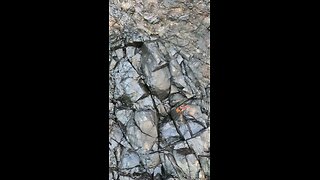 0:49
0:49
RyanzRocks
14 hours agoBeverly Beach Cliff Side!
17 -
 2:57:33
2:57:33
TimcastIRL
10 hours agoTrump Tariffs Spark Global PANIC, Countries BEG Trump, CAVE To His Demands | Timcast IRL
238K242 -
 1:37:16
1:37:16
Roseanne Barr
12 hours ago $33.66 earnedThe Man Who Saved America | The Roseanne Barr Podcast #93
105K69 -
 10:49:37
10:49:37
Dr Disrespect
19 hours ago🔴LIVE - DR DISRESPECT - WARZONE - OG VERDANSK
253K29 -
 16:38
16:38
T-SPLY
15 hours agoDemocrats Are At President Trump For "Liberation Day"
43K32 -
 2:53:20
2:53:20
vivafrei
14 hours agoModerating Debate on Syria - Roy Gutman vs. Scott Horton - Regime Change Good or Bad?
183K15 -
 1:04:37
1:04:37
Man in America
15 hours agoCHEMTRAIL WARFARE: Tom Renz Exposes the Military’s SECRET Chemical Attacks on Americans
45.9K42 -
 2:09:33
2:09:33
Precision Rifle Network
1 day agoS4E11 Guns & Grub Live - Playing World Of Tanks!
28.7K3 -
 59:19
59:19
AlaskanBallistics
19 hours ago $0.58 earnedI Love this Gun PodCast # 24
20.2K -
 1:40:29
1:40:29
Slightly Offensive
10 hours ago $7.38 earnedWhite Boy MURDERED: What is the REAL REASON Behind BLACK VIOLENCE? | Nightly Offensive
34.4K37
